Introduction
In an age where efficiency is paramount, mastering the task capture process has emerged as a crucial step for organizations striving to embrace automation successfully. By meticulously documenting and analyzing business processes, companies can uncover inefficiencies that hinder productivity and identify opportunities for innovative solutions like Robotic Process Automation (RPA).
With a growing number of businesses recognizing the transformative potential of automation—evidenced by significant reductions in errors and accelerated workflows—it’s clear that the journey toward operational excellence begins with a comprehensive understanding of task capture.
This article delves into effective strategies and best practices that empower organizations to optimize their automation efforts, ensuring they not only enhance efficiency but also position themselves for future growth in an increasingly competitive landscape.
Understanding the Task Capture Process for Effective Automation
The process of task capture download is an essential element in the journey toward effective mechanization, encompassing the documentation and analysis of each step in a business process. This meticulous approach not only allows organizations to pinpoint bottlenecks and repetitive activities but also recognizes inefficiencies that can be effectively tackled through innovative solutions like graphical user interface enhancements. A recent case study involving a mid-sized healthcare company illustrates this; they faced significant challenges such as manual data entry errors and slow software testing, but experienced a remarkable 70% reduction in data entry errors and a 50% acceleration in software testing by adopting graphical user interface techniques.
Research indicates that employees in the IT industry can save between 10% to 50% of their time by automating these repetitive activities, underscoring the potential for significant productivity gains. For example, companies may discover that their invoice handling requires many manual steps, which could be improved using robotic techniques like EMMA RPA and Microsoft Power Automate. By carefully outlining these activities, organizations can ensure their strategies are not only focused but also effective, ultimately leading to increased operational efficiency.
Moreover, the implementation of mechanization is gaining traction; currently, nearly 37% of businesses report lacking the technology necessary to streamline and organize their onboarding processes. This gap offers a notable chance for leaders to improve their operations through efficient task capture download and mechanization. As emphasized by Tidio, almost 70% of recruiters acknowledge AI as an essential resource for removing unconscious bias in hiring, illustrating the wider consequences of adopting technology across different functions.
Notably, 25% of companies have already embraced HR technology for essential tasks like screening resumes and scheduling interviews, allowing HR professionals to redirect their focus towards employee development. Moreover, staying updated on the latest trends in robotic task management is essential, as these advancements persist in evolving and influencing how companies function. This trend demonstrates the transformative influence of task capture download by recording business processes prior to starting initiatives, paving the way for organizations to enhance efficiency and achieve success.
Importantly, the ROI from the GUI automation implementation was achieved within six months, highlighting the effectiveness of this strategy.
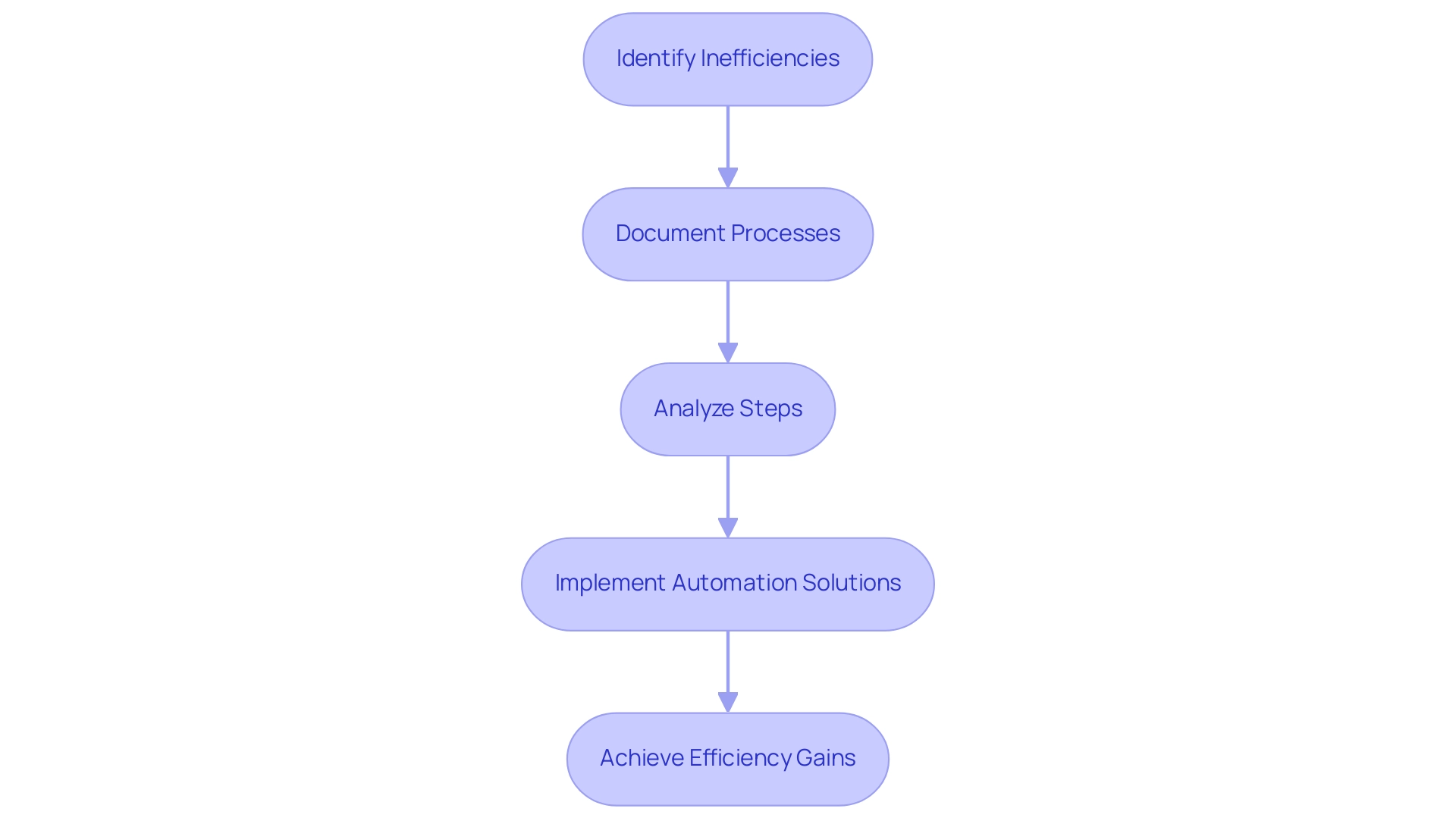
Best Practices for Optimizing Task Capture
To improve the efficiency of activity recording for task capture download, organizations should embrace several essential best practices, particularly in the context of addressing repetitive activities and obsolete systems through innovative RPA solutions. Involving stakeholders from different departments is essential, as it guarantees a diverse array of viewpoints that enhance the comprehension of activities being recorded. Recent developments reveal that 73% of enterprises have embraced a hybrid cloud approach, suggesting a transition towards collaborative settings that can greatly enhance initiative capture endeavors.
Secondly, utilizing sophisticated discovery tools, such as EMMA RPA and Microsoft Power Automate, is crucial. These tools can automatically record user interactions across applications, offering a precise representation of workflows. For instance, Ula’s implementation of such tools resulted in a remarkable 70% reduction in mundane HR activities and a decrease in Slack queries from 100% to just 1.25% between review cycles, demonstrating the power of automated insights in enhancing efficiency and employee morale.
Moreover, it is vital that the data captured is both clear and detailed. This includes documenting decision points and any potential exceptions that may arise throughout the process. As the worldwide healthcare mechanization sector is expected to increase at an impressive rate of 8.415% over the next seven years, organizations that prioritize high-quality activity recording can position themselves for success in this expanding market.
Moreover, considering that 31% of enterprises have completely streamlined at least one essential function, the task capture download becomes progressively vital in propelling efficiency initiatives. Addressing staffing shortages, RPA solutions can help streamline operations, making it easier to attract and retain talent by reducing the burden of repetitive activities. Furthermore, the emotional impact of these responsibilities on employee morale can be reduced through mechanization, enabling staff to concentrate on more engaging work.
With the North American document management software market valued at $2.79 billion, improving workflow collection methods can significantly enhance document management strategies within organizations. By adhering to these optimal methods, organizations can improve their work documentation systems, thus boosting overall operational effectiveness and facilitating future advancements in mechanization.
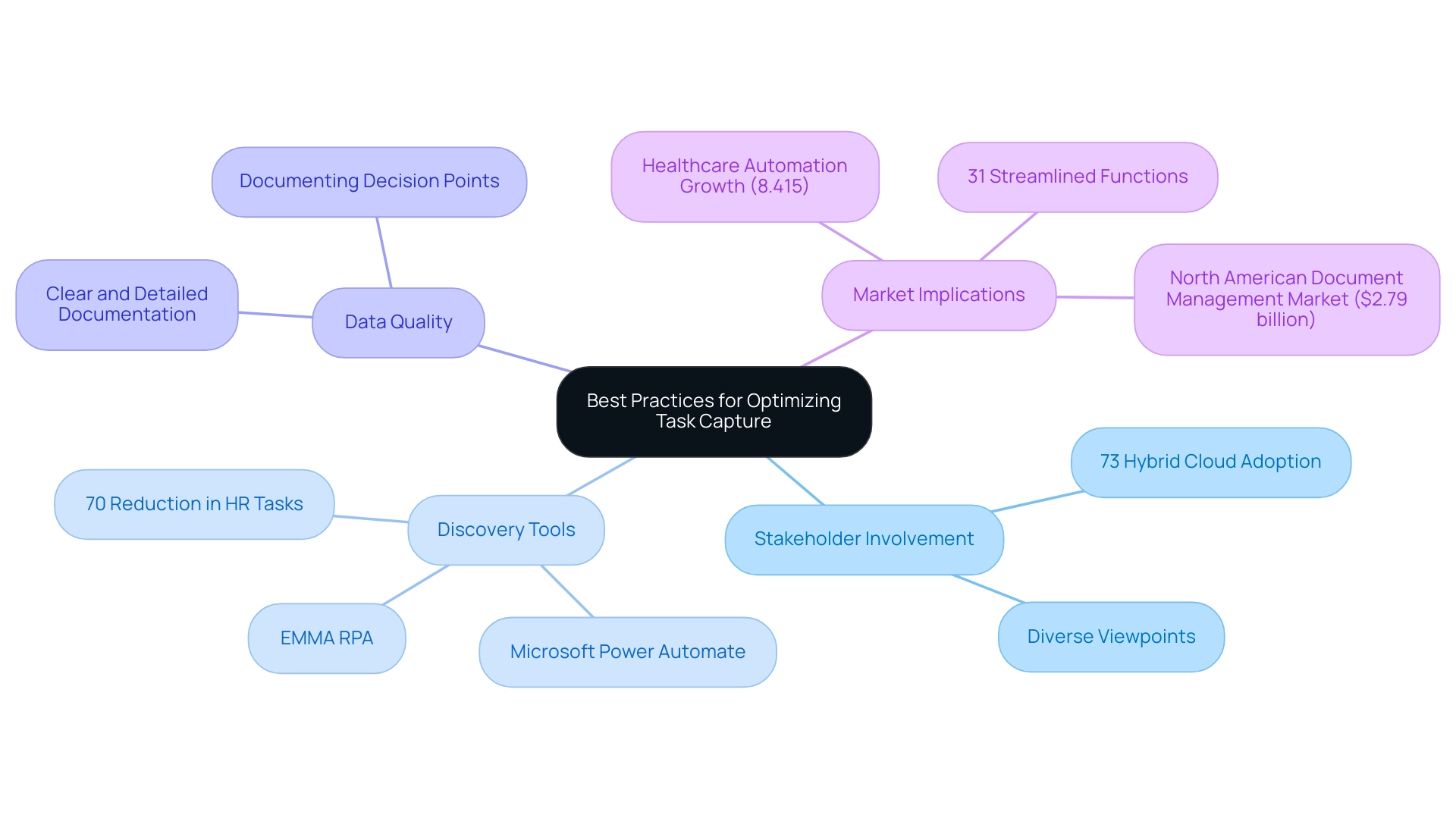
The Importance of Document Download Tracking in Task Capture
Document download tracking plays a crucial role in organizations aiming to enhance their task capture download processes, particularly in the context of improving operational efficiency in healthcare. By meticulously monitoring which documents are downloaded and by whom, companies can glean valuable insights into user behavior and identify frequently accessed resources. For example, if a particular document is frequently downloaded before performing the work, it may indicate a shared dependency that requires mechanization or simplification.
This understanding is particularly timely, as:
- 27% of businesses cite spiraling costs as a significant barrier to implementing paperless office tools
- 41% of small businesses face skills shortages that complicate the adoption of effective document tracking systems
The ongoing evolution of these systems presents both opportunities and challenges, particularly concerning data privacy and cybersecurity risks. As document tracking becomes more interconnected and reliant on cloud infrastructure, organizations must address these challenges to ensure secure operations.
Leveraging RPA solutions like EMMA RPA and Microsoft Power Automate can transform business operations by automating repetitive tasks, ultimately enhancing efficiency and employee morale. Flexera’s discoveries show that:
- 73% of companies adopted a hybrid cloud strategy in 2023, highlighting the need for strong monitoring systems that improve visibility into operations and guide strategic choices related to efficiency opportunities
In the case study of a mid-sized company, implementing GUI mechanization led to:
- A 70% reduction in data entry mistakes
- A 50% speedup in testing activities
- An 80% enhancement in workflow efficiency, with ROI realized within six months
Initially, the company faced significant challenges, including manual data entry errors and slow software testing, which highlighted the critical need for automation. As organizations navigate these complexities, effective task capture download tracking becomes indispensable for optimizing business processes and enhancing operational efficiency.
![]()
Leveraging Tools and Technologies for Enhanced Task Capture
Organizations today can significantly enhance workflow capture and overall efficiency by leveraging innovative Robotic Process Automation (RPA) tools like EMMA RPA and Microsoft Power Automate. EMMA RPA is designed for operational efficiency, enabling seamless automatic activity recording and addressing common challenges such as repetition fatigue and outdated systems. Microsoft Power Automate transforms operations by streamlining workflows, allowing employees to focus on higher-value activities, ultimately boosting morale and productivity.
Statistics indicate that mechanization can help companies achieve a remarkable 10-30% increase in earnings, illustrating the financial advantages of adopting these technologies. Additionally, Business Process Management (BPM) tools complement RPA by mapping workflows and identifying areas for improvement. For instance, Basecamp serves as an effective project management tool that enhances team communication and integrates with various applications to optimize productivity.
By integrating RPA and BPM technologies, organizations can enhance their methods for task capture download and pave the way for comprehensive automation. As Samuli Sipilä, an RPA Business Analyst at Elisa, remarks, ‘The task capture download feature has provided us with a unified way of easily creating flowcharts to represent the high-level process flow. As a business analyst, I receive ready-to-go instructions which I then incorporate into the PDD.’
This methodology not only enhances efficiency but also empowers teams to dedicate their efforts to strategic initiatives, fostering a culture of innovation and growth. Notable ETL tools such as Airbyte and Talend further illustrate the practical uses of mechanization in activity collection, offering real-world perspectives on operational enhancement. Book a free consultation to explore how our RPA solutions can benefit your organization.
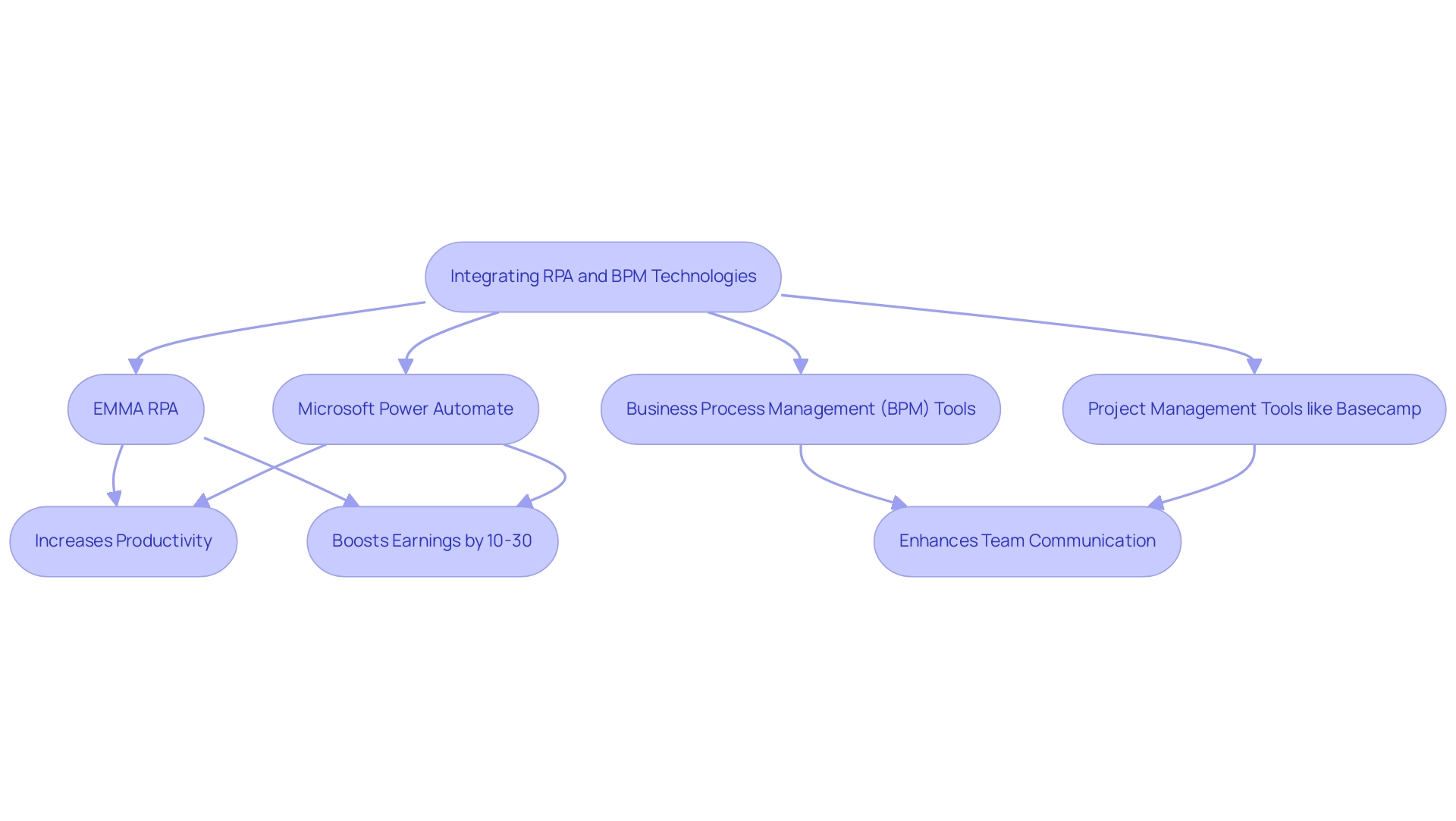
Overcoming Challenges in Task Capture Implementation
Executing project documentation poses multiple difficulties, particularly worker opposition to embracing new procedures. To tackle this, organizations must emphasize efficient communication and education regarding the advantages of project recording and mechanization. As emphasized by a recent report, 83% of employees using AI-driven tools believe it significantly reduces burnout and enhances job satisfaction, showcasing a clear advantage to embracing these technologies.
Arranging extensive training sessions, like those provided in our GenAI workshops, can further facilitate employees’ transition to new systems, enabling them to utilize activity recording effectively while ensuring ethical AI practices are followed throughout the process.
Another common challenge is maintaining data accuracy during the recording process. Organizations can mitigate this risk by conducting regular audits and actively involving team members in the verification of captured data. This collaborative approach not only boosts accuracy but also fosters a sense of ownership among employees, enhancing their engagement in the process of mechanization.
In the context of the growing trend towards mechanization, with 31% of businesses already fully implementing key functions, the market for mechanization is expanding at a remarkable rate of 20% per year. This highlights the urgency for organizations to adopt effective strategies for implementation of duties. Our case study on enhancing operational efficiency through GUI streamlining in a mid-sized company exemplifies this trend, demonstrating measurable outcomes such as a 70% reduction in data entry errors and an 80% improvement in workflow efficiency.
By proactively tackling these challenges and embracing tools like Grafana and Prometheus for observability, organizations can cultivate a culture of innovation and efficiency, positioning themselves for successful task capture download and a risk-free, ROI-driven journey. Furthermore, the integration of personalized customer experiences through our GenAI services ensures that automation not only enhances operational efficiency but also enriches customer interactions.
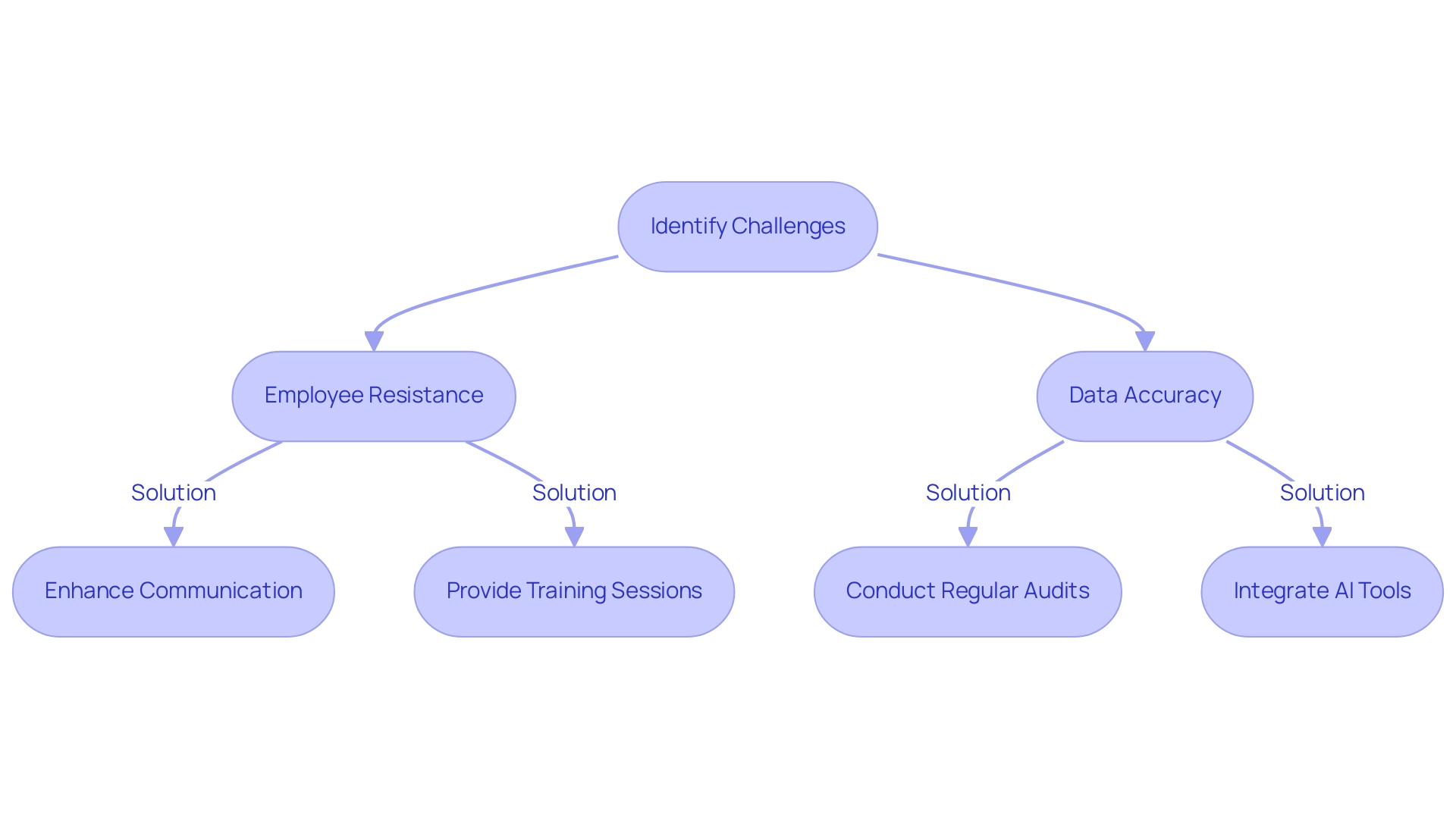
Conclusion
Mastering the task capture process is essential for organizations aiming to harness the full potential of automation. By meticulously documenting and analyzing business processes, companies can identify inefficiencies and repetitive tasks that hinder productivity. The case studies and statistics highlighted in this article demonstrate that adopting innovative solutions such as Robotic Process Automation (RPA) can lead to significant improvements, including reduced errors and accelerated workflows.
Best practices in task capture, such as engaging diverse stakeholders and utilizing advanced process discovery tools, not only enhance the accuracy of data capture but also foster a culture of collaboration and innovation. As organizations increasingly adopt automation, understanding the intricacies of their processes becomes vital for optimizing operational efficiency and positioning themselves for future growth.
Moreover, the importance of effective document tracking and leveraging the right tools cannot be overstated. These strategies not only streamline operations but also provide invaluable insights that drive informed decision-making. As the automation landscape continues to evolve, embracing these practices will empower organizations to overcome challenges and thrive in a competitive environment. In this journey toward operational excellence, organizations that prioritize task capture will find themselves well-equipped to navigate the complexities of automation, ultimately achieving a remarkable return on investment and enhanced employee satisfaction.
Introduction
In the realm of business analytics, Power BI stands out as a transformative tool that empowers organizations to visualize and share data insights like never before. As the demand for effective data management grows, so does the need for solutions that can seamlessly integrate various data sources and enhance decision-making processes.
However, many organizations encounter significant hurdles, such as:
- Data integration issues
- Security concerns
These challenges can impede their analytics efforts. This article delves into the core functionalities of Power BI, from its robust visualization tools to the intricacies of data preparation and the integration of advanced analytics through R and Python. By exploring these features, organizations can unlock the full potential of their data, turning challenges into opportunities for growth and efficiency.
Whether it’s creating compelling reports or enhancing operational workflows, mastering Power BI is essential for any organization looking to thrive in today’s data-driven landscape.
Introduction to Power BI: Understanding Its Core Functions
Power BI visualization tools serve as a leading business analytics solution designed to enable organizations to effectively visualize information and share insights across all levels. With core functionalities that encompass information preparation, modeling, and Power BI visualization tools, users can seamlessly connect to a multitude of data sources. This integration is crucial, especially as the social business intelligence market is expected to reach a remarkable $25,886.8 million by 2024.
However, organizations frequently encounter challenges in self-service business intelligence, particularly in integration and security, which represent 20% and 14% of the obstacles, respectively. To navigate these issues, our BI services offer improved reporting capabilities and actionable knowledge through features like:
- The 3-Day BI Sprint, which enables rapid creation of professionally designed reports.
- The General Management App, which provides comprehensive management tools and intelligent reviews to streamline decision-making processes.
Users can create interactive reports and dashboards with Power BI visualization tools that not only showcase information but also tell a compelling story, bolstered by built-in AI capabilities that provide deeper insights into trends and patterns.
For instance, the connected tables feature in the Power BI Datasets Add-in for Excel simplifies the process of integrating Power BI information into Excel workbooks, enhancing user-friendliness. As Kira Belova aptly states,
Embrace the power of BI with PixelPlex to transform your information into a strategic asset.
By leveraging these capabilities, organizations can effectively overcome the challenges of information integration and security, turning raw information into actionable intelligence that drives performance and enhances decision-making across the board.
Additionally, explore our Actions portfolio and book a free consultation to discover how we can tailor our solutions to meet your specific business needs.
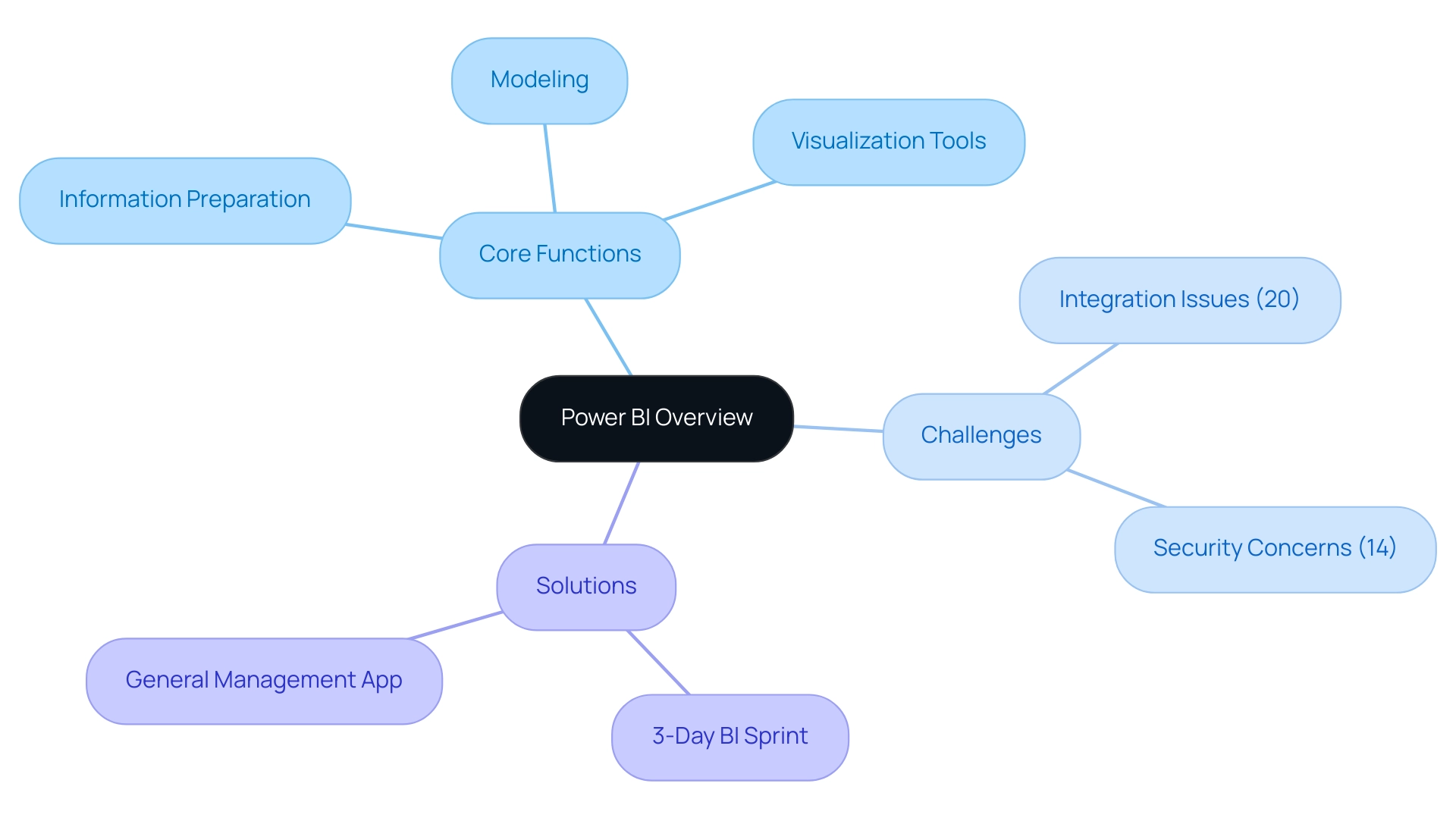
Exploring Power BI Visualization Tools: Types and Features
This software features a variety of visualization tools that are crucial for crafting interactive and insightful information presentations. Among the most popular options are:
- Bar charts
- Line graphs
- Pie charts
- Scatter plots
- Maps
Each serving distinct analytical purposes. For instance, bar charts excel at comparing quantities across categories, while line graphs effectively illustrate trends over time.
Furthermore, tables in Business Intelligence serve an essential function in presenting associated information in rows and columns, enabling quantitative comparisons and thorough analysis. However, numerous organizations encounter difficulties in utilizing information from BI dashboards, including:
- Time-consuming report generation
- Inconsistencies, which can obstruct effective decision-making
The capability to tailor visual representations with filters, slicers, and drill-through features enables users to investigate their information dynamically, revealing findings that might otherwise stay concealed.
Recent advancements in information visualization methods and the introduction of new tools in BI 2024 further enhance these capabilities. Notably, AI-driven insights are integrated, allowing for more intuitive information interpretation and helping to address issues of poor master information quality. As Ben Schneiderman aptly stated, ‘Visualization gives you answers to questions you didn’t know you had.’
Furthermore, with our 3-Day BI Sprint, organizations can quickly create professionally designed reports, while the General Management App ensures comprehensive management and smart reviews. Statistics indicate that organizations employing BI visualizations see a 30% rise in user engagement, emphasizing the effectiveness of these tools in narrative presentation. Mastering these resources, along with our GenAI Workshops and tailored Small Language Models, is crucial for anyone looking to elevate their data storytelling and engage their audience effectively.
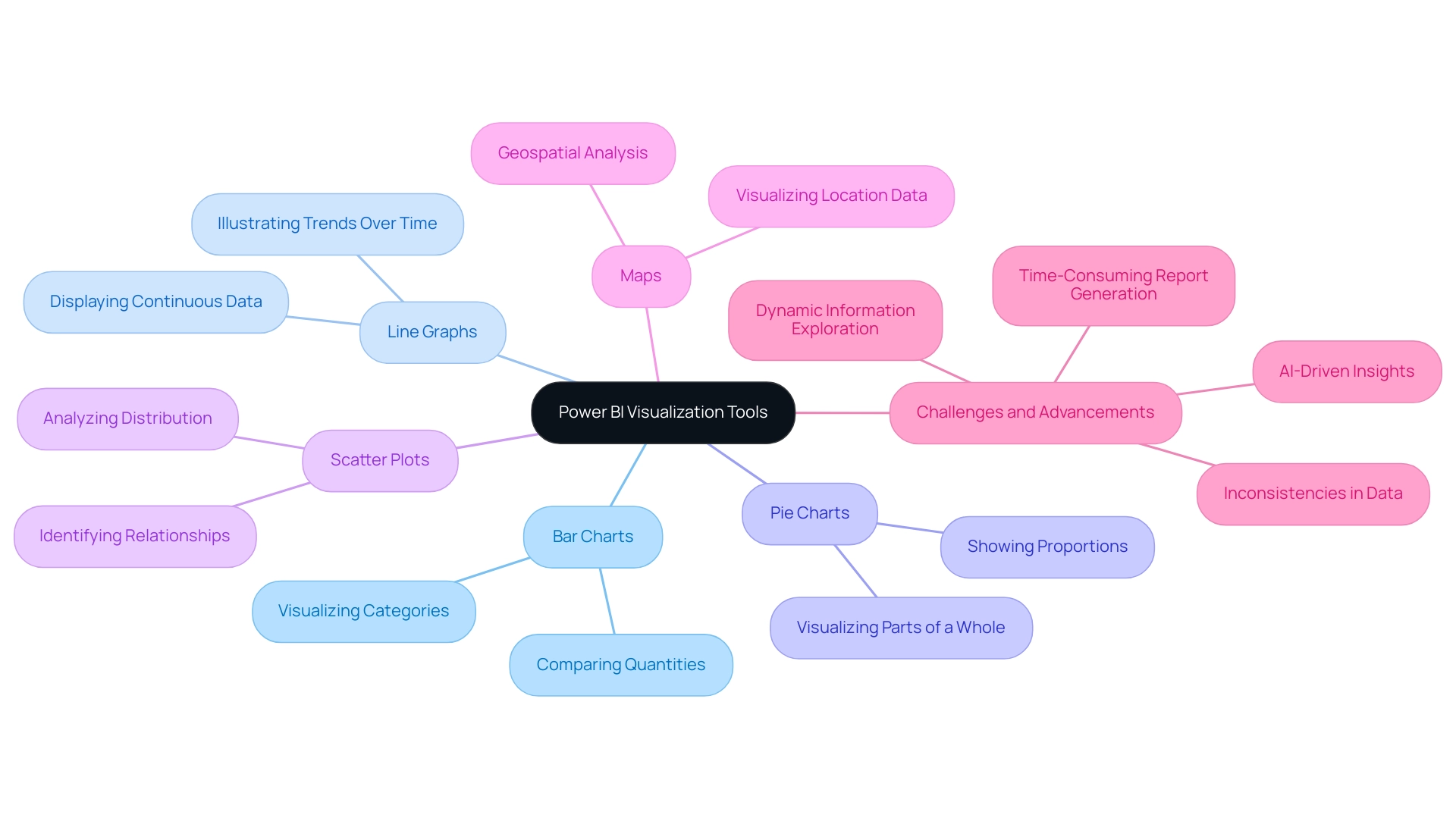
Getting Started with Power BI: Installation and Setup
To begin your BI journey, the first step is to download the latest version from the Microsoft website. The installation process is straightforward: simply follow the prompts to install the application on your device. After installation, launch BI and sign in using your Microsoft account.
If you don’t have an account yet, you will have the option to create one during the sign-in process. Once you’re logged in, take a moment to explore the interface. Familiarize yourself with key components such as the ribbon, navigation pane, and report canvas.
This foundational step will empower you to utilize the power BI visualization tools effectively and maximize their features as you start to analyze and visualize your information. In today’s competitive environment, it is essential to utilize the capabilities of Business Intelligence and RPA solutions to enhance operational efficiency and derive valuable information. Notably, as the global cloud-based BI market is projected to reach $15.2 billion by 2026, with 80% of organizations reporting enhanced scalability and flexibility in information access, and 88% of organizations using cloud-based BI reporting increased flexibility in accessing and analyzing information, there’s never been a better time to invest in mastering this powerful tool.
However, companies frequently encounter obstacles such as time-consuming report creation, data inconsistencies, and a lack of actionable guidance when utilizing insights from power bi visualization tools. By understanding and navigating these challenges, you can make the most of Bi’s capabilities. As Tajammul Pangarkar, CMO at Prudour Pvt Ltd, aptly states, ‘When he’s not ruminating about various happenings in the tech world, he can usually be found indulging in his next favorite interest – table tennis.’
This emphasizes the significance of remaining informed about tools such as BI in a constantly changing tech environment, ensuring your business can succeed amidst challenges.
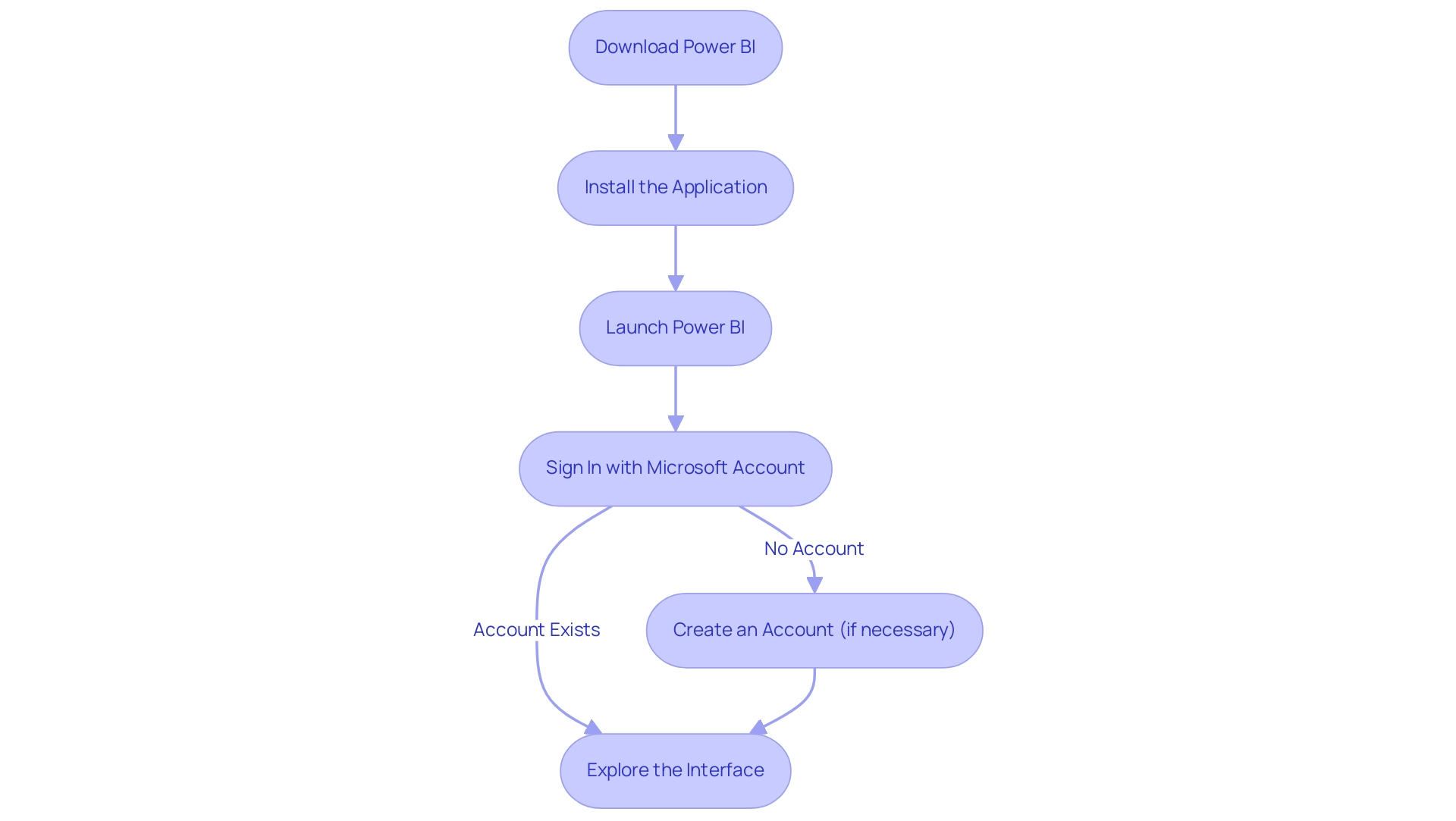
Data Preparation in Power BI: Transforming Your Data for Visualization
Effective visualization with Power BI visualization tools begins with meticulous preparation and transformation of the information at hand, a critical phase that addresses common challenges such as poor master quality and inconsistencies. This phase encompasses a variety of tasks, including:
- Cleansing
- Removal of duplicates
- Correct setting of types—ensuring dates, numbers, and other formats are accurately defined.
Notably, email or phone number fields must adhere to character limits between 3 to 128 characters, which is essential for validation.
Using the Power Query Editor is essential for executing these processes, as it enables the merging of diverse sources and the application of various transformations such as filtering and grouping. Additionally, unique identifiers can be created by adding prefixes to existing keys in the dataset, thus enhancing information management and tracking. As industry specialists highlight, the precision of visual interpretations greatly depends on the quality of the foundational information.
This highlights the significance of thorough information preparation: it not only improves the clarity and effectiveness of Power BI visualization tools, but it also ensures that the findings produced by these tools are both precise and practical. In light of the common apprehensions surrounding AI adoption, recent advancements in Business Intelligence, including the ‘New usage report on’ option, provide a fresh perspective on metrics, allowing users to access detailed insights over the past 30 days—an invaluable resource for refining strategies. Moreover, utilizing RPA tools such as EMMA RPA and Microsoft’s Automate can streamline these processes, addressing task repetition fatigue and enhancing operational efficiency.
A compelling case study involving the support for semantic model creators further illustrates the benefits of robust information preparation; it demonstrates how Power BI visualization tools streamline provisioning, reduce the workload for model creators, and maintain consistency across various models. By concentrating on these best practices for information preparation, especially in 2024, operations efficiency directors can significantly enhance their storytelling capabilities and overcome barriers to effective AI integration. As your supervisor once noted,
Orders were most likely to ship out on Tuesday,
illustrating how precise information preparation directly influences operational efficiency.
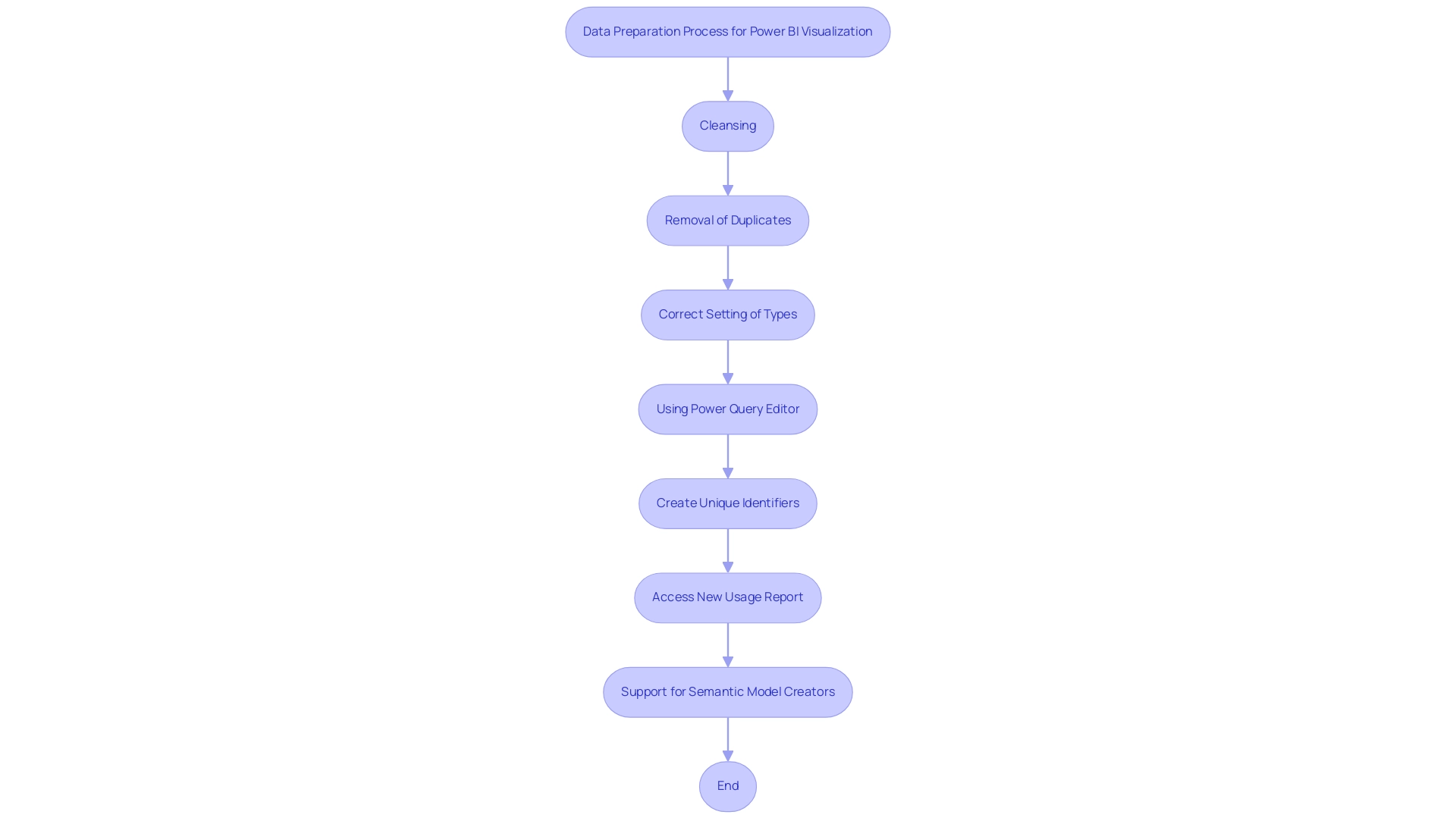
Enhancing Visualizations with R and Python Integration in Power BI
The integration of Bi’s R and Python provides users with vital Power BI visualization tools to unlock advanced analytics and create custom visualizations that enhance storytelling, ultimately leading to a deeper understanding and informed decision-making. In an era where extracting actionable insights is crucial for maintaining a competitive advantage, leveraging these languages can significantly enhance your analytical capabilities. To get started, ensure that either R or Python is installed on your machine.
Within Power BI, the R or Python visual options enable you to execute scripts directly in your reports, seamlessly merging coding capabilities with your analysis. This integration not only supports sophisticated statistical analysis and machine learning models but also enhances visualizations with Power BI visualization tools, tackling common challenges such as time-consuming report creation and inconsistencies. Additionally, our RPA solutions can complement these resources by automating repetitive tasks, further enhancing operational efficiency.
As Nirupama Srinivasan points out, R and Python visual usage will not contribute towards your Microsoft Fabric capacity usage for the first month, making it an ideal time to explore these options. For example, a fundamental Python script can include importing libraries such as matplotlib and pandas, converting your information into a DataFrame, and generating a scatter plot to illustrate relationships within your information. A case study on the integration of R and Python in Business Intelligence shows that organizations employing these resources reported a 30% increase in analytical efficiency and a significant enhancement in decision-making speed.
By utilizing these potent resources alongside RPA solutions, users can significantly improve their analysis and presentation abilities through Power BI visualization tools, tackling the challenges of today’s information-rich environment and advancing their Power BI expertise to new levels. Furthermore, recent statistics suggest that user adoption rates of R and Python in Power BI visualization tools are expected to rise by 20% in 2024, underscoring the growing importance of these languages in the analytics landscape. To learn more about how our solutions can benefit your organization, book a free consultation today.
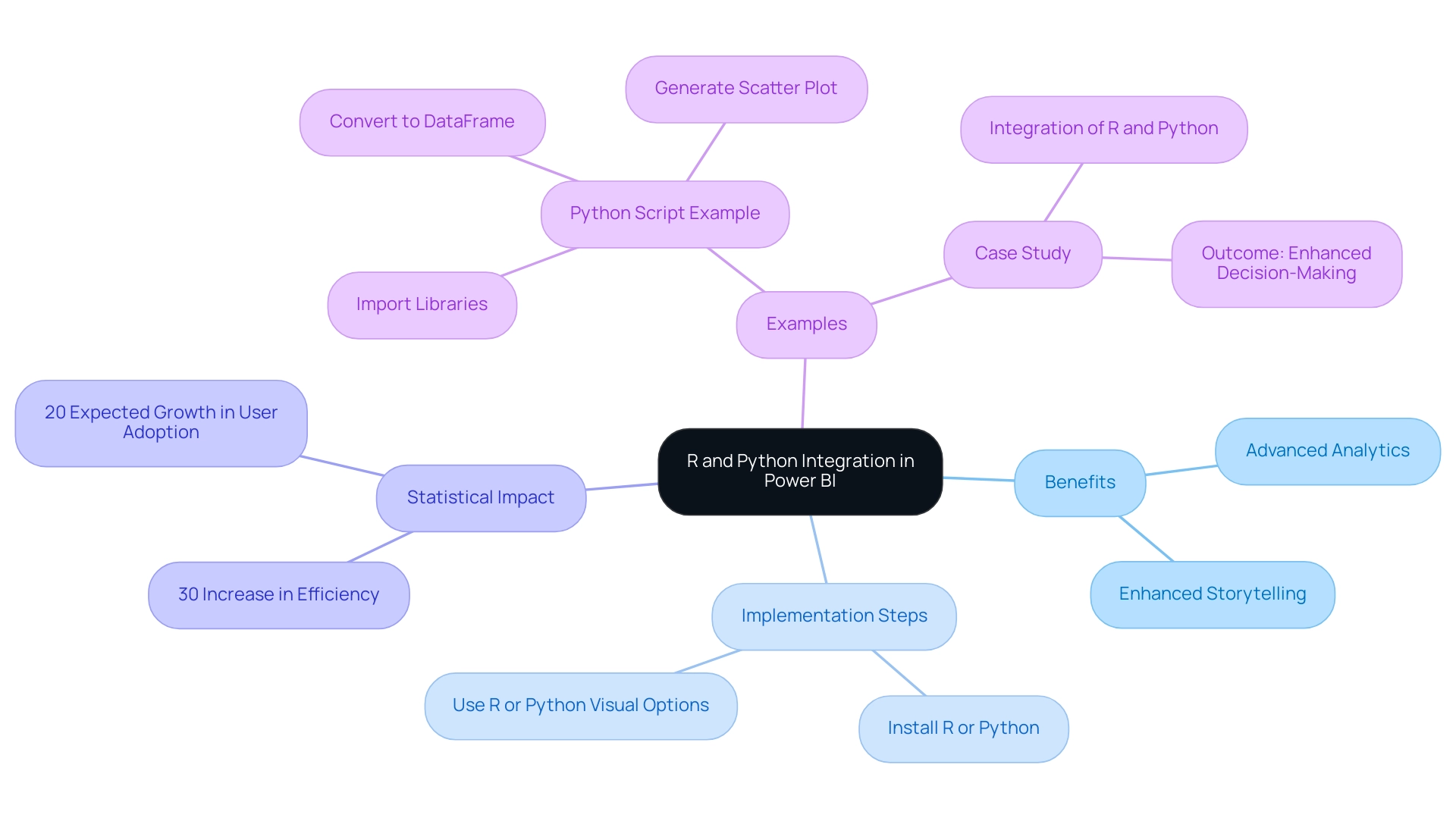
Conclusion
Power BI represents a pivotal advancement in business analytics, enabling organizations to transform raw data into actionable insights through robust visualization and data integration capabilities. As explored in this article, the platform’s core functionalities—from data preparation and modeling to advanced analytics with R and Python—equip users to navigate common challenges such as data integration issues and security concerns. By leveraging these features, businesses can enhance their decision-making processes and foster a culture of data-driven insights.
The diverse visualization tools available in Power BI, including bar charts, line graphs, and AI-driven insights, empower users to create compelling narratives around their data. This capability not only improves user engagement but also facilitates a deeper understanding of trends and patterns. Moreover, the integration of R and Python further elevates analytical capabilities, allowing for sophisticated statistical modeling and custom visualizations that can lead to improved operational efficiency.
In conclusion, mastering Power BI is essential for organizations striving to thrive in today’s competitive landscape. By investing time in understanding its functionalities and overcoming initial hurdles, businesses can turn their data into a strategic asset that drives performance and innovation. Embracing the full potential of Power BI not only addresses current challenges but also positions organizations for future growth and success in an increasingly data-centric world.
Introduction
In a world where data is the new currency, advanced analytics is emerging as a game-changer for organizations seeking to unlock their full potential. By employing sophisticated techniques such as predictive modeling and machine learning, businesses can transform raw data into strategic insights that inform decision-making and drive operational efficiency. As 2024 approaches, the urgency to harness these capabilities has never been greater.
With the advent of technologies like Small Language Models and Robotic Process Automation, companies are finding innovative ways to streamline processes, reduce costs, and enhance customer engagement. This article delves into the multifaceted landscape of advanced analytics, exploring its various types, real-world applications, and the benefits it offers, while also addressing the challenges organizations face in its implementation.
Embracing these advancements isn’t just beneficial; it’s essential for staying competitive in an increasingly data-driven marketplace.
Understanding Advanced Analytics: Definition and Importance
Advanced data analysis represents a transformative approach that utilizes various types of advanced analytics and tools to extract insights from data beyond traditional methods. This encompasses types of advanced analytics, including a variety of statistical, predictive, and machine learning techniques, enabling entities to uncover deeper insights and make more informed decisions. The importance of types of advanced analytics is underscored by their capacity to enhance decision-making processes, streamline operations, and reveal new growth opportunities.
As we near 2024, the significance of types of advanced analytics in commerce cannot be exaggerated; they allow organizations to utilize their information effectively, transforming raw details into actionable insights that enhance operational efficiency and competitive edge. Significantly, Gartner predicts that by the end of this year, 60% of the information used by AI and analytical solutions will comprise synthetic content, emphasizing a paradigm shift in information management. The introduction of Small Language Models (SLMs) is a perfect example of how organizations can achieve efficient, secure, and cost-effective data analysis, tailored to specific industry needs.
SLMs can specifically address the common perception of AI projects being costly and time-intensive by requiring less computational power and enabling quicker implementation compared to larger models. Furthermore, Alteryx’s integration of generative AI features, including ‘Magic Documents’ for summarizing insights and an OpenAI connector for generating reports, illustrates the ongoing evolution of data analysis capabilities. As Josh Howarth points out, the business intelligence sector, which includes various types of advanced analytics, is expected to hit $54.27 billion by 2030, indicating the increasing acknowledgment of advanced data analysis as an essential element in business strategy.
Moreover, utilizing Robotic Process Automation (RPA) enables entities to automate manual workflows, significantly enhancing operational efficiency in a rapidly evolving AI landscape. RPA can help alleviate the burden of repetitive tasks, further countering the perception that AI is too complex or resource-heavy to implement. Real-time predictive insights further enhance agility and customer involvement, allowing entities to make prompt data-driven choices.
For instance, Delta Airlines invested over $100 million in a business intelligence platform to enhance baggage handling processes, effectively reducing customer stress associated with delays. This case illustrates how various types of advanced analytics, combined with SLMs and RPA, can significantly enhance operational results and marketing approaches, making it essential for enterprises aiming to succeed in today’s data-driven environment. Book a complimentary consultation to explore how our customized AI solutions can assist your entity in navigating these challenges.
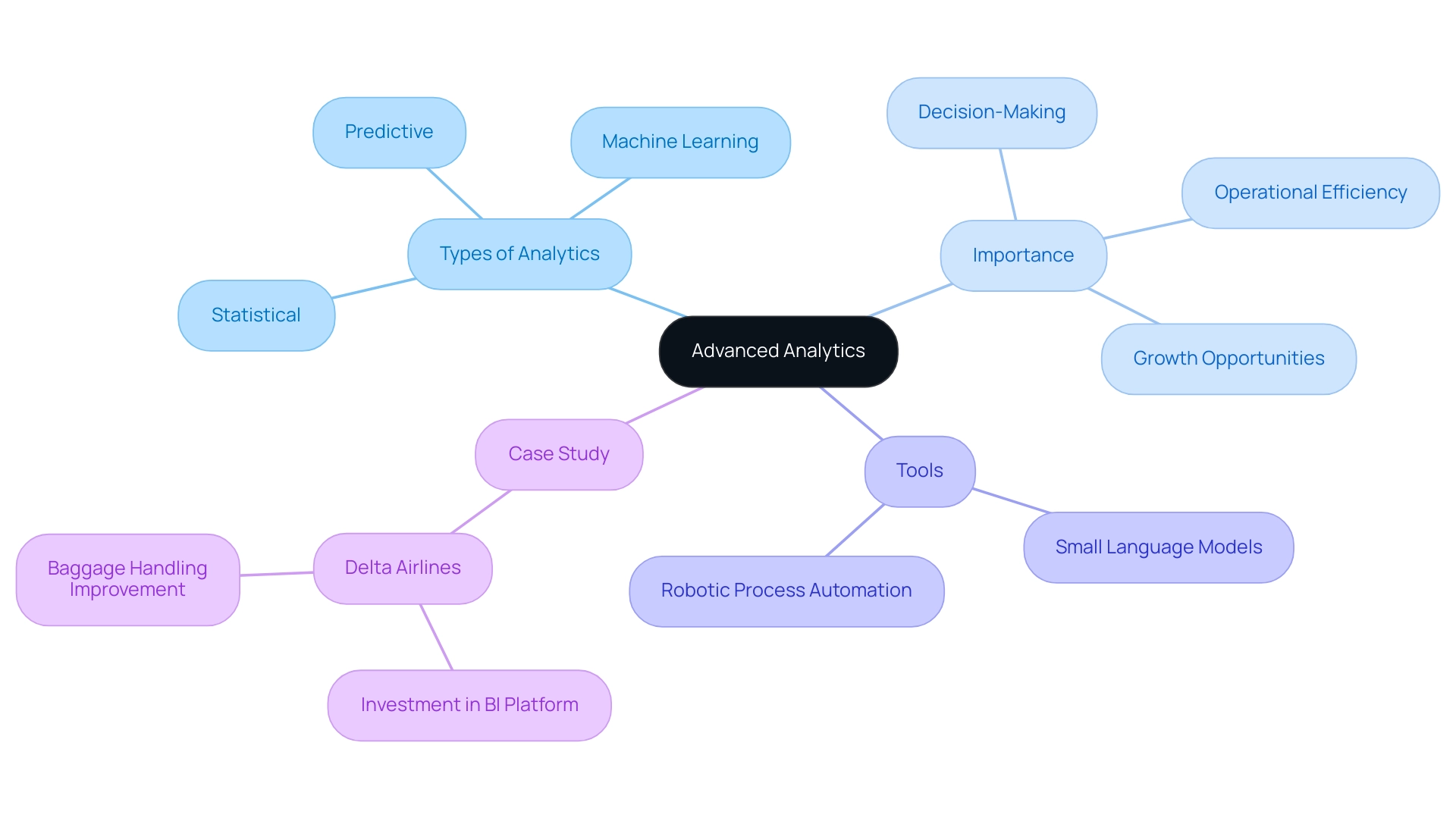
Exploring the Key Types of Advanced Analytics
The terrain of advanced analytics is varied, with several key types that organizations can utilize to gain a competitive advantage, particularly in the manufacturing sector, where the market for extensive analytics is projected to reach $4,617.78 million by 2030:
- Descriptive Analytics: This foundational type employs historical information to clarify past events. By employing aggregation and mining techniques, it provides insights that assist businesses in understanding trends and patterns over time. RPA can improve descriptive analysis by automating information collection processes, minimizing errors and freeing up resources for more in-depth examination.
- Diagnostic Analytics: Building on descriptive analytics, this type delves deeper to uncover the reasons behind specific outcomes. Through information correlation and statistical analysis, it reveals relationships between variables, enabling organizations to identify root causes of issues. RPA can streamline this process by automating the extraction and correlation of pertinent information, making it easier to identify underlying issues.
- Predictive Analysis: Employing statistical models and machine learning, predictive analysis anticipates future occurrences based on past information. This type is particularly beneficial for risk management and resource allocation, allowing companies to anticipate challenges and make informed decisions. RPA supports predictive analysis by automating data preparation, ensuring that the models are fed with accurate and timely information.
- Prescriptive Analysis: Taking a proactive approach, prescriptive analysis recommends actions to achieve desired outcomes. By combining predictive analysis with optimization techniques, it provides customized recommendations that enable organizations to make data-driven decisions effectively. RPA can facilitate prescriptive analysis by automating the implementation of recommended actions, thus enhancing operational responsiveness.
- Cognitive Analysis: An emerging frontier, cognitive analysis harnesses AI and machine learning to replicate human thought processes in examining complex datasets. This innovative method enables deeper insights and more nuanced decision-making, ensuring organizations remain agile in a rapidly evolving market. RPA can improve cognitive insights by automating routine tasks, enabling human analysts to concentrate on more intricate analytical processes.
In addition to these types of advanced analytics, Robotic Process Automation (RPA) solutions play a vital role in boosting operational efficiency. By automating manual workflows, RPA reduces errors and addresses task repetition fatigue, freeing up team members for more strategic tasks. Instruments such as EMMA RPA and Microsoft Power Automate illustrate how companies can enhance operations while elevating employee morale and tackling staffing shortages.
Significantly, 54% of firms are contemplating the adoption of cloud and business intelligence (BI) in their information analysis efforts, as emphasized by industry leaders like IBM and Microsoft. Moreover, a case study from the insurance and telecommunications sectors demonstrates that organizations are increasingly utilizing an average of 11.4 cloud services, showcasing a growing reliance on advanced data analysis and RPA to enhance operational efficiency.
Each of these types of data analysis, coupled with the strategic implementation of RPA, is crucial for organizations aiming to harness information effectively, driving efficiency and innovation in their operations.

Real-World Applications of Advanced Analytics in Business
The types of advanced analytics, combined with Robotic Process Automation (RPA) and tailored AI solutions, are revolutionizing decision-making processes and operational efficiency across various sectors. In retail, for example, companies like Amazon illustrate the strength of predictive data analysis by accurately forecasting demand, optimizing inventory levels, and personalizing the shopping experience for customers. The LEAFIO AI Retail Platform further illustrates this trend, enabling retailers to produce over 40 detailed analysis reports.
These insights empower businesses to make informed layout changes and assortment rotation decisions, ultimately driving sales growth and improving customer retention. Retailers are encouraged to schedule consultations to investigate how information analysis can enhance their operations. In the healthcare sector, organizations utilize diagnostic analysis alongside RPA to uncover patterns in patient data, resulting in improved treatment outcomes and streamlined operational workflows.
Experts in healthcare emphasize that every interaction and transaction is an opportunity to glean insights, as stated by Muhammad Ghulam Jillani, Senior Data Scientist and Machine Learning Engineer. RPA not only reduces errors but also frees up teams to focus on more strategic, value-adding work. Additionally, financial institutions utilize prescriptive data analysis to evaluate credit risk and refine investment strategies, enhanced by the efficiency of RPA.
By monitoring key performance indicators such as:
- Sales growth
- Customer retention
- Inventory turnover
- Cost savings
companies can assess the effect of their data analysis and automation efforts on profitability. Customized AI solutions play a crucial role in assisting organizations navigate the rapidly evolving AI landscape, ensuring that technologies align with specific objectives. These practical applications of types of advanced analytics, RPA, and Business Intelligence highlight their potential to provide substantial performance enhancements and establish a competitive advantage in various commercial settings.
To learn more about how these technologies can transform your operations, we invite you to book a consultation.
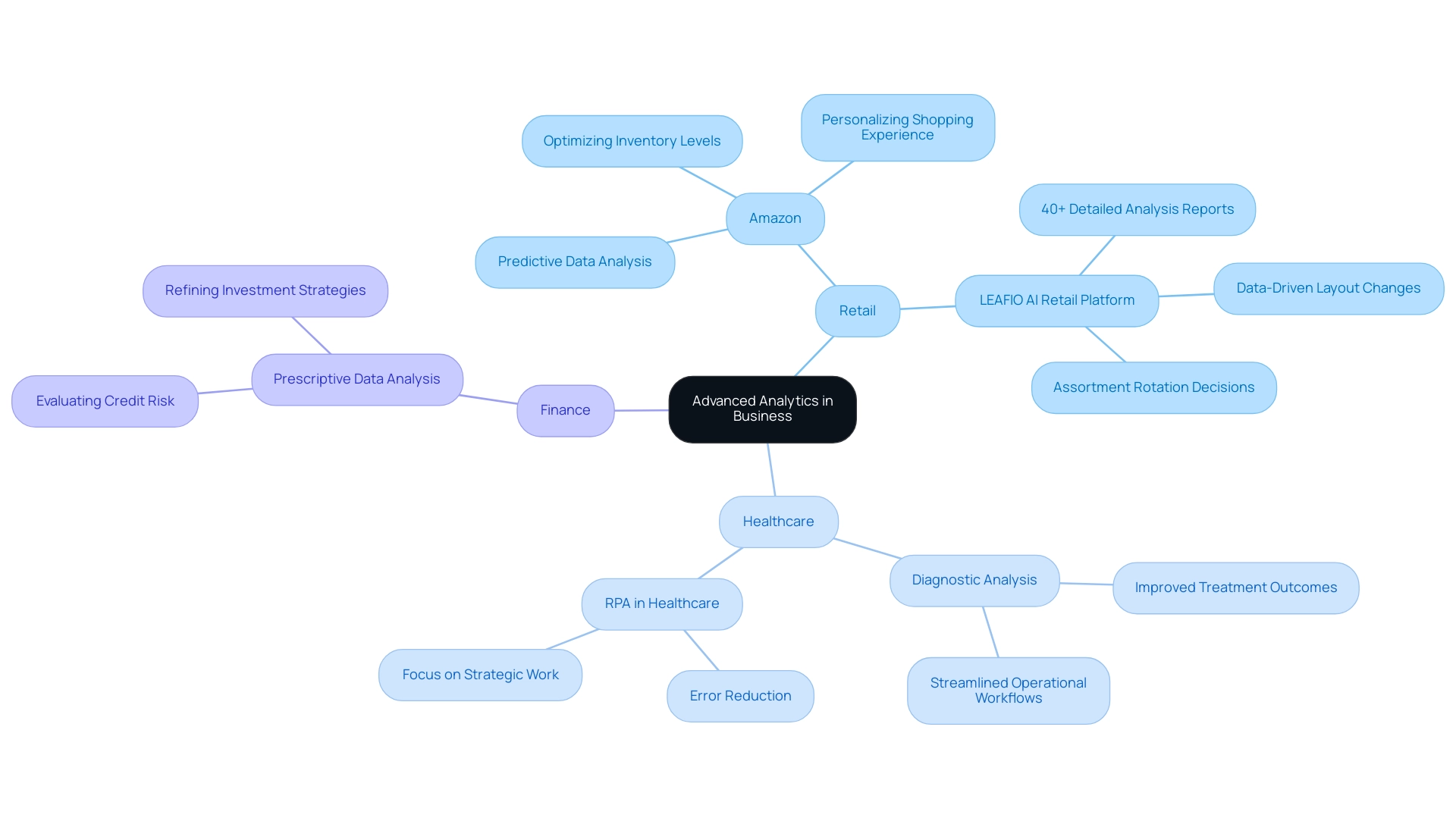
Benefits and Challenges of Implementing Advanced Analytics
The execution of types of advanced analytics, such as those provided in Creatum’s 3-Day Power BI Sprint, offers numerous benefits, including:
- Enhanced decision-making abilities
- Increased operational efficiency
- Identification of new opportunities
In just three days, we promise to create a fully functional, professionally designed report on a topic of your choice, allowing you to focus on utilizing the insights. According to a study by IBM, Microsoft, and Humans of Data, 54% of firms are contemplating the integration of cloud computing and business intelligence into their information analysis strategies, indicating a notable transition towards types of advanced analytics.
Organizations that embrace these types of advanced analytics can anticipate:
- Enhanced customer insights
- Streamlined processes
- Increased profitability
Furthermore, interactive visualization simplifies complex information into graphical representations, enabling quicker decision-making. A significant case study is SAP’s incorporation of types of advanced analytics, including predictive data analysis, into its Cloud Analytics platform, which has enabled enterprises of all sizes to leverage enhanced data interpretation and machine learning, promoting automated workflows and the extraction of valuable insights from extensive datasets.
However, entities must navigate several challenges to successfully implement these strategies. Particular challenges encountered in adopting types of advanced analytics include:
- Quality issues
- Employee resistance to change
- Need for skilled personnel
To counter these obstacles, it is crucial for organizations to cultivate a data-driven culture, invest in comprehensive employee training—including expert training from Creatum—and enforce robust data governance practices.
Additionally, our customized AI solutions can assist organizations in identifying the right technologies to align with their specific goals. By proactively tackling these challenges and utilizing RPA to automate manual workflows, businesses can unlock the full potential of types of advanced analytics, positioning themselves for greater success in a data-centric landscape.
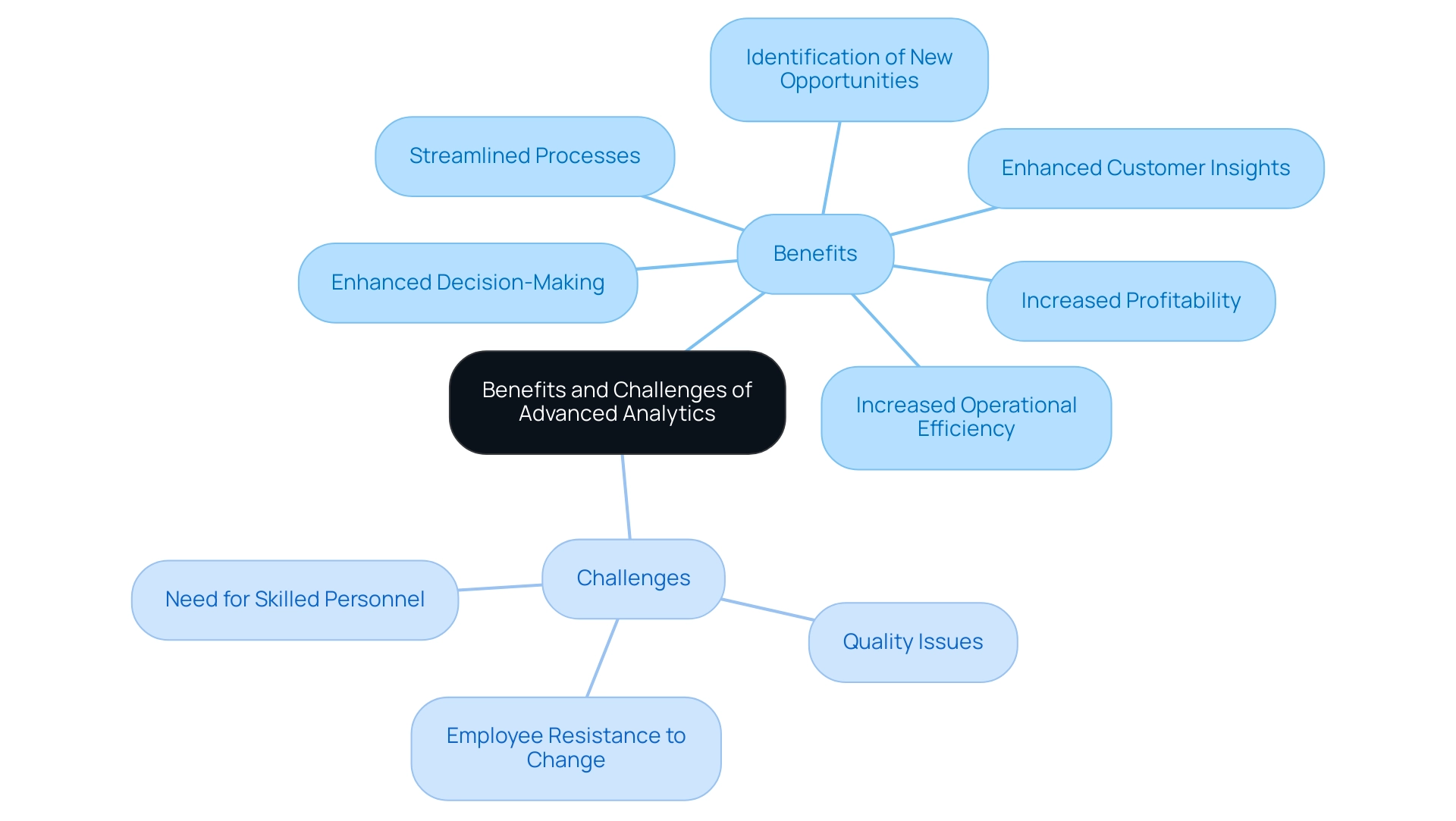
Future Trends in Advanced Analytics: AI and Beyond
The landscape of types of advanced analytics is undergoing a profound transformation, driven by the rapid adoption of AI and machine learning technologies. With projections indicating that by 2025, AI will facilitate 95% of customer interactions, organizations must urgently enhance their information management frameworks to overcome common challenges such as poor master information quality. Inconsistent, incomplete, or inaccurate information can lead to flawed decision-making and operational inefficiencies, making it crucial for companies to address these issues proactively.
As emphasized in the conversation on information management as an AI infrastructure bottleneck, tackling these issues is essential for effective AI implementation. Companies that adopt these technologies can anticipate substantial progress in automation, facilitating real-time assessments and accelerated decision-making processes. For instance, organizations can utilize Business Intelligence tools to analyze historical data trends, helping them make informed predictions about future market conditions.
Furthermore, integrating AI with types of advanced analytics will enhance predictive and prescriptive capabilities, empowering businesses to anticipate market shifts and optimize strategies proactively. The rise of self-service data tools democratizes access to insights, enabling non-technical users to engage in data-driven decision-making across all organizational levels. This democratization is essential, particularly as organizations integrate data leadership roles into broader technology functions, fostering a culture of analytics and AI.
Embracing these future trends is not just advantageous but crucial for businesses aiming to sustain a competitive edge in today’s data-centric environment.

Conclusion
Advanced analytics is no longer just an option; it has become a necessity for organizations striving to thrive in a data-driven world. By leveraging advanced techniques such as predictive modeling, machine learning, and robotic process automation, businesses can unlock valuable insights that enhance decision-making and operational efficiency. The various types of advanced analytics—from descriptive to cognitive—provide a comprehensive toolkit for organizations to understand their data, identify opportunities, and drive innovation.
Real-world applications across sectors showcase the transformative potential of these analytics. In retail and healthcare, for example, companies are harnessing advanced analytics to optimize operations, improve customer experiences, and enhance treatment outcomes. The integration of AI and RPA not only streamlines processes but also empowers teams to focus on strategic initiatives, significantly enhancing productivity.
However, the journey toward implementing advanced analytics is not without challenges. Organizations must address data quality issues, foster a culture of data-driven decision-making, and invest in employee training to fully realize the benefits. By proactively tackling these obstacles and leveraging tailored AI solutions, businesses can position themselves for success.
As we move forward, embracing the future trends in advanced analytics will be essential. With the increasing reliance on AI and self-service analytics tools, organizations must adapt their data management strategies to ensure they remain competitive. The time to act is now; harnessing the power of advanced analytics is crucial for unlocking growth, enhancing operational efficiency, and staying ahead in an ever-evolving marketplace.
Introduction
In a world where data is the new currency, mastering Power BI can be the key to unlocking unprecedented insights and driving operational success. As organizations strive to harness the power of business intelligence, the ability to visualize and share data effectively becomes paramount.
With the social business intelligence market projected to soar, understanding the intricacies of Power BI—from its essential components to advanced data modeling techniques—can empower teams to make informed decisions that propel growth.
However, many face hurdles such as:
- Time-consuming report generation
- Data inconsistencies that can stifle innovation
By embracing RPA solutions and leveraging the full capabilities of Power BI, organizations can transform their data landscape, streamline processes, and foster a culture of collaboration that ultimately leads to enhanced efficiency and success.
This article delves into the essential skills and strategies needed to navigate Power BI, ensuring that users are equipped to turn challenges into opportunities for impactful data storytelling.
Getting Started with Power BI: An Overview
This software, created by Microsoft, stands out as a strong business analytics tool that enables organizations to visualize their information and share insights throughout their teams. In a time when the social business intelligence market is anticipated to attain an impressive $25,886.8 million by 2024, the significance of effective information utilization cannot be overstated. As highlighted by Inkwood Research, the BFSI (Banking, Financial Services, and Insurance) sector is expected to experience rapid growth, driven by the consistent implementation of BI technologies that enhance operational efficiency.
However, many organizations encounter difficulties in utilizing insights from BI dashboards, including:
- Time-consuming document creation
- Data inconsistencies
- A lack of actionable guidance
For those new to BI, participating in a power bi introduction training to familiarize yourself with its interface is crucial. The platform comprises several key components:
- BI Desktop for report creation
- The BI Service for sharing and collaboration
- Mobile applications that enable users to access reports on-the-go
This foundational understanding of BI’s components will enable you to navigate the platform with confidence and overcome the hurdles of outdated tools and fear of new technology adoption. By mastering BI and integrating RPA solutions like EMMA RPA, which automates repetitive tasks, and Automate, which streamlines operations, you position yourself at the forefront of this evolving market. These tools not only enhance operational efficiency but also address task repetition fatigue and staffing shortages, driving data-driven insights that fuel business growth and innovation.
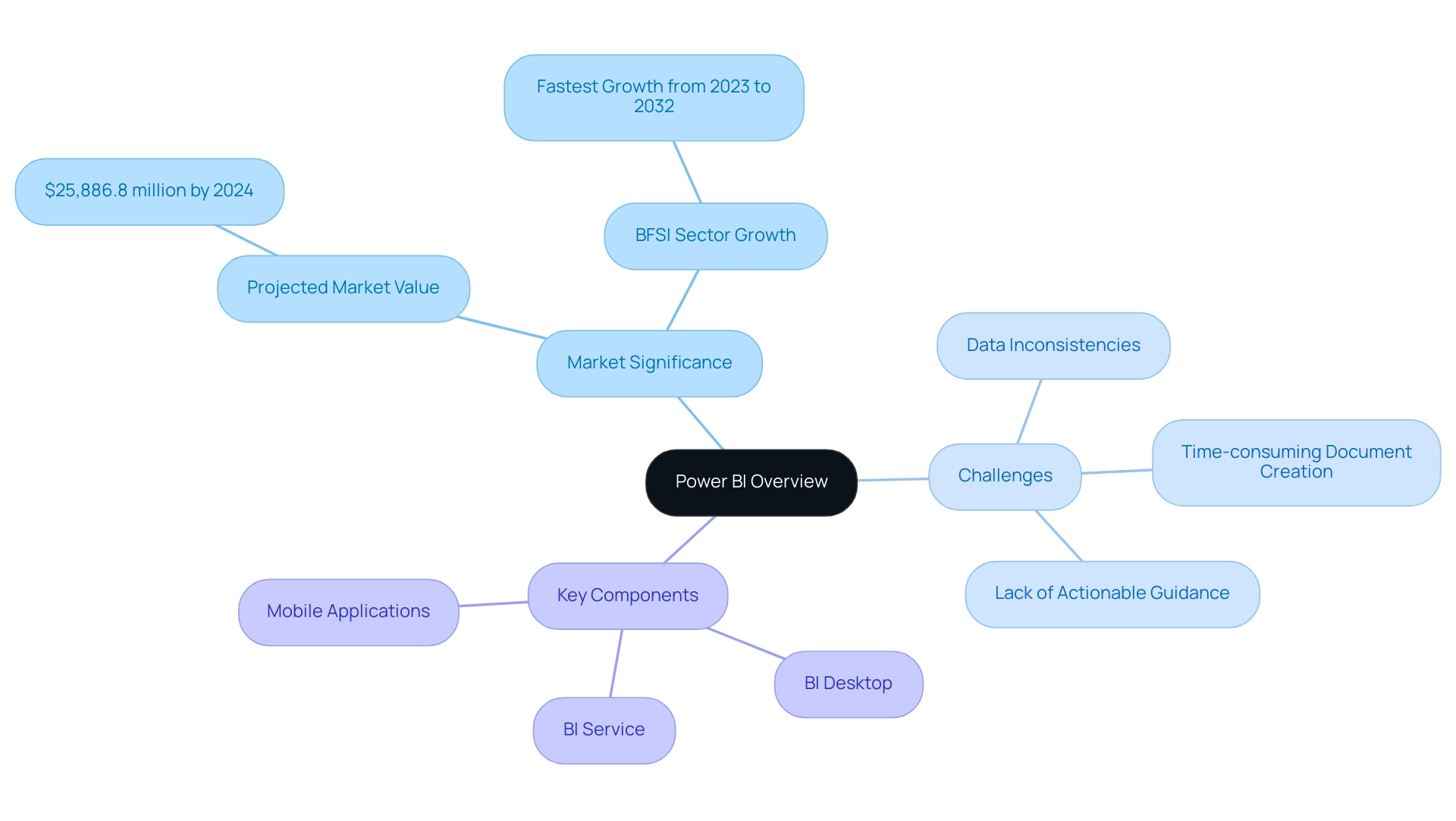
Essential Skills for Beginners: Data Visualization and Reporting in Power BI
For newcomers aiming to excel in visualization using BI tools, a Power BI introduction training is essential to cultivate a range of fundamental skills that will allow you to produce engaging charts, graphs, and dashboards. Start by importing information from diverse sources such as Excel and SQL Server into Power BI Desktop. Once your information is successfully loaded, leverage the intuitive drag-and-drop functionality to craft visual representations of it.
Get acquainted with different visual types:
– Employ bar charts for straightforward comparisons
– Use line graphs to demonstrate trends over time
– Utilize pie charts to represent proportional information effectively
Pay careful attention to the formatting options available; this will significantly enhance the readability and impact of your visualizations. The increasing enthusiasm for visualization tools is clear, as the search volume for ‘Tableau Public’ has risen by over 80% in the last five years, highlighting the significance of mastering platforms such as BI.
Key sectors such as finance, healthcare, retail, manufacturing, and transportation are increasingly utilizing large-scale information. However, numerous organizations encounter difficulties in utilizing insights from BI dashboards, including time-consuming creation of documents and inconsistencies in information. Integrating RPA solutions like EMMA RPA and Automate can streamline these processes, allowing for more efficient reporting and enhanced operational efficiency.
Thus, comprehending how to efficiently present and visualize information through Power BI introduction training can enable you to create meaningful documents that not only communicate your information narrative but also foster informed decision-making within your organization, ultimately improving operational efficiency through effective BI and RPA strategies.
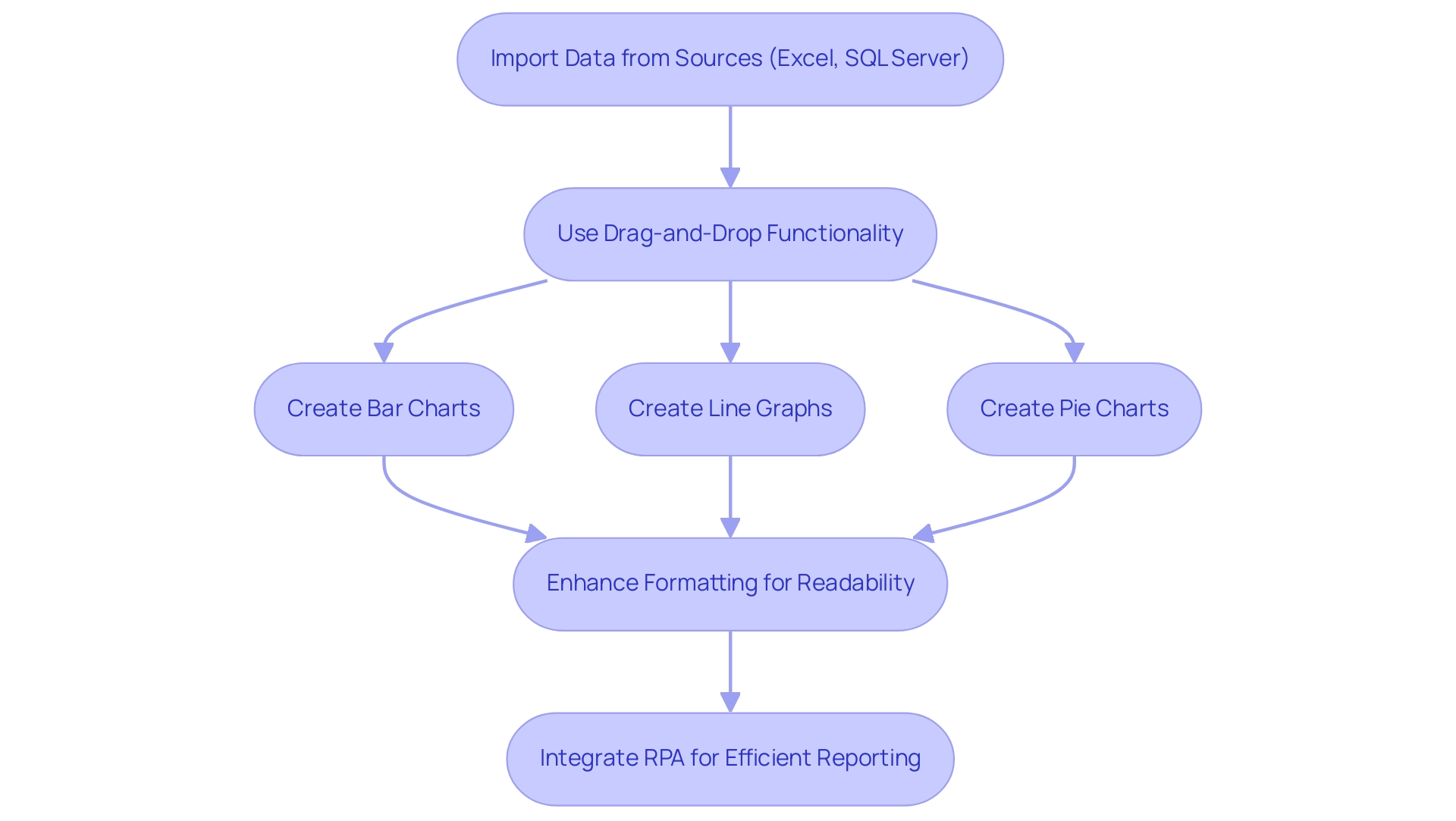
Exploring Power BI’s Data Modeling Capabilities
Efficient information modeling in BI is a crucial element for creating insightful reports, as it entails establishing connections among various tables. To start, import all pertinent information sources into BI and switch to the ‘Model’ view in BI Desktop. From there, you can easily define relationships by dragging and dropping fields between tables.
A thorough understanding of cardinality—whether one-to-one or one-to-many—is essential for accurately setting up these relationships. As Juan Sequeda, a principal scientist and head of the AI Lab at data.world, notes,
Knowledge graphs simplify complex concepts at one glance by giving rich, meaningful context and connections between datasets.
This emphasizes the significance of a well-organized information model; without it, organizations risk creating systems that fail to meet customer needs.
In today’s data-rich environment, struggling to extract meaningful insights can leave your business at a competitive disadvantage. Utilizing the capabilities of Business Intelligence and RPA solutions, like EMMA RPA and Power Automate, can convert raw information into actionable insights, facilitating informed decision-making that promotes growth and innovation. For instance, the network information model represents information in a complex network-like structure, allowing multiple parent-child relationships, often used for modeling intricate information relationships.
By investing time in creating a solid information model, you can ensure that your visualizations yield precise and meaningful insights, ultimately facilitating more informed decision-making. Recent statistics indicate that 55% of data engineers face challenges when incorporating various formats into cohesive models, underscoring the necessity of robust connections in BI. Additionally, organizations face challenges like task repetition fatigue and staffing shortages, which RPA solutions can effectively address by automating repetitive tasks and streamlining operations.
Furthermore, as we approach 2024, the importance of information governance and ethical information handling practices becomes increasingly vital, shaping the landscape of modeling in BI and ensuring systems are constructed with compliance and responsibility in mind.
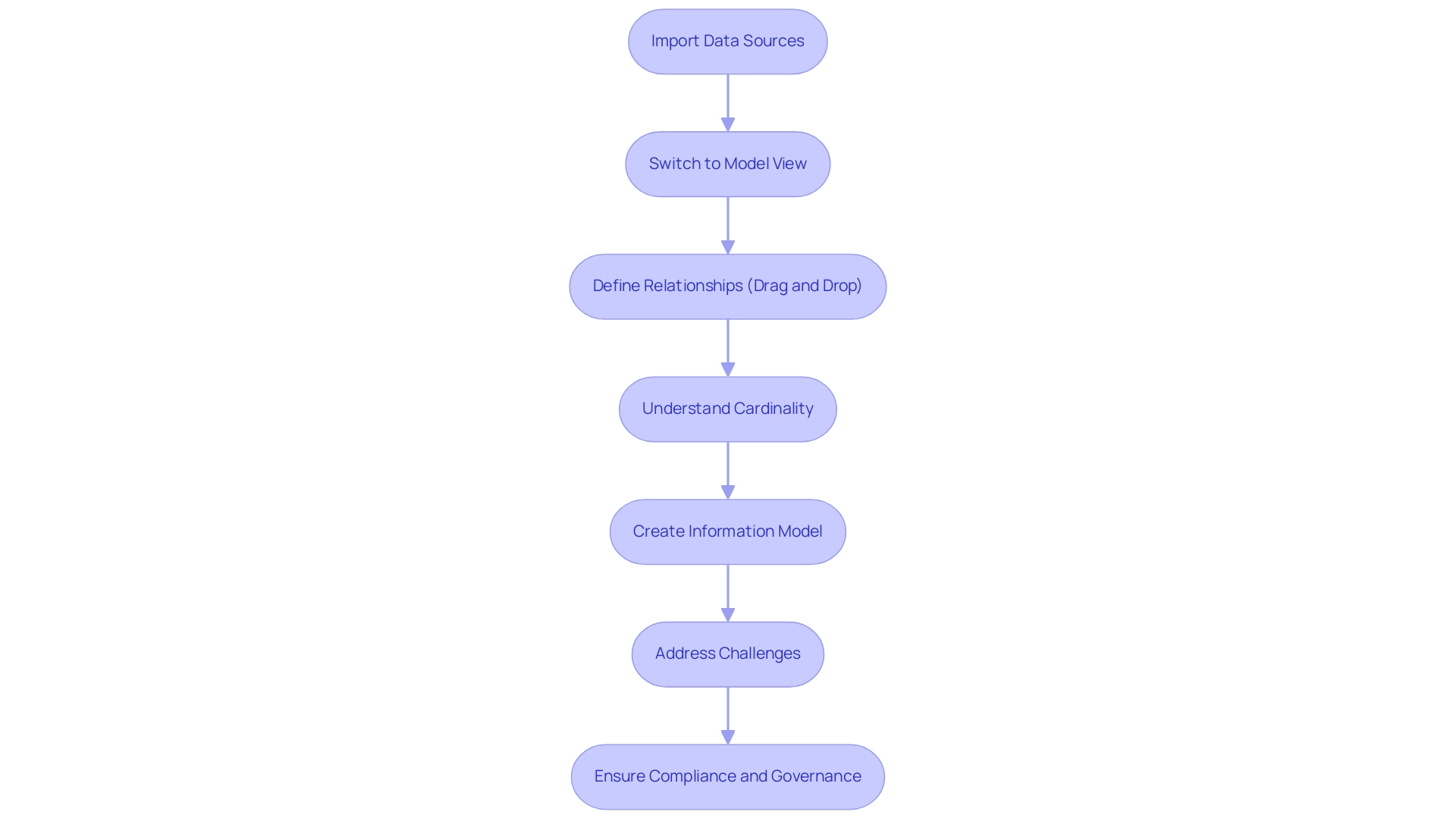
Creating Interactive Dashboards
Participating in power bi introduction training enables you to create interactive displays in Power BI, providing a powerful way to convey your insights effectively. However, challenges such as time-consuming document creation and information inconsistencies can hinder the process of extracting actionable insights. To overcome these hurdles, once your reports are prepared, you can easily attach visualizations to a panel by selecting the pin icon on the desired visuals and choosing the appropriate panel.
As you create your display, prioritize a thoughtful layout by:
- Grouping related visuals
- Utilizing tiles to distinctly separate various information categories
This approach not only enhances clarity but also ensures that the dashboard remains relevant to different user roles, spotlighting the metrics that matter most. To encourage interactivity, utilize features such as slicers and filters, allowing users to examine the information in greater depth.
Furthermore, incorporating Robotic Process Automation (RPA) can simplify repetitive tasks linked to preparation, significantly decreasing the time required for report generation and minimizing inconsistencies. As highlighted by ThoughtSpot, ‘AI-Powered Analytics allows everyone to create personalized insights to drive decisions and take action.’ A well-structured interface, combined with RPA, can convert intricate information into easily understandable insights, aiding informed decision-making for stakeholders at a glance.
In 2024, the emphasis on interactive displays will be crucial as organizations transition from data secrecy to a culture of openness, enhancing collaboration across all business functions. Moreover, companies implementing the AI TRiSM framework are anticipated to be 50% more successful in adoption, business objectives, and user acceptance by 2026, highlighting the significance of incorporating interactive displays and RPA into business intelligence strategies. By adopting these best practices, you can ensure that your displays, especially during the power bi introduction training, not only convey insights but also drive meaningful actions within your organization.
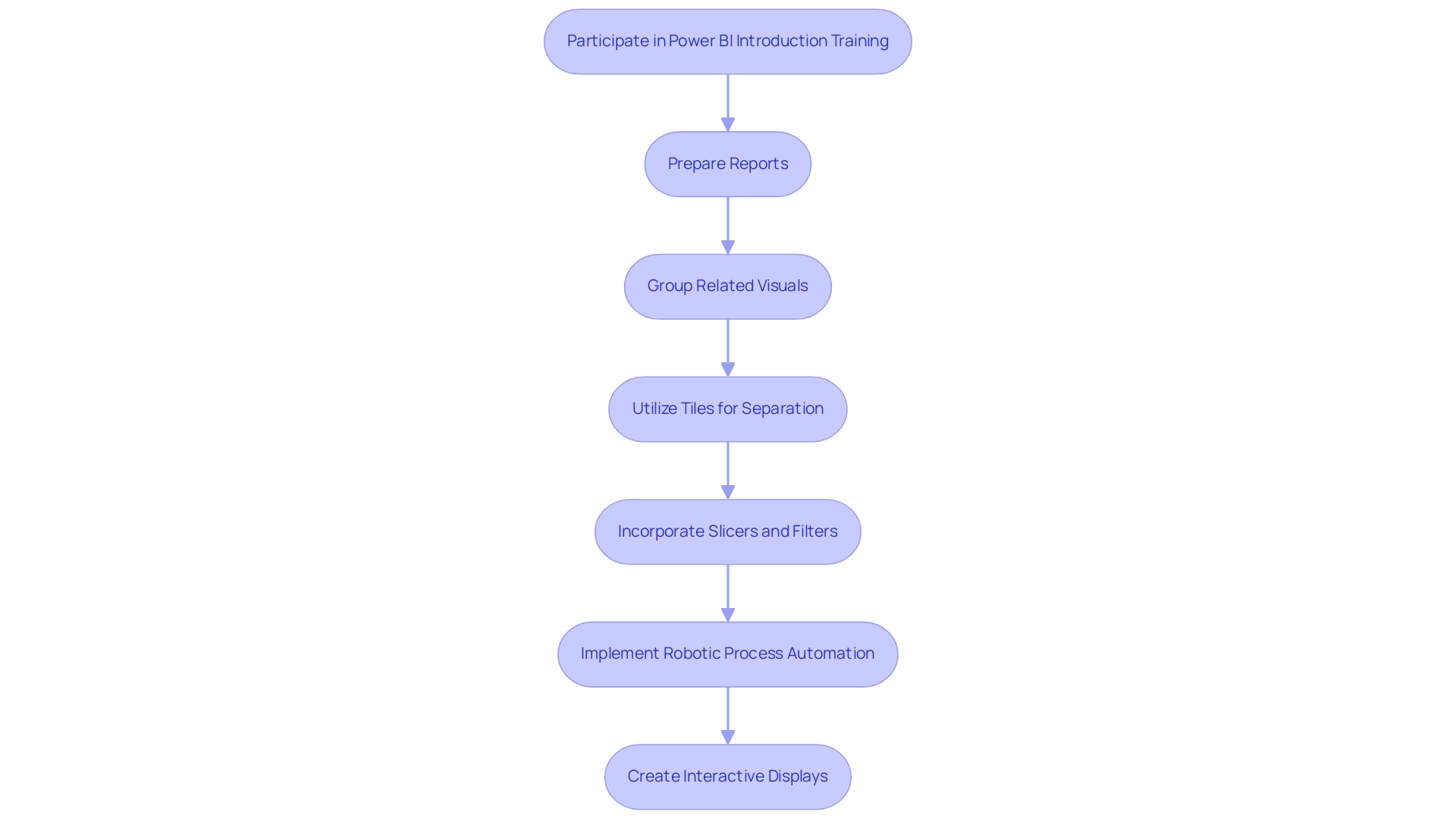
Sharing and Collaborating in Power BI
After creating insightful analyses and dashboards in BI, Power BI introduction training is crucial for effective sharing with your team and collaborative decision-making. The process is facilitated seamlessly through the Power BI introduction training. To share a document, simply click the ‘Share’ button located in the view, and input the email addresses of your colleagues.
You are also empowered to control permissions, granting either view-only access or editing rights tailored to your requirements. Utilizing workspaces during your Power BI introduction training can further enhance your workflow by organizing related reports and dashboards, thereby ensuring streamlined collaboration. As Kim Manis, Vice President of Product Management, aptly stated,
Fabric is a complete analytics platform that reshapes how your teams work with information by bringing everyone together with tools for every analytics professional.
Considering that 98% of employees voice dissatisfaction with video meetings held from home, incorporating Power BI introduction training to utilize sharing functionalities becomes even more essential. By fostering a data-driven culture within your organization through Power BI introduction training, you can significantly improve user satisfaction in remote environments, making effective collaboration tools essential. Moreover, for businesses struggling with time-consuming report creation and data inconsistencies, our 3-Day BI Sprint is designed to transform your approach, providing you with a fully functional, professionally designed report on a topic of your choice.
This not only enables actionable insights but also serves as a template for future projects, ensuring a professional design from the start. Microsoft’s recognition as a Leader in the 2024 Gartner Magic Quadrant for Analytics and Business Intelligence Platforms underscores the reliability of BI as a leading solution in this field. For assistance with Power BI, please contact +1 281 899 0865 or email arish.siddiqui@dynamicssquare.com.
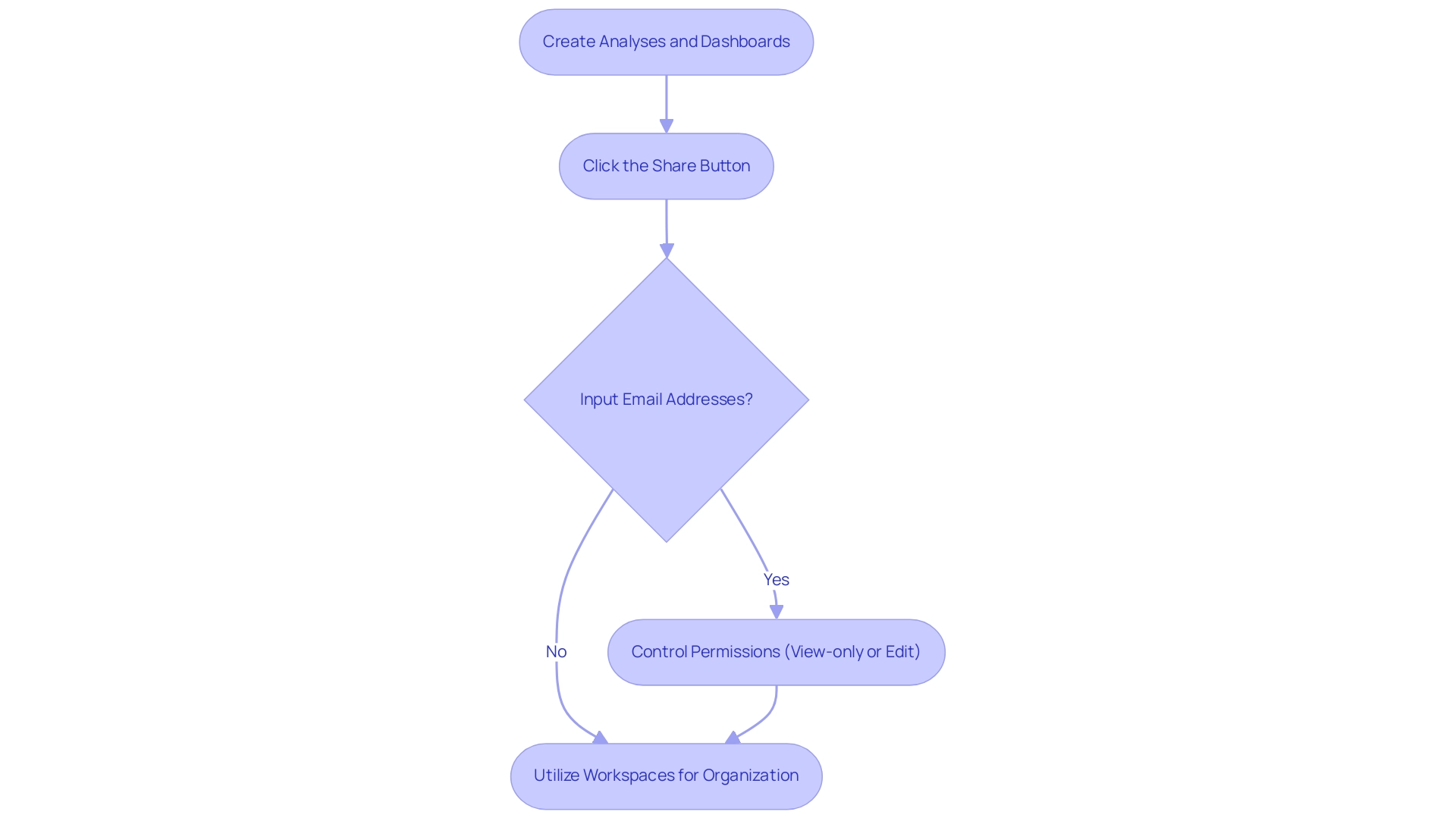
Conclusion
Harnessing the full potential of Power BI is essential for organizations seeking to thrive in today’s data-driven landscape. By mastering its key components—from data visualization and reporting to effective data modeling and interactive dashboards—teams can transform raw data into actionable insights that drive informed decision-making. The integration of Robotic Process Automation (RPA) further enhances these capabilities, streamlining processes and alleviating common pain points such as time-consuming report generation and data inconsistencies.
As businesses navigate the complexities of data management, fostering a collaborative culture through effective sharing and communication becomes paramount. Power BI’s capabilities in facilitating teamwork and collaboration empower organizations to break down silos, ensuring that insights are readily accessible and actionable across all levels.
In conclusion, the journey to becoming proficient in Power BI is not just about acquiring technical skills; it’s about embracing a transformative mindset that prioritizes data-driven decision-making. By equipping teams with the right tools and strategies, organizations can turn challenges into opportunities, paving the way for sustained growth and operational excellence. Now is the time to invest in Power BI and RPA solutions to unlock the insights that will drive innovation and success in the future.
Introduction
In a rapidly evolving business landscape, organizations are increasingly turning to Centers of Excellence (CoEs) as a strategic response to enhance operational efficiency and drive innovation. CoEs serve as specialized hubs that foster expertise, streamline processes, and promote best practices across various domains, from technology to human resources. By focusing on specific challenges such as manual workflows and staffing shortages, these centers not only optimize performance but also empower teams to leverage advanced solutions like Robotic Process Automation (RPA).
As companies navigate the complexities of modern operations, understanding the purpose and implementation strategies of CoEs becomes essential for achieving measurable improvements and sustained competitive advantages.
This article delves into the significance of CoEs, exploring their diverse types, value propositions, and the strategies necessary for successful implementation and evolution.
Defining the Center of Excellence: Purpose and Importance
The coe team meaning refers to a Center of Excellence (CoE) that represents a specialized team or entity within a business, dedicated to fostering expertise, best practices, and innovation in a particular domain. The essence of a CoE team meaning lies in its ability to provide strategic leadership and facilitate knowledge sharing, ensuring that best practices are not merely theoretical but actively implemented across the organization. As Margaret Wilhelm, Vice President of Customer Insights at Fandango, aptly noted,
We’re so much closer to the customer now.
And that’s made our whole company better.
This sentiment reflects the transformative potential of coe team meaning, especially in enhancing operational efficiency and driving innovation. A notable example is the COVID-19 Center of Excellence at UTHealth, which was established to focus on research and response to the pandemic, illustrating how such centers can effectively manage crises and improve organizational responses.
By creating a clear roadmap and strategy, organizations can leverage the capabilities of the coe team meaning to address specific challenges—whether in robotic process automation (RPA) or analytics. Recent developments highlight that the coe team meaning is increasingly crucial in optimizing operations and elevating organizational performance. For instance, a mid-sized company faced significant challenges with manual information entry errors and slow software testing processes, which hindered their operational efficiency.
By implementing GUI automation, they achieved a 70% reduction in data entry errors and a 50% acceleration in software testing processes—key metrics that demonstrate the effectiveness of centers of excellence in driving operational efficiency. Furthermore, RPA solutions like EMMA RPA, which automates repetitive tasks and enhances workflow efficiency, and Microsoft Power Automate, which streamlines processes and provides risk-free ROI assessments, have been instrumental in improving employee morale and productivity. In 2024, studies suggest that the coe team meaning is reflected in the enhancements experienced by entities with Centers of Excellence, achieving up to 30% improvements in key performance metrics.
For leaders aiming to enhance their operations, understanding and implementing the CodE model is not just beneficial; it is essential for achieving measurable improvements in efficiency and effectiveness.

Exploring Different Types of Centers of Excellence
Organizations can leverage various types of Centers of Excellence to enhance their operational effectiveness amid challenges like repetitive tasks, staffing shortages, and outdated systems. Functional centers of excellence concentrate on specific business functions such as:
- Human Resources
- Information Technology
- Finance
This allows organizations to hone in on specialized expertise. Technological centers of excellence focus on harnessing innovations like:
- Artificial Intelligence
- Internet of Things
- Robotic Process Automation (RPA)
These innovations drive efficiency and combat the burden of manual workflows.
For instance, UserTesting’s enhancement of customers’ search experience has led to higher conversions and improved bottom-line revenue, illustrating the tangible advantages of implementing centers of excellence effectively. Moreover, RPA solutions play a vital role in modernizing operations by automating repetitive tasks, thereby enhancing productivity and reducing errors. Process-focused centers of excellence aim to refine workflows, which is crucial for addressing specific challenges within an entity’s processes.
Each type of CoE reflects the coe team meaning, serving unique purposes tailored to meet the distinct needs and challenges faced by an organization, thereby enhancing productivity. Additional types of centers of excellence, such as those focused on:
- Supply chain
- Quality assurance
- Digital transformation
These further illustrate the diverse applications of these entities across various sectors. Insights from case studies, such as the strategies detailed in ‘Three Ways to Make Your Information Do More,’ highlight the significance of implementing AI and minimizing complexity to enhance business outcomes.
By understanding these options, leaders can implement centers of excellence that not only align with their strategic objectives but also significantly enhance overall performance. Furthermore, the integration of Business Intelligence (BI) is crucial, as it transforms raw data into actionable insights, enabling informed decision-making that drives growth and innovation. As Margaret Wilhelm, Vice President of Customer Insights at Fandango, aptly states,
We’re so much closer to the customer now.
And that’s made our whole company better.
This sentiment highlights the transformative potential of well-structured centers of excellence in fostering collaboration, innovation, and ultimately, improved business outcomes.
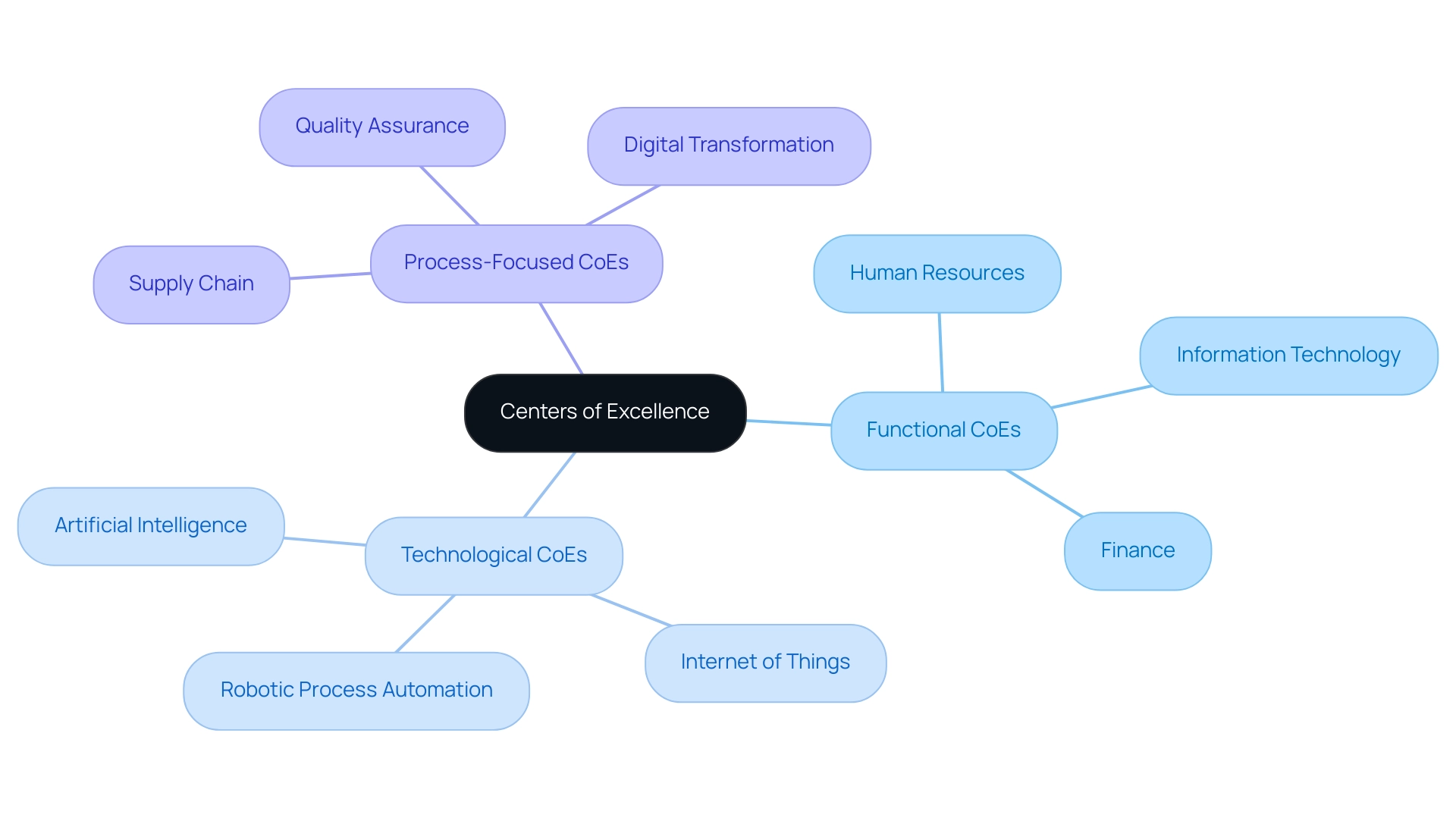
The Value Proposition of Centers of Excellence
The coe team meaning serves a crucial function in entities by fostering a culture of ongoing enhancement and promoting innovation. They serve as hubs for specialized knowledge, streamlining processes and enhancing decision-making capabilities, particularly in leveraging Robotic Process Automation (RPA) to automate manual workflows. By centralizing expertise in information management and analytics, Codes empower organizations to keep pace with the rapidly evolving AI landscape, ultimately fostering a competitive advantage.
Investing in a Code is not merely an operational decision; it is a strategic move that can lead to substantial long-term benefits. An effective CoE requires a skilled team of information professionals and RPA specialists, which highlights the coe team meaning, necessitating an investment in talent and training. This diverse ACE team should include individuals proficient in:
– Data analysis
– Data engineering
– Business analysis
– RPA governance
As noted by the Chief Data Officer,
Ultimately, the CDO’s leadership and strategic positioning are critical to harnessing the full potential of the CoE, driving innovation, and achieving sustainable competitive advantages.
Furthermore, entities must establish clear metrics to measure the impact of their CoE initiatives. For instance, defining metrics enables entities to evaluate the value and effectiveness of the ACE over time, such as tracking the number of data-driven initiatives, employee training in analytics, and the implementation of RPA solutions.
These metrics can include:
– Reductions in operational errors
– Time saved on manual tasks
– Improvements in team resource allocation towards strategic projects
These benefits include significant cost savings, improved employee engagement, and heightened customer satisfaction, thus reinforcing the value proposition of centers of excellence in driving organizational performance well into 2024 and beyond. Additionally, addressing the challenges posed by manual, repetitive tasks is crucial, as these can hinder efficiency and lead to wasted resources, making the case for RPA even stronger.
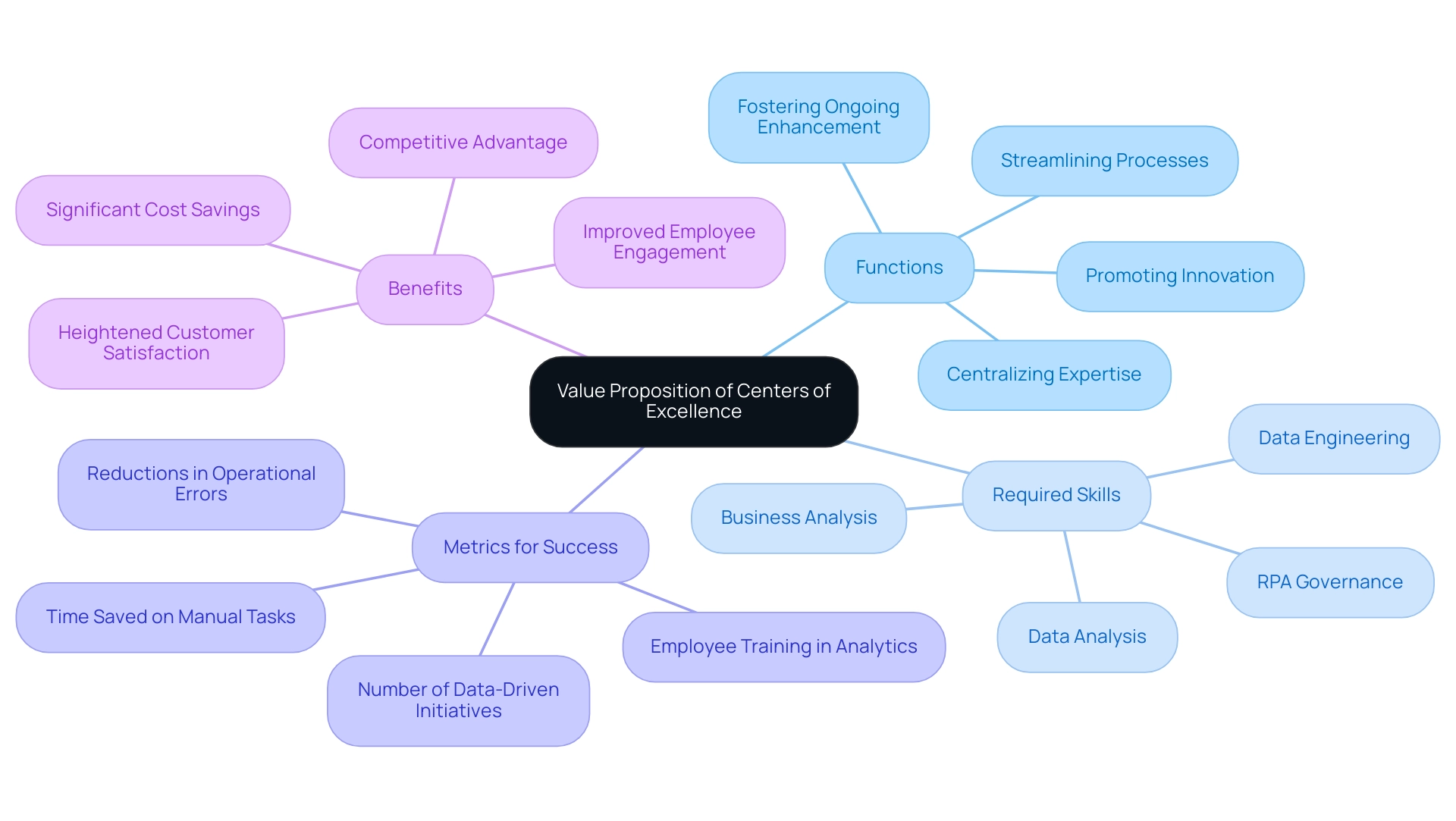
Implementing a Center of Excellence: Strategies for Success
Successfully implementing a Center of Excellence (CoE) requires understanding the coe team meaning, which begins with defining clear objectives that resonate with organizational goals. It’s crucial to identify and engage the right stakeholders early in the process, securing executive sponsorship to ensure top management support. A recent observation from corporate experts highlighted a list of 100 areas needing improvement after site visits, underscoring the necessity of a structured approach to address specific challenges in Code implementation.
Manual, repetitive tasks can significantly slow down your operations, leading to wasted time and resources; integrating Robotic Process Automation (RPA) can significantly streamline workflows, enhancing operational efficiency and allowing your team to focus on more strategic initiatives. Establishing a robust governance framework is essential; it should clearly define roles, responsibilities, and decision-making processes to foster accountability and transparency, especially in light of new SEC ESG regulations that may influence compliance requirements. The rapidly evolving AI landscape can be daunting, making it essential to tailor AI solutions to your unique business context, ensuring that you adopt the right tools that align with your goals.
Investing in training and resources is equally important, as understanding the CoE team meaning equips members with the necessary skills to drive initiatives effectively. Regularly tracking progress and soliciting feedback not only facilitates continuous improvement but also enhances stakeholder engagement—a critical component for success. According to a report by the Data Governance Institute, entities with a coe team meaning enjoy improved information quality and compliance, with 80% of them having strong governance frameworks compared to just 45% lacking.
The College of New Jersey’s Center for Excellence in Teaching and Learning (CETL) exemplifies this structured approach, as it plans to expand its online resources and strengthen connections with schools over the next two years by focusing on tailored solutions for faculty development. By adopting these strategies and utilizing Business Intelligence to convert information into actionable insights, entities can ensure their codes provide significant value.
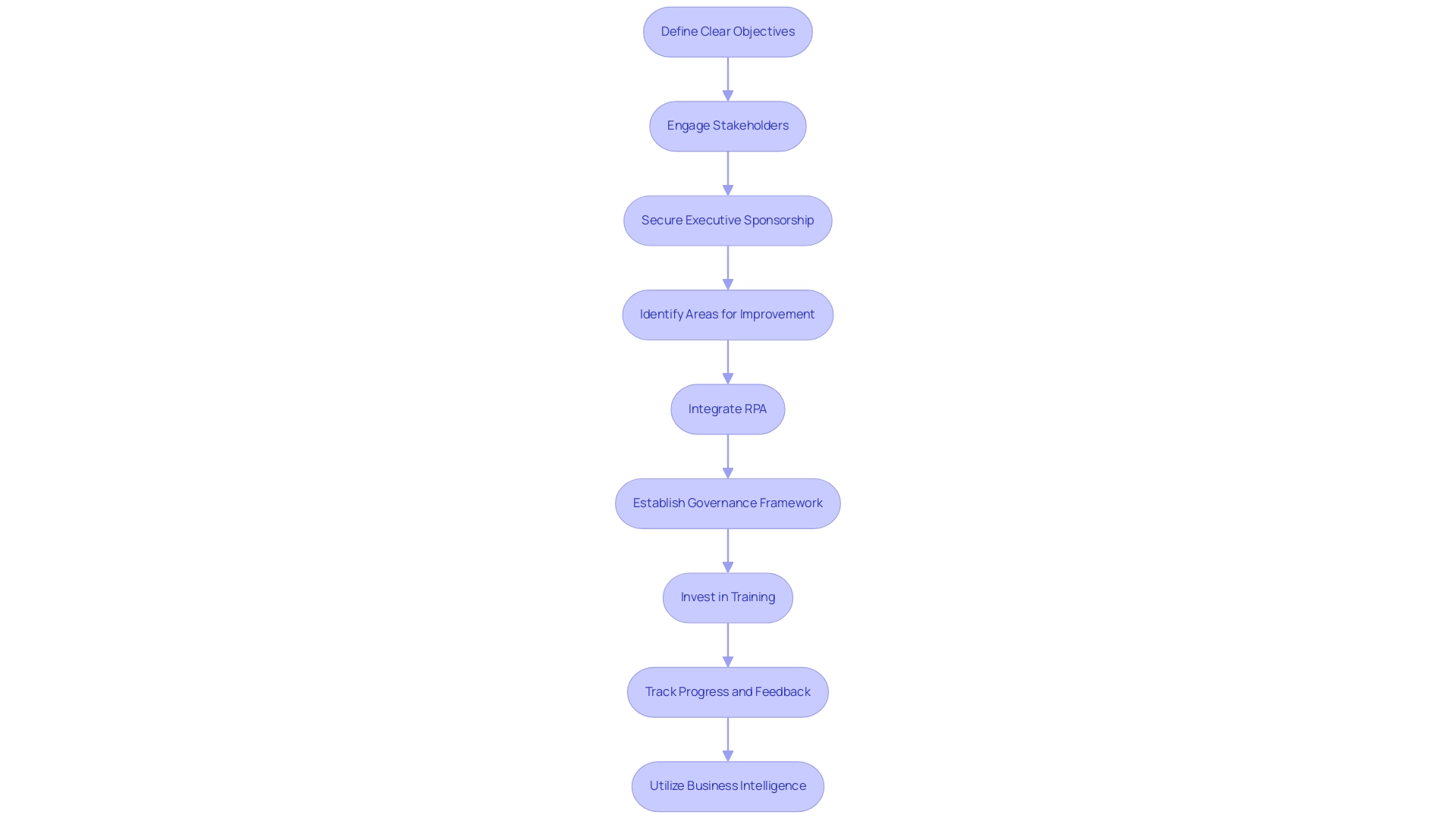
Sustaining and Evolving Your Center of Excellence
To effectively sustain and evolve a Center of Excellence (CoE), leaders must proactively assess the coe team meaning and its relevance amidst the ever-changing organizational landscape and market dynamics. By leveraging Robotic Process Automation (RPA), companies can automate repetitive manual workflows, significantly enhancing operational efficiency, reducing errors, and freeing up team capacity for more strategic, value-adding work. Establishing clear metrics is essential for evaluating the coe team meaning, which enables the collection of valuable insights from both internal and external stakeholders.
For instance, metrics such as the following can provide concrete measures of the CoE’s effectiveness:
- The number of evidence-based decisions made
- The level of information literacy among employees
- The speed of information processing
Fostering a culture of innovation within the CoE is crucial; understanding the coe team meaning can be achieved by promoting experimentation and collaboration among team members. Additionally, navigating the rapidly evolving AI landscape is vital—tailored AI solutions can help identify the right technologies that align with specific business goals.
Staying informed about the latest industry trends and emerging technologies, such as artificial intelligence and machine learning, will ensure that the Code remains a leader in best practices. Statistics indicate that 80% of entities with a Code have strong governance frameworks in place, a stark contrast to the 45% of those lacking one. This highlights the meaning of the coe team in enhancing efficiency and driving strategic decision-making.
The primary purpose of a Data and Analytics CoE is to centralize expertise and resources in data management and analytics, which reflects the coe team meaning by fostering a data-driven culture that supports strategic decision-making throughout the entity. Ultimately, as the Chief Data Officer aptly notes,
Ultimately, the CDO’s leadership and strategic positioning are critical to harnessing the full potential of the CoE, driving innovation, and achieving sustainable competitive advantages.
By fostering an adaptive Code that incorporates RPA and Business Intelligence, entities can continue to leverage its expertise and insights, leading to sustained improvements in operational efficiency and innovation.
We encourage you to explore RPA solutions to unlock these benefits and drive your organization’s success.
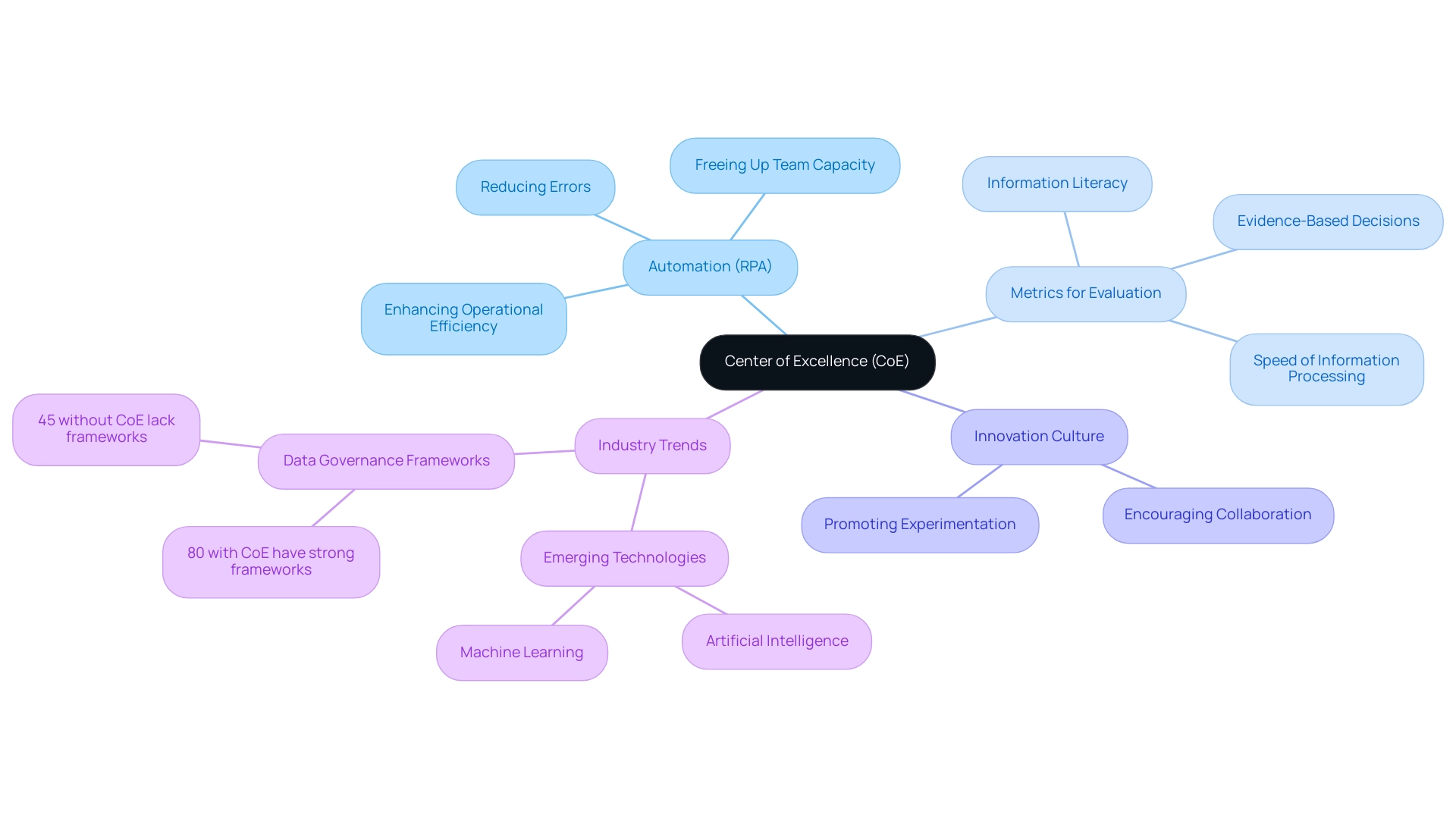
Conclusion
In the current business environment, the establishment of Centers of Excellence (CoEs) has emerged as a vital strategy for organizations seeking to enhance operational efficiency and foster innovation. By concentrating expertise in specific domains, CoEs not only facilitate knowledge sharing but also drive the implementation of best practices that lead to measurable improvements in performance. The diverse types of CoEs—from functional and technological to process-focused—provide tailored solutions to unique organizational challenges, enabling companies to optimize workflows and leverage advanced technologies such as Robotic Process Automation (RPA).
The value proposition of CoEs is clear: they cultivate a culture of continuous improvement and empower organizations to navigate the complexities of modern operations. By investing in skilled teams and establishing clear metrics, organizations can track the impact of their CoE initiatives, ensuring alignment with strategic objectives. The integration of RPA and Business Intelligence further enhances decision-making capabilities, transforming raw data into actionable insights that drive growth.
To sustain and evolve a CoE, it is crucial for leaders to regularly assess its relevance and effectiveness in light of shifting market dynamics. By fostering a culture of innovation and embracing tailored AI solutions, organizations can ensure their CoEs remain at the forefront of industry best practices. The leadership and strategic positioning of the CoE are pivotal in harnessing its full potential, ultimately leading to sustained competitive advantages and improved operational outcomes. By embracing these strategies, organizations can unlock the transformative benefits of CoEs and position themselves for long-term success in an ever-evolving landscape.
Introduction
In the rapidly evolving landscape of data analytics, organizations are increasingly turning to Power BI Embedded as a game-changing solution. This powerful Microsoft Azure service not only enhances the user experience by embedding interactive reports and dashboards directly into applications but also empowers businesses to make data-driven decisions with confidence.
As industries like banking and financial services anticipate significant growth, the ability to leverage real-time insights becomes paramount. By addressing common challenges such as:
- Time-consuming report creation
- Data inconsistencies
Power BI Embedded streamlines workflows and boosts productivity, allowing directors to focus on operational efficiency.
With a suite of best practices for deployment and robust security measures in place, organizations can unlock the full potential of their data, driving innovation and success in their operations.
Understanding Power BI Embedded: Definition and Purpose
The Power BI Embedded Azure service signifies a crucial offering from Microsoft Azure that enables developers to effortlessly incorporate interactive reports and dashboards into their applications. This integration allows organizations to provide comprehensive visualizations and strong analytics capabilities to users, all without requiring a BI account for access. The main objective of Power BI Embedded Azure is to enhance user experience by providing direct access to insights within the application, thereby enabling informed decision-making through real-time analysis.
In terms of operational efficiency, especially in fields such as BFSI (Banking, Financial Services, and Insurance), which is expected to see substantial growth from 2023 to 2032 according to Inkwood Research, utilizing Power BI Embedded Azure can be revolutionary.
- The introduction of the ‘Get Data Experience in Power BI Report Builder’ allows creators to build documents on over 100 data sources, thus improving performance and enhancing the document creation process for large datasets. This not only streamlines workflows but also enhances productivity, which is essential for directors concentrated on operational efficiency.
Additionally, the 3-Day Power BI Sprint offers a fast-track solution for organizations seeking to create professionally designed documents swiftly. This sprint is designed to rapidly develop tailored reports that meet specific business needs, significantly reducing the time from concept to deployment. Coupled with tools like the General Management App, which offers comprehensive management features such as smart reviews and performance tracking, businesses can achieve a risk-free ROI assessment and professional execution of their reporting needs.
These solutions, alongside the insights gained from the case study on enhancing operational efficiency through GUI automation, showcase how companies can overcome challenges in data entry, software testing, and legacy system integration while realizing measurable outcomes. By embedding Power BI Embedded Azure, organizations can not only utilize its robust analytical features but also improve overall user experience and operational productivity.
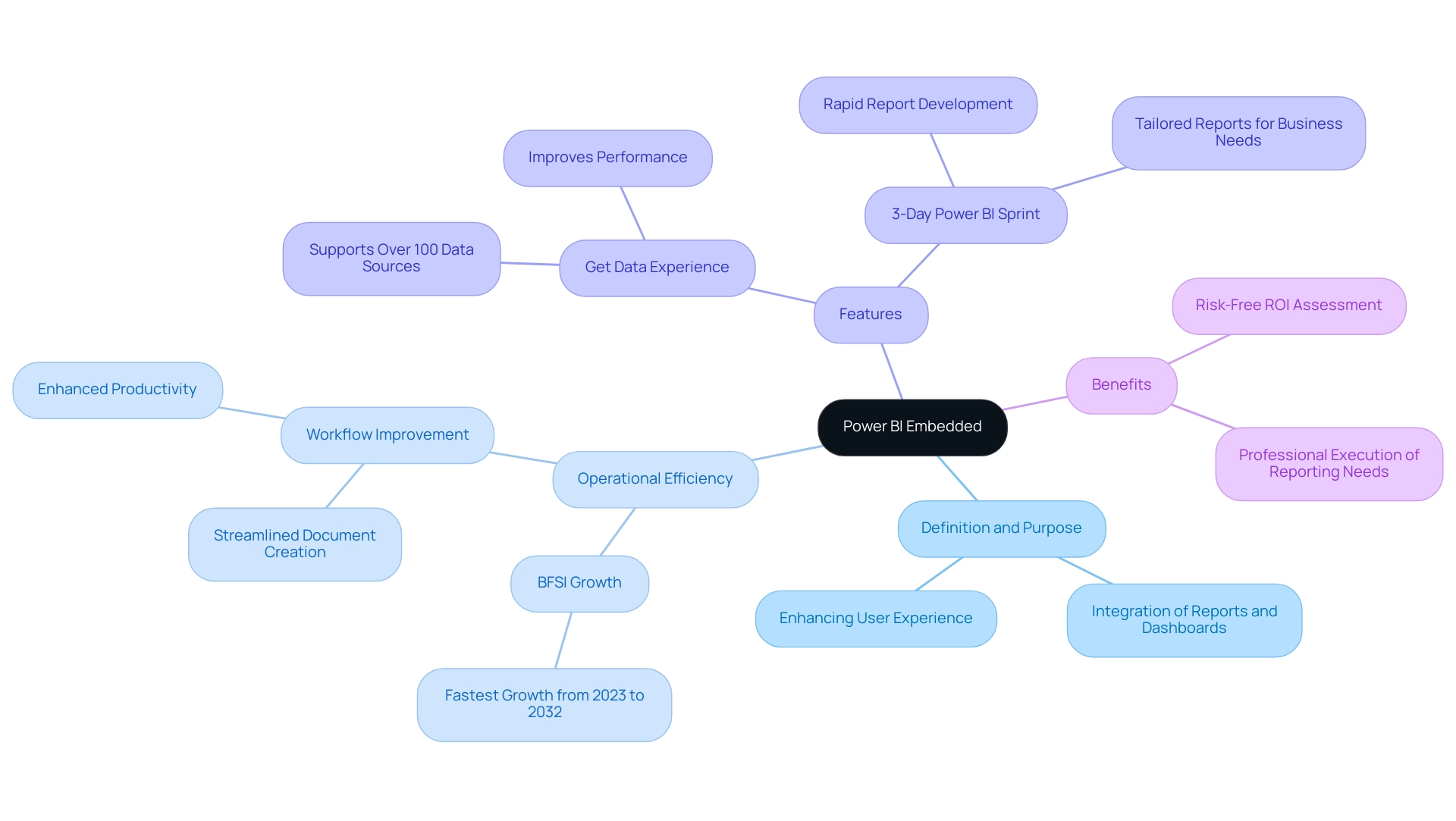
Deploying Power BI Embedded in Azure: Best Practices and Strategies
To successfully implement Power BI Embedded Azure integration, organizations must adhere to a set of best practices that ensure smooth integration and optimal performance. Firstly, a thorough assessment of the organization’s specific requirements is critical for determining the appropriate capacity for Power BI Embedded Azure, as this choice directly influences both performance and cost. According to recent studies, optimizing information loading can enhance document speed by up to 40%, while efficient storage alternatives can significantly decrease latency.
Using the Azure portal to create a dedicated workspace for Power BI Embedded Azure is the next logical step, allowing developers to effectively manage documents and information sources. However, many organizations find themselves investing more time in creating documents than leveraging insights from Power BI dashboards. This common challenge can lead to confusion and mistrust in the information presented, particularly when inconsistencies arise due to a lack of governance strategy.
Implementing a robust governance strategy is essential to ensure information integrity and consistency across reports. Security measures, such as implementing row-level security and robust authentication protocols, are essential to safeguard sensitive information from unauthorized access. A relevant case study titled ‘Avoiding Floating Point Data Types’ highlights how employing whole numbers or decimals minimizes precision issues, leading to accurate analytical outputs.
Additionally, regular monitoring of usage and performance metrics allows organizations to fine-tune their analytics solutions, including Power BI Embedded Azure, facilitating ongoing optimization. As Ted Pattison noted, ‘Regular updates and assessments are key to leveraging the full potential of Power BI.’ By incorporating Robotic Process Automation (RPA) to streamline repetitive tasks and focusing on actionable insights rather than just information presentation, businesses can enhance their analytics-driven decision-making capabilities.
Additionally, the General Management App, featuring its Microsoft Copilot Integration, provides extensive management tools, personalized dashboards, and predictive analytics, simplifying the process for organizations to obtain actionable insights from their information. This guarantees that their BI Integrated deployment is both efficient and secure.
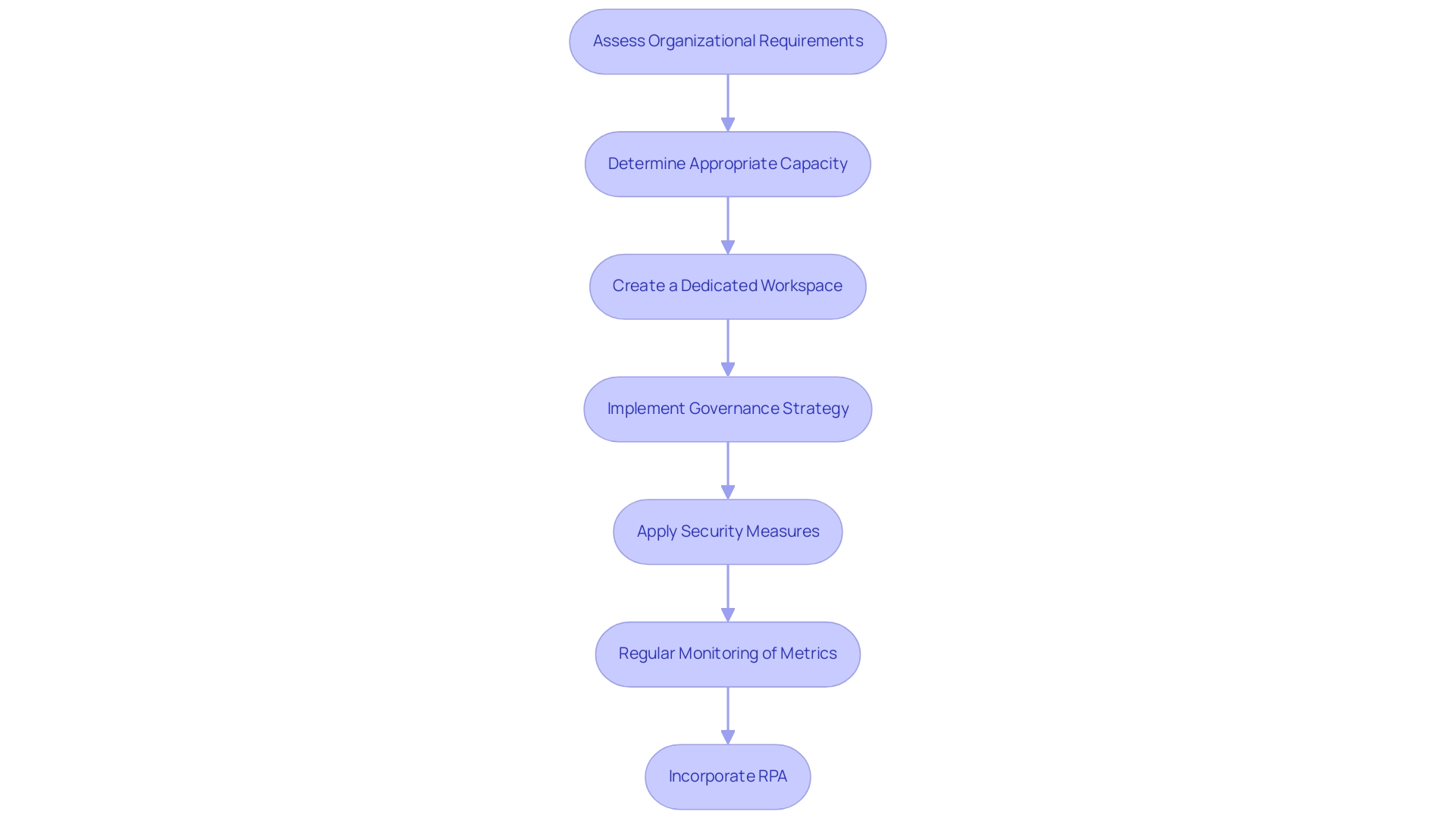
Benefits of Power BI Embedded for Businesses and Developers
Power BI Embedded Azure offers a revolutionary chance for enterprises and developers, greatly improving accessibility and visualization of information. In today’s information-rich environment, where obtaining valuable insights is essential, organizations can utilize BI tools to address challenges such as:
- Time-consuming document creation
- Inconsistencies in information
- A lack of actionable guidance
By facilitating rapid insights extraction, organizations can make informed, data-driven decisions with confidence.
Customization emerges as a pivotal strength, enabling companies to tailor reports and dashboards according to their specific needs, ensuring that the information presented is relevant and actionable. Moreover, integrating Robotic Process Automation (RPA) solutions can further streamline operations by automating repetitive tasks, thereby enhancing overall efficiency and reducing the burden on staff. Developers, as well, gain considerably; the incorporation of BI Integrated dramatically decreases the time and resources required to create analytics functionalities from scratch, enabling them to concentrate on improving essential application features.
Furthermore, the affluent, interactive visual representations offered by BI Embedded boost user involvement, resulting in more significant interactions. For instance, educational institutions employing BI for student analytics have reported significant advancements in pinpointing areas for enhancement, ultimately promoting student success and ensuring institutional effectiveness. Notably, at the 2021 Microsoft Business Application Summit, it was revealed that a staggering 97% of Fortune 500 companies now utilize BI, underscoring its widespread adoption and effectiveness.
As we near 2024, the benefits of embracing Power BI Embedded Azure integration are clear; it allows organizations to utilize the full capability of their information while simplifying development procedures, ultimately leading to improved results for enterprises. Additionally, from an investment standpoint, the cost of 100 GB RAM is $32.2506/hour, emphasizing the financial implications of using BI integrated in a scalable manner.
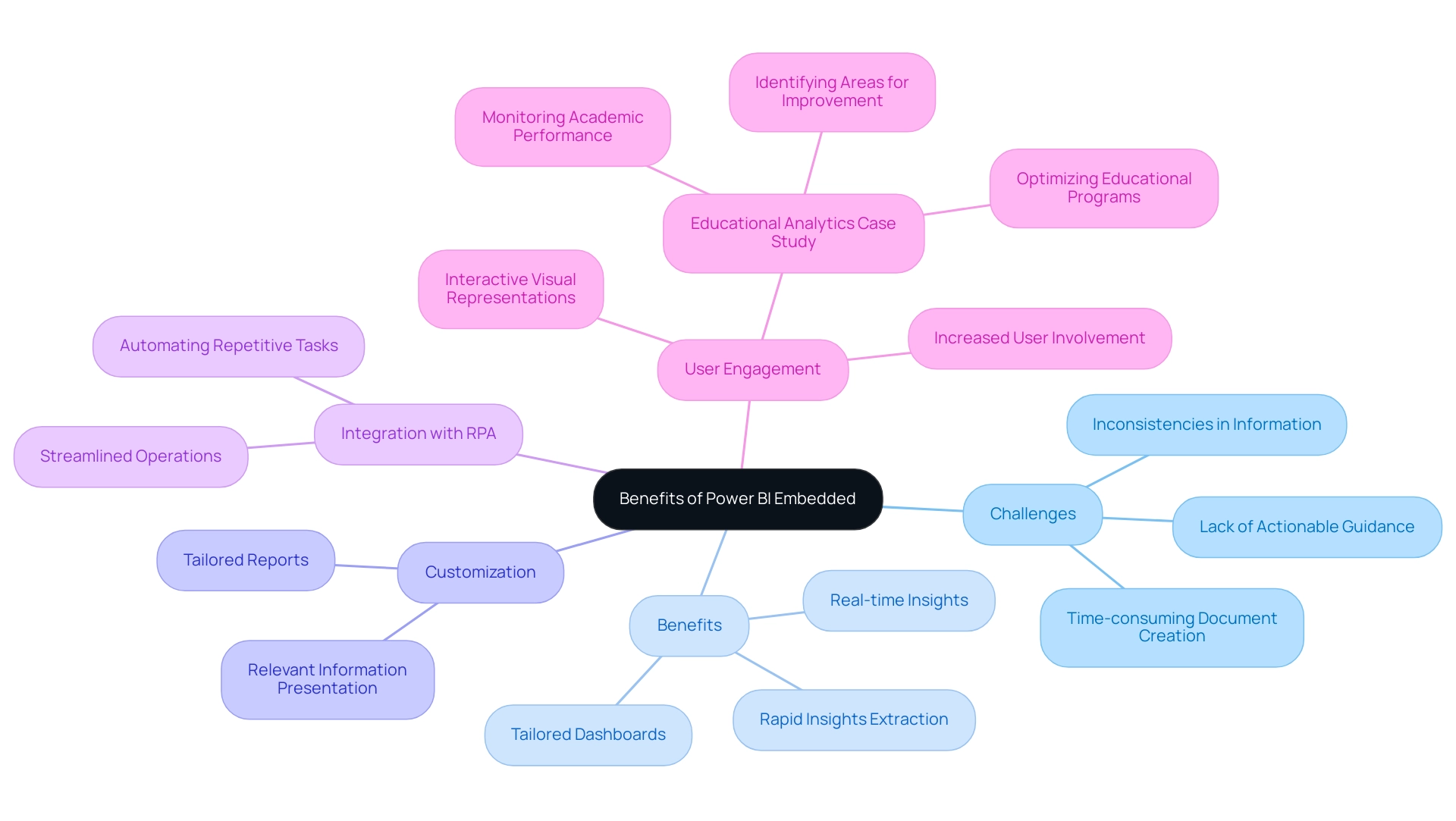
Security and Compliance in Power BI Embedded
Power BI Embedded Azure is designed with a comprehensive suite of security and compliance features that protect organizational information. It utilizes Azure Active Directory for authentication, ensuring that only authorized users gain access to reports in Power BI Embedded Azure. This authentication layer in Power BI Embedded Azure is complemented by row-level security, which allows organizations to meticulously control visibility based on user roles, thereby enhancing privacy and security.
Adherence to crucial standards such as GDPR and HIPAA is a fundamental aspect of BI integration, particularly when utilizing Power BI Embedded Azure, demonstrating its commitment to strict protection regulations. Organizations can confidently deploy Power BI Embedded Azure, ensuring that their data management practices align with industry standards, thus safeguarding sensitive information and fostering trust in their analytics solutions. Furthermore, the minimum annual commitment for BI Premium is $59,940, or $4,995 per month, highlighting the financial investment in robust security and compliance features.
To fully utilize insights from Business Intelligence, consider our 3-Day Business Intelligence Sprint, which provides you with professionally crafted documents tailored to your specific business needs, such as sales performance or customer insights. This service not only streamlines your reporting process but also addresses common challenges such as data inconsistencies and lack of actionable guidance. By integrating security measures similar to those in BI Embedded, your reports will be both reliable and insightful.
A case study on service principals in Business Intelligence illustrates how organizations can manage access and automation tasks securely, enhancing the practical application of these security features. As Andrey Nikolov aptly noted, ‘Ah, I forgot about the Q&A visual. It enables users to pose straightforward text inquiries about the information, showcasing how user-friendly features enhance the security framework and empower stakeholders to obtain actionable insights.
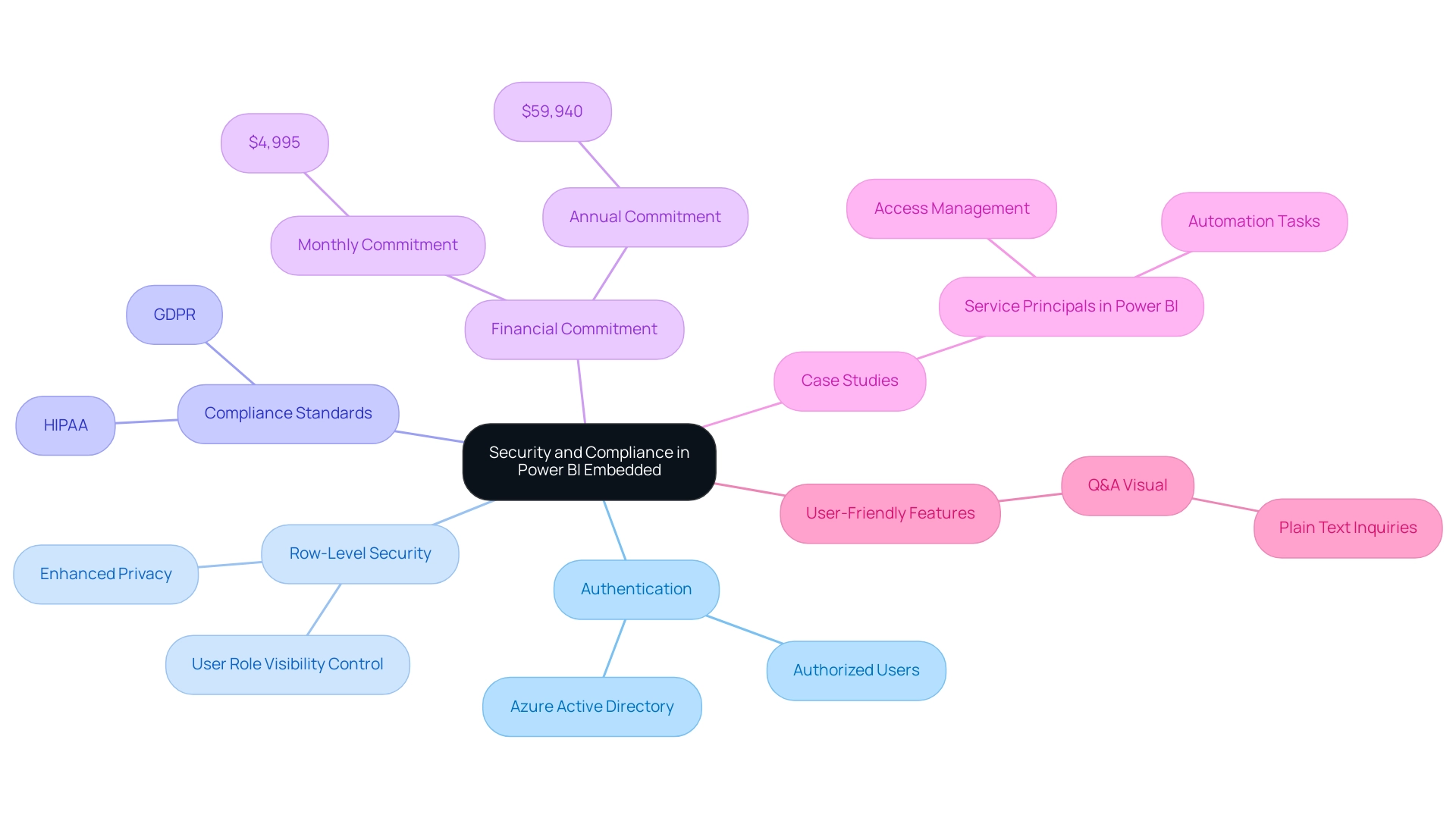
Integrating Power BI Embedded with Azure Services
Power BI Embedded Azure provides effortless integration with multiple Azure services, creating a strong analytics ecosystem that enables organizations to utilize information effectively. By utilizing BI services such as the 3-Day Sprint, businesses can quickly create professionally designed documents that provide clear, actionable insights. The inclusion of the General Management App facilitates comprehensive management and smart reviews, addressing challenges in document creation and data consistency.
Furthermore, integrating Power BI Embedded Azure with Azure Data Lake Storage allows for efficient analysis of extensive datasets, unlocking valuable insights that drive strategic decisions. With the added advantage of Azure Machine Learning, predictive analytics capabilities enhance reports with forward-looking insights for informed decision-making. Additionally, Robotic Process Automation (RPA) streamlines manual workflows, boosting efficiency and reducing errors, which is crucial for operational success.
Automate also ensures risk-free ROI assessment and professional execution. This holistic approach not only enhances operational efficiency but also fosters innovation and growth within organizations. As Tariq Usmani, CEO of Pack’n Fresh, stated,
‘I built a million-dollar manufacturing business using QuickBooks and Excel but had trouble scaling.
Now, with integrated Power BI tools within Dynamics 365, we can make quick, meaningful, and intelligent decisions on all fronts.’
This integration exemplifies how organizations can transform their data strategies and operational efficiency, moving towards a more data-driven future.
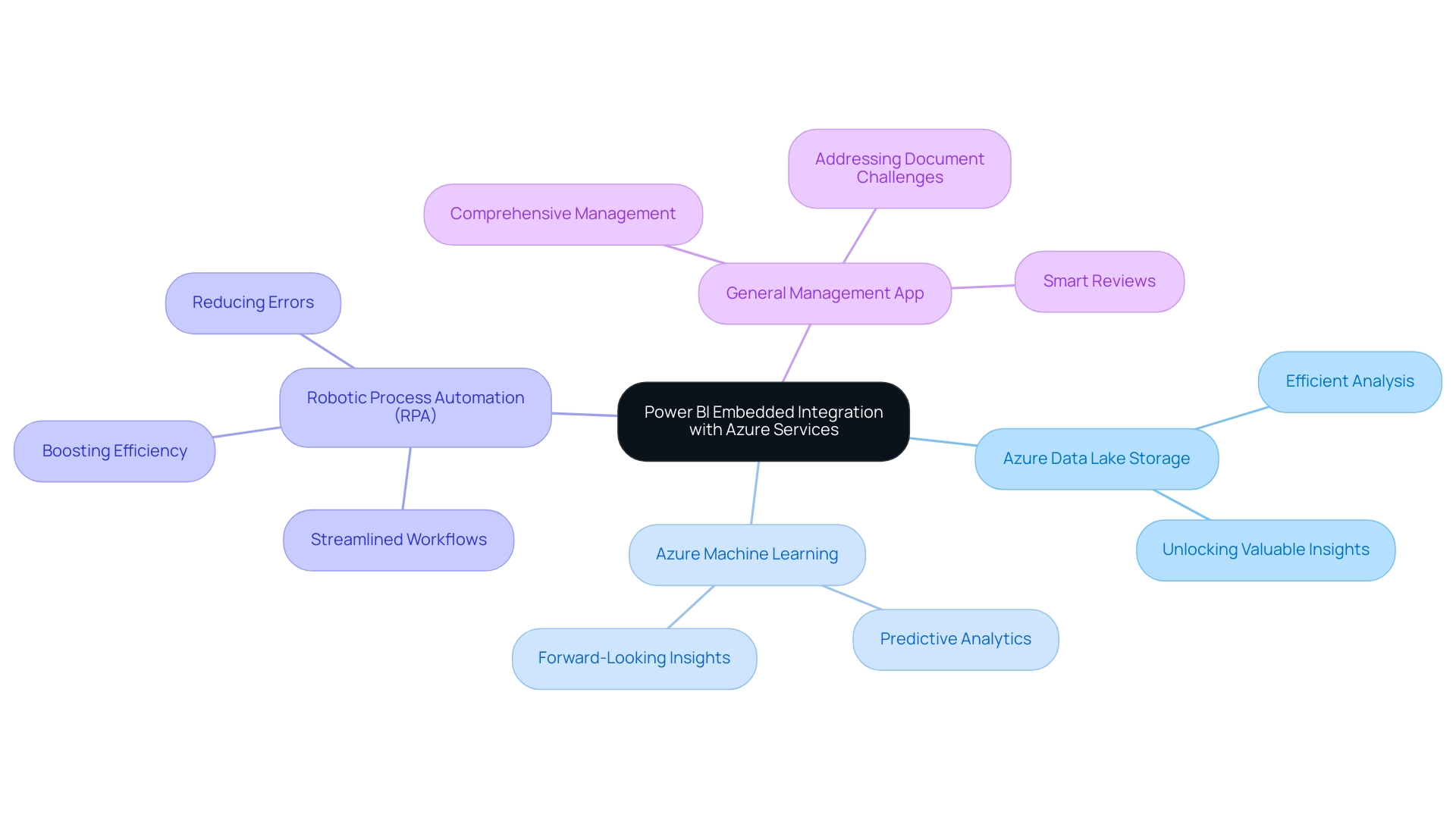
Conclusion
Embedding Power BI within organizational applications offers a powerful solution for enhancing data accessibility and operational efficiency. By streamlining report creation and providing real-time insights, Power BI Embedded enables businesses to make informed decisions quickly, overcoming common challenges such as data inconsistencies and time-consuming processes. The integration with Azure services further amplifies these benefits, offering a comprehensive analytics ecosystem that supports the creation of tailored reports and predictive analytics.
Organizations that adopt best practices for deploying Power BI Embedded can maximize its potential while ensuring security and compliance. With robust features like row-level security and adherence to data protection regulations, businesses can confidently manage sensitive information. The ability to customize reports according to specific business needs not only enhances user engagement but also drives better outcomes, as evidenced by the widespread adoption of Power BI among leading companies.
As industries continue to evolve, the shift towards data-driven decision-making is essential for maintaining a competitive edge. By leveraging Power BI Embedded, organizations can unlock the full potential of their data, streamline workflows, and foster innovation. Embracing this technology is not just a strategic move; it is a pathway to transforming operational efficiency and achieving sustainable growth in an increasingly data-centric world.
Introduction
In the rapidly evolving landscape of data analytics, the integration of SQL Server Analysis Services (SSAS) with Power BI emerges as a game-changer for organizations striving to enhance their Business Intelligence capabilities. By leveraging SSAS, businesses can build sophisticated multidimensional data models that not only streamline the reporting process but also address critical challenges such as data inconsistencies and inefficiencies in report creation.
This article delves into the intricacies of connecting Power BI with SSAS, providing a comprehensive step-by-step guide, troubleshooting tips for common issues, and best practices to optimize performance. Additionally, it explores advanced features that can unlock deeper insights and drive operational efficiency.
As organizations seek to transform raw data into actionable insights, understanding how to effectively harness these powerful tools is essential for fostering growth and maintaining a competitive edge in today’s data-driven world.
Understanding SQL Server Analysis Services and Its Role in Power BI
The sql server analysis services power bi functions as a key element of the Microsoft SQL Server suite, enabling users to create and oversee advanced multidimensional constructs vital for effective Business Intelligence. Its integration with Business Intelligence is crucial in addressing issues like lengthy report generation and inconsistencies, as the analytical services offer a strong backend source capable of managing complex analytical queries and intricate aggregations. By creating a link between BI and sql server analysis services power bi, users can utilize the extensive models and advanced computations developed within sql server analysis services power bi, significantly improving their reporting and visualization abilities.
Comprehending the arrangement of information into cubes and dimensions within SSAS is essential, as this structure directly affects accessibility and analysis in BI. This knowledge not only facilitates a more effective transformation of raw information into actionable insights but also positions users to fully leverage their analytical efforts. In today’s data-driven landscape, the lack of actionable insights can hinder growth, making it imperative for businesses to adopt these tools.
Furthermore, outdated systems can exacerbate these issues, but RPA solutions, such as EMMA RPA, can streamline processes and enhance operational efficiency. With Power BI services like the 3-Day Sprint for rapid report creation and the General Management App for comprehensive management, businesses can transform operations and drive growth. A key statistic to consider is that the fourth round with a sampling rate of 30% successfully removed all non-compliant steps, highlighting the importance of accuracy and maintenance.
As noted by Adrien Muhlemann, a database performance engineer at Ivalua, ‘Finally, I hope that you found this article interesting, and that you have learned something!’ This statement acts as an encouragement to engage with these powerful tools for enhanced analysis. Furthermore, the case study titled ‘Tuning Phase of Statistics Improvement‘ illustrates how updating statistics with larger sampling rates can enhance accuracy while minimizing resource expenditure, providing a practical example of its impact in real-world scenarios.
To learn more about how these tools can benefit your organization, consider booking a consultation.
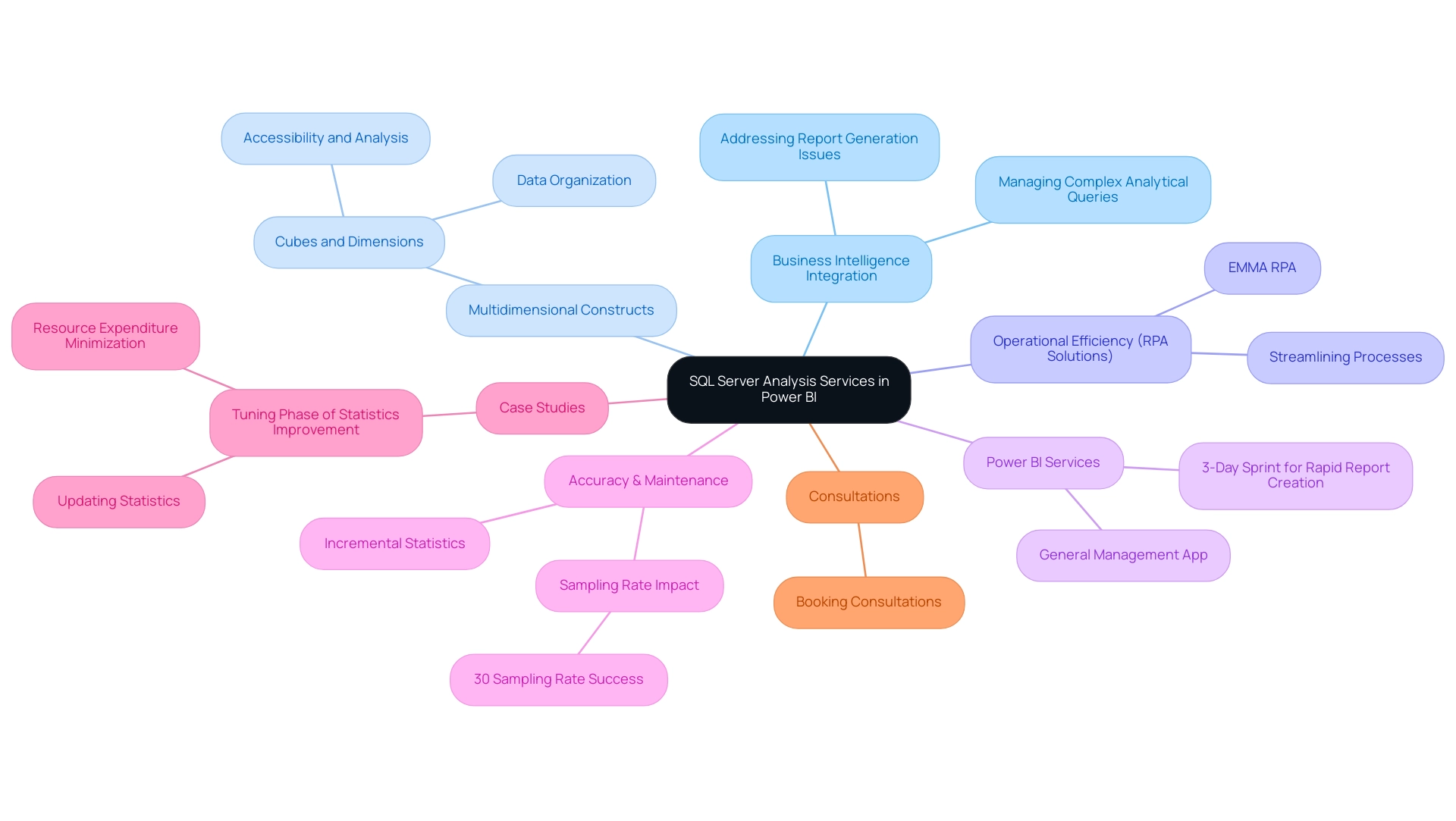
Step-by-Step Guide to Connecting Power BI with SQL Server Analysis Services
Linking BI to SQL Server Analysis Services
Power BI creates a realm of visualization and analysis opportunities that are essential for utilizing Business Intelligence to enhance operational efficiency. This tool not only offers efficient information compression—1GB can signify roughly 50 million rows—but also converts raw information into actionable insights, enabling your organization to make informed, evidence-based decisions. Moreover, integrating Robotic Process Automation (RPA) solutions can further streamline the report creation process, reducing the time spent on repetitive tasks and minimizing data inconsistencies.
Follow these steps to establish a seamless connection:
- Open BI Desktop: Begin by launching BI Desktop on your workstation.
Get Data: Navigate to the ‘Home’ tab and select ‘Get Data’. - From the dropdown menu, choose ‘SQL Server Analysis Services Database’.
- Enter Server Details: In the dialog box that appears, input the server name hosting your Analysis Services. If applicable, specify the database name you wish to connect to.
- Select Connection Mode: You’ll have the option to choose between ‘Import’ or ‘DirectQuery’ mode. Import mode enables you to load information into Power BI, while DirectQuery offers a live link to your analysis services.
Authenticate: Click ‘OK’ and enter your credentials when prompted.
Ensure you possess the necessary permissions to access the SSAS database; this is crucial for a successful connection. You can confirm this by accessing files, options and settings, and settings to replace your source if necessary.
- Select Information Structures: After connecting, a navigator pane will show the available information frameworks.
Select the model(s) you wish to work with in Business Intelligence. - Load Information: Click ‘Load’ to import the chosen information into BI. If you chose DirectQuery, the information will be queried live as you create your reports.
Generate Reports: With the information now loaded, utilize BI’s visualization tools to design insightful reports and dashboards based on your analytical services.
Additionally, it’s important to comprehend how user permissions are validated in this context. In a case study involving roles in the Local Active Directory Instance, Analysis Services converts the effective user name from Microsoft Entra ID to the local Active Directory, helping validate user permissions and ensure proper access control.
By adhering to these steps and considering these insights, including the integration of RPA for automating report generation, you can effectively connect BI to SQL Server Analysis Services Power BI, unlocking powerful data analysis and visualization capabilities that enhance your operational efficiency.
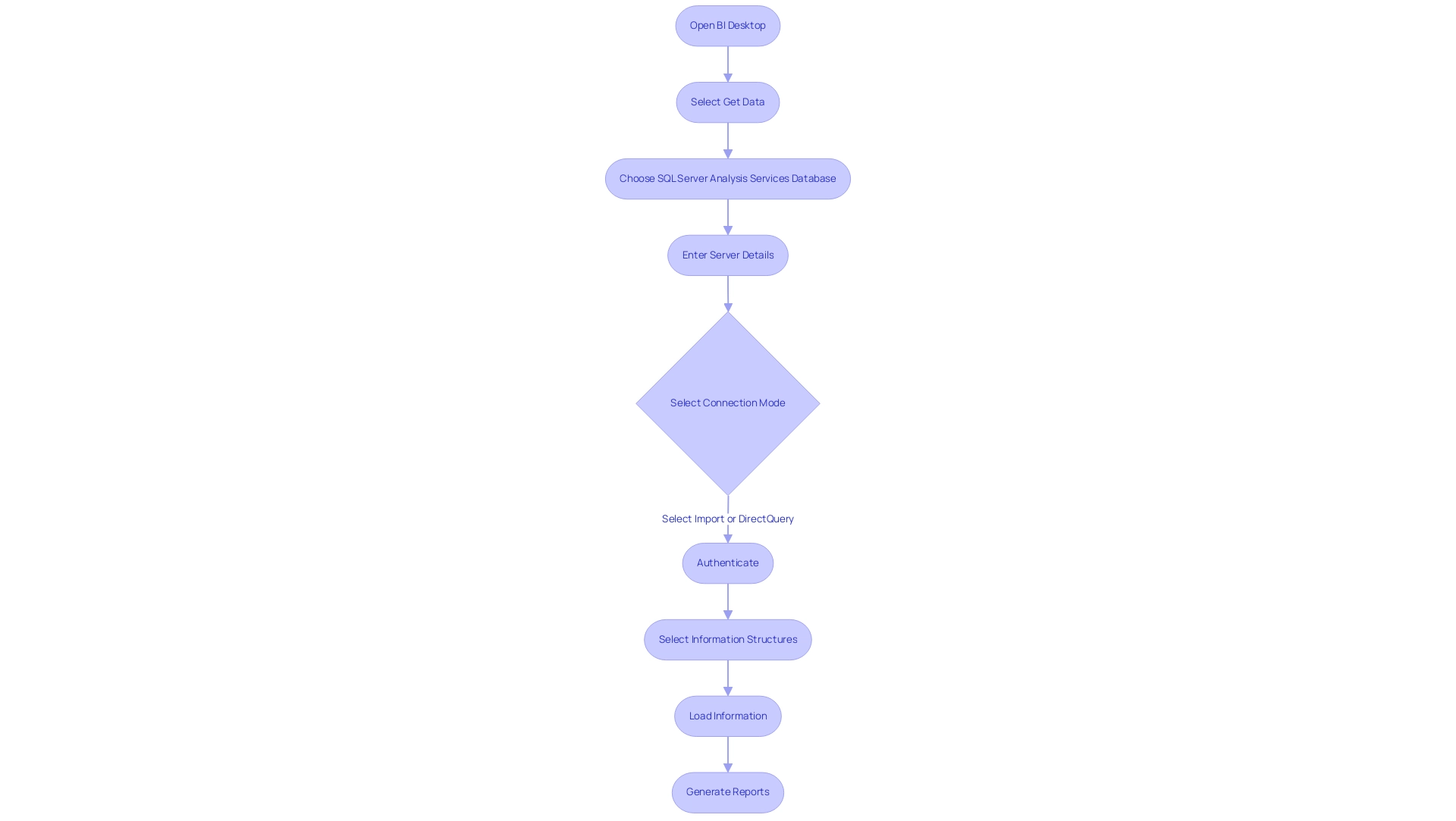
Common Issues and Troubleshooting Tips
Connecting Power BI to SQL Server Analysis Services
Power BI is typically a straightforward process; however, users often encounter common challenges that can hinder their efficiency. Here are key troubleshooting tips designed to empower you in overcoming these obstacles:
-
Connection Timeout: If you experience a connection timeout, first verify that the analysis services server is operational and reachable within your network. Review firewall settings and ensure that the appropriate port is open to facilitate communication, thus streamlining your workflow. Implementing Robotic Process Automation (RPA) can further enhance this process by automating routine checks and alerts related to connectivity issues.
-
Authentication Errors: When faced with authentication issues, meticulously review your credentials and ensure that you possess the necessary permissions for accessing the database. Confirm that you are utilizing the correct authentication method, whether it’s Windows authentication or SQL Server authentication, to prevent unnecessary delays in accessing critical information. Customized AI solutions can help by examining authentication trends and recommending ideal access techniques based on your usage history.
-
Information Structure Not Visible: If the expected information structures do not show in the navigator pane, confirm that the analysis services database is correctly set up and that you possess the necessary access to the particular structures. Refreshing the connection or restarting Power BI can rectify visibility issues, allowing for smoother information analysis and reporting. RPA can automate the refresh procedure, ensuring that model information is consistently updated without manual intervention.
-
Performance Issues: When facing slow performance, consider optimizing your analytical models by minimizing the number of columns and rows and adjusting information aggregation settings. Utilizing DirectQuery can greatly impact performance; hence, assess whether transitioning to Import mode aligns better with your retrieval requirements, improving overall efficiency. Utilizing AI solutions can offer insights into performance bottlenecks and suggest modifications to enhance data retrieval speed.
By proactively tackling these frequent issues with the offered solutions, you can greatly improve your connection process and ensure smoother interactions with SQL Server Analysis Services Power BI. Keep in mind the evolving landscape of analytics tools—architecting solutions with future transitions to Premium Capacity in mind will position your organization for success. For those interested in enhancing their skills, use code MSCUST for a $150 discount for the Microsoft Fabric Community Conference.
Moreover, as noted by an industry expert, romanovmv:
I’ve figured out why that happened: there was a setting discourage Implicit Measures set to be true in the on-premises Tabular structure. Should have probably turned it on while experimenting with calculation groups. Problem is solved now.
For practical insights, consider the case study titled ‘Resolving Connection Issues with Azure Analysis Services,’ where a user faced a new error related to Azure Analysis Services and the Data Gateway connecting to an Oracle database.
This example illustrates the importance of checking specific error messages and seeking expert assistance when necessary. Lastly, remember the value of community support; as highlighted by Gilbert, marking posts as solutions can greatly aid others in troubleshooting effectively, ensuring that your team can focus on strategic, value-adding work.
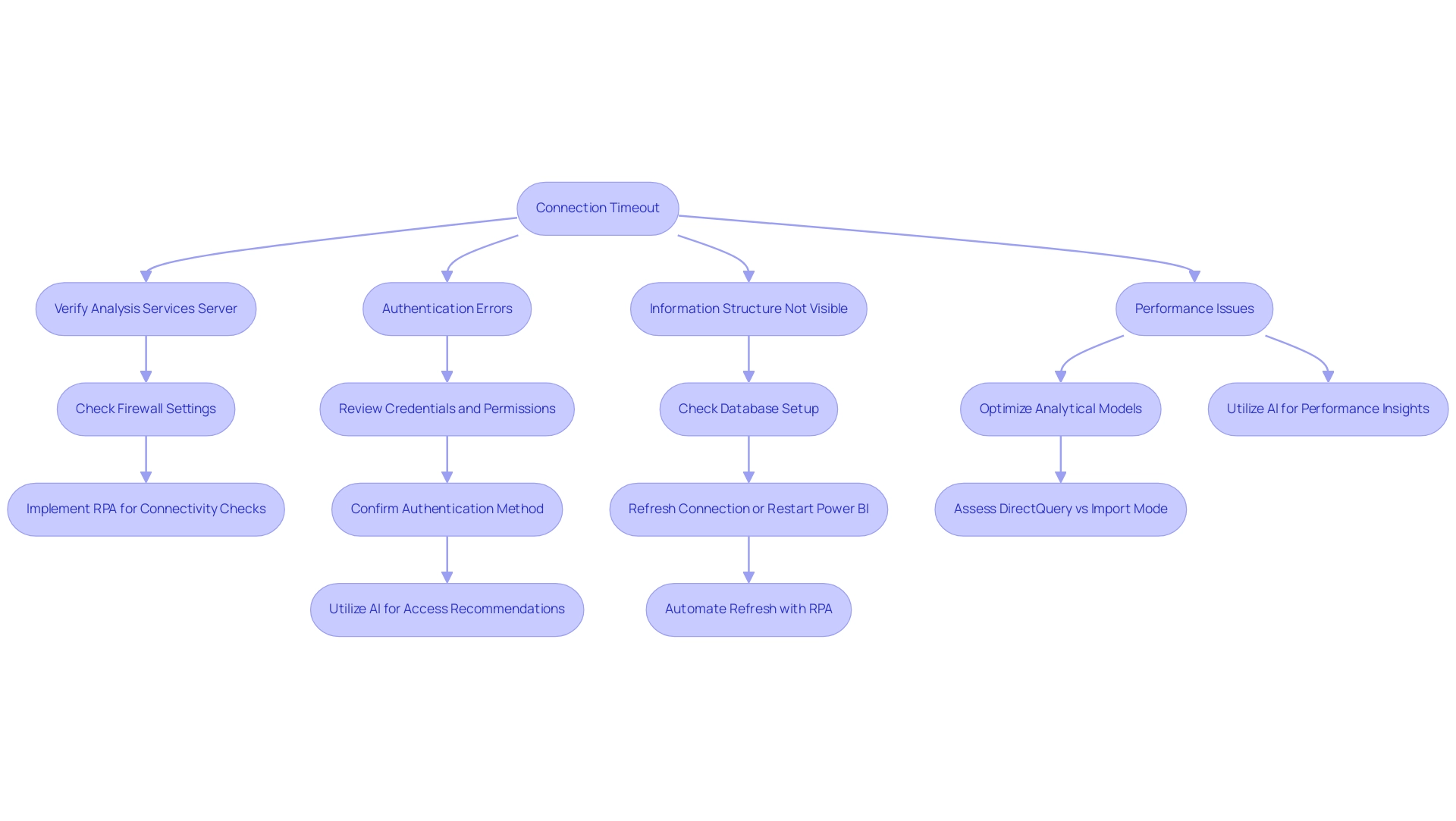
Best Practices for Using SSAS with Power BI
To fully harness the potential of Power BI when connected with SQL Server Analysis Services (SSAS), it is essential to adopt several best practices that enhance performance and user experience while addressing common technology implementation challenges:
-
Enhance Information Structures: Arrange your SSAS information frameworks carefully to guarantee optimal performance. This involves eliminating unnecessary columns and streamlining calculations, which can significantly reduce processing time and improve report responsiveness. As Prabu Chandran aptly notes, “the query provides only active session details,” emphasizing the significance of accurate information management in this process. By refining information structures, organizations can alleviate problems associated with inadequate master quality, improving the precision of insights obtained from BI.
-
Leverage Hierarchies: Implement hierarchies within your SSAS models to simplify information navigation. By enabling users to drill down seamlessly into information through SQL Server Analysis Services Power BI, you enhance their experience in Power BI, minimizing confusion and maximizing efficiency. This approach is essential in overcoming the challenges related to time-consuming report creation and inconsistencies.
-
Implement Row-Level Security: For organizations that prioritize information security, establishing row-level security within SSAS is crucial. This practice manages access to sensitive information based on user roles, ensuring that individuals only view what they are authorized to see. This not only safeguards integrity but also fosters trust in the insights produced.
-
Schedule Regular Information Refreshes: Keeping your analytical frameworks current is essential for ensuring accuracy in Business Intelligence. Automate refresh schedules to guarantee that reports reflect the latest information, thereby supporting informed decision-making. Regular updates are essential in a data-rich environment where timely insights can provide a competitive edge. This practice can also be enhanced by integrating Robotic Process Automation (RPA) to streamline the refresh process, ensuring efficiency and accuracy.
-
Monitor Performance Continuously: Regularly assess the performance metrics of your SQL Server Analysis Services Power BI reports and models. This proactive approach enables you to identify potential bottlenecks and make necessary adjustments, ensuring that users have an optimal experience. Monitoring performance is essential in addressing the obstacles to successful AI integration and maximizing the value obtained from information. Customized AI solutions can aid in analyzing performance information, offering actionable insights to enhance processes further.
Furthermore, real-world case studies, such as user-friendly perspectives, demonstrate how optimized SSAS frameworks can enhance accessibility. By creating ‘perspectives‘ to hide irrelevant portions of the model, organizations can enhance user experience, allowing users to focus on relevant information without distraction. By adhering to these best practices, organizations can significantly enhance their operational efficiency and the overall effectiveness of their BI implementations.
Moreover, although handling files in OneLake programmatically with the Python Azure SDK may not directly connect to analytical services best practices, grasping this capability can offer further context for enhancing workflows.
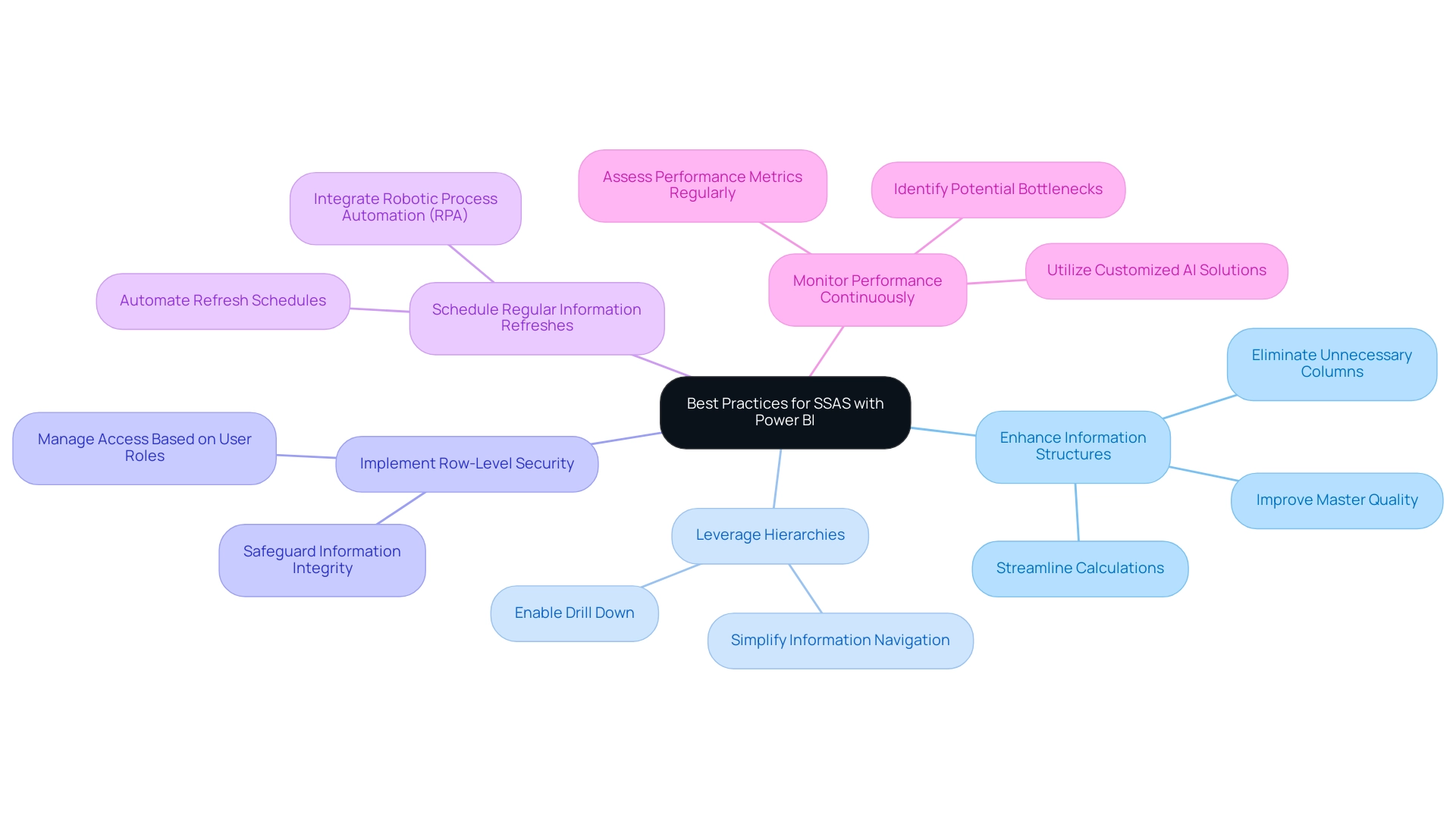
Exploring Advanced Features of SSAS in Power BI
After successfully establishing a connection between Power BI and SQL Server Analysis Services, it’s essential to explore several advanced features that can significantly enhance your analytical capabilities while also considering the role of Robotic Process Automation (RPA) in streamlining manual workflows:
-
Calculated Measures: By utilizing calculated measures within the system, you can create custom calculations tailored to your specific business requirements. This flexibility permits comprehensive insights that closely correspond with your operational goals, ultimately improving efficiency in handling information and reporting while decreasing the manual effort required in producing these insights.
-
Data Mining Models: If your analytical services instance supports data mining, dive into these models to uncover hidden patterns and trends in your information. Incorporating these insights into Power BI not only enriches your reports but also improves decision-making processes throughout the organization, facilitating the identification of opportunities for automation through RPA, which can help relieve the burden of repetitive analysis tasks. Mastering Multi-dimensional Expressions (MDX) for querying and manipulating information in SQL Server Analysis Services Power BI can provide profound insights and enable complex calculations that surpass what standard SQL queries offer. This capability is crucial for generating detailed reports that inform strategic initiatives, helping to pinpoint areas where RPA can further improve operational efficiency by automating the report generation process.
-
Integration with Azure Analysis Services: Leverage Azure Analysis Services for cloud-based analytics, which offers scalability and improved performance, particularly for organizations managing large datasets. This integration ensures that your analytics processes remain robust and responsive to changing information demands, supporting the efficient automation of workflows through RPA, thereby reducing the time spent on manual management tasks.
-
Custom Visuals in Business Intelligence: Discover the application of custom visuals to depict analytics information in creative manners. Custom visuals not only enhance user engagement but also facilitate a deeper understanding of the information, making it easier to convey insights to stakeholders and driving the adoption of analytics-driven decision-making across your organization.
Moreover, due to effective information compression, a rough basis for estimation would be 50 million rows in 1GB, showcasing the efficiency of handling when using SQL Server Analysis Services Power BI. Engaging with these advanced features empowers users to unlock the full potential of their analysis, fostering innovation and informed decision-making in their organizations. As noted by one user, mchapman, understanding usage statistics is crucial: ‘Thanks for the reply, I will include that trace log as part of my usage statistics… This should assist in determining if what’s being delivered is what was needed.’ Therefore, incorporating these advanced techniques with RPA will not only streamline operations but also guarantee that the information provided aligns with managerial expectations. Additionally, consider the case study on changing the data source from SQL Server to Power BI datasets, which illustrates a practical application of transitioning data sources while maintaining existing reports and visuals, highlighting how RPA can facilitate this process by automating data source updates and ensuring consistency across reports.
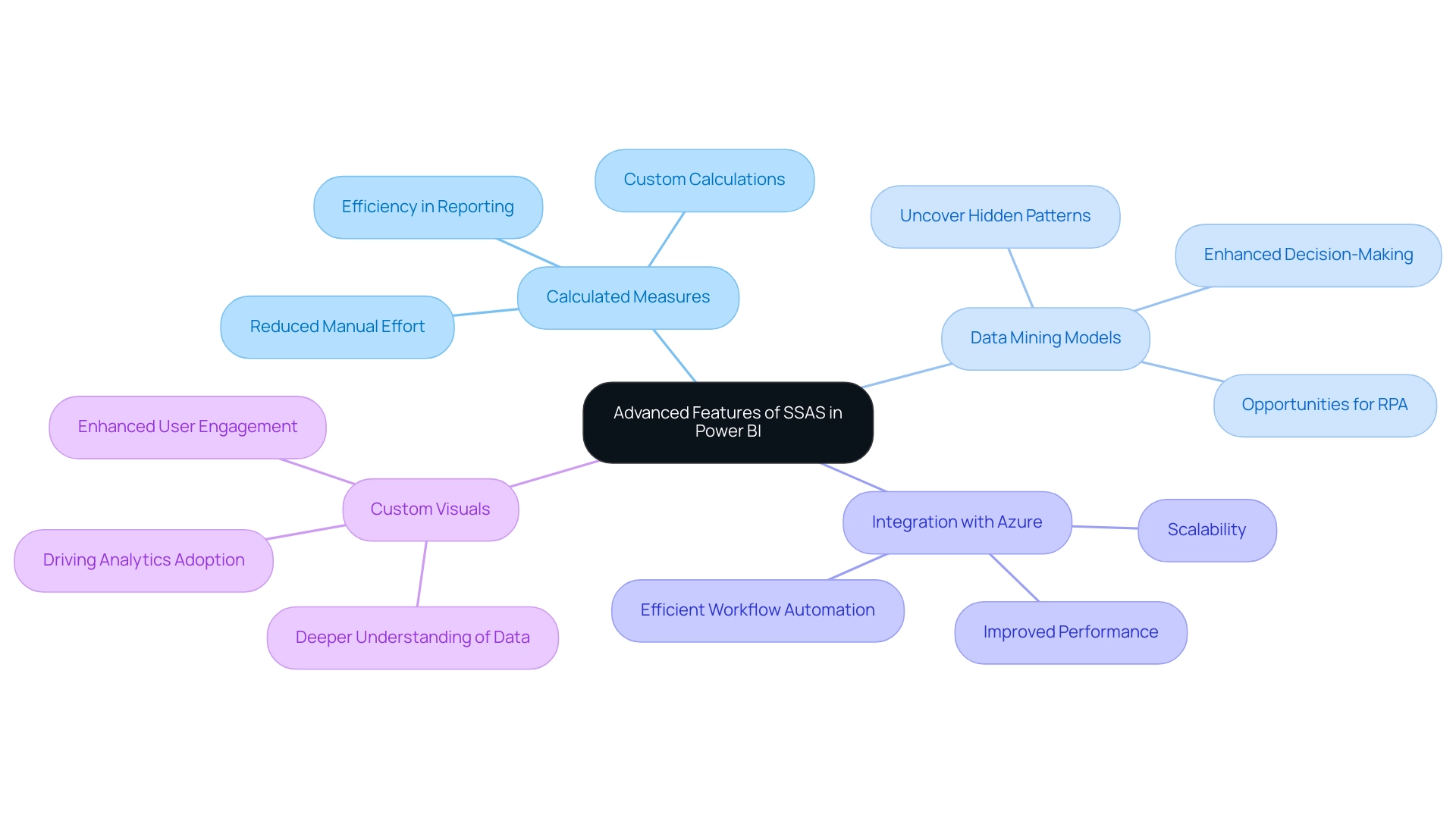
Conclusion
Harnessing the power of SQL Server Analysis Services (SSAS) in conjunction with Power BI can transform the way organizations approach data analytics and reporting. By establishing a seamless connection between these two powerful tools, businesses can create sophisticated multidimensional data models that address common challenges such as data inconsistencies and inefficiencies in report generation. This integration not only streamlines the data analysis process but also enhances the overall quality of insights derived, ultimately driving operational efficiency.
Throughout this article, critical steps for connecting Power BI with SSAS were outlined, including troubleshooting tips and best practices to optimize performance. Emphasizing the importance of data model optimization, implementing hierarchies, and maintaining data security through row-level access reinforces the necessity of a strategic approach to data management. Additionally, exploring advanced features such as calculated measures and data mining models can further empower organizations to uncover deeper insights and automate repetitive processes, maximizing the value of their data analytics efforts.
As the demand for actionable insights continues to grow in today’s data-driven landscape, leveraging the capabilities of SSAS alongside Power BI is essential for fostering growth and maintaining a competitive edge. By investing in these tools and following the best practices discussed, organizations can not only enhance their reporting capabilities but also cultivate a culture of informed decision-making that propels them toward success in their respective industries. Now is the time to embrace these solutions and unlock the full potential of data analytics for a more efficient and insightful future.
Introduction
In the realm of data management, the integration of Excel and Power BI stands as a transformative solution for organizations striving to enhance operational efficiency and decision-making. As businesses grapple with the complexities of report creation and data inconsistencies, understanding the foundational steps and best practices for utilizing the Excel Power BI add-in becomes paramount. This article delves into essential techniques for setting up, analyzing, and visualizing Power BI data within Excel, while also addressing common challenges that users may encounter. By equipping teams with practical strategies and insights, organizations can unlock the full potential of their data, driving growth and fostering a culture of informed decision-making.
Getting Started with the Excel Power BI Add-In: Prerequisites and Setup
To effectively employ the BI add-in and overcome common obstacles such as time-consuming document creation and data inconsistencies, it’s essential to establish the following prerequisites:
- Updated Microsoft Spreadsheet: Ensure you are using a version of the program that supports the Power BI add-in, preferably the 2024 version or later, which offers enhanced speed and stability. Keeping your software updated helps prevent issues that can slow down report generation and ensures compatibility with the latest features. Notably, 63% of advanced Excel users are aware that they can leverage AI functionalities within Excel, emphasizing the importance of staying current with software updates.
- BI Account: A valid BI account is essential for information access and integration. This guarantees that you possess a trustworthy source of information, minimizing inconsistencies that can occur from utilizing outdated or incorrect datasets.
- Proper Permissions: Verify that you have the necessary permissions to access the datasets within BI. Proper governance is crucial, as inconsistencies can arise from improper access rights, leading to mistrust in the data presented.
- Installation of the Excel Power BI Add-In: Navigate to the ‘Insert’ tab in the spreadsheet application, click on ‘Get Add-ins’, search for ‘Excel Power BI Add-In’, and proceed to install it. This step is essential for combining the spreadsheet application with Business Intelligence, simplifying the document creation process.
- Sign In: After installation, log in to the BI service within Excel using your credentials. This connection enables real-time information updates and ensures that your reports reflect the most current details available.
A case study on PowerExcel.ai illustrates that only 13% of overall users have utilized this add-in; however, over one-third of advanced users have found it beneficial, showcasing its appeal to this demographic. By following these fundamental steps, you will create the environment for a productive and efficient experience with the Excel Power BI add-in, ensuring that you utilize its full capability for your operations. As research expert Lionel Sujay Vailshery notes, ‘Get in touch with us now’ to explore how these tools can enhance your information management capabilities and provide clear, actionable insights tailored to your operational needs.

Analyzing Power BI Data in Excel: Techniques and Best Practices
To enhance the effectiveness of examining business intelligence information in a spreadsheet, apply the following techniques:
- Importing Data: Utilize the Excel Power BI add-in to effortlessly bring datasets into the spreadsheet. Simply select the desired dataset from the Power BI service, streamlining the retrieval process and enhancing the overall effectiveness of your Business Intelligence initiatives.
- Utilizing PivotTables: The PivotTable feature is essential for summarizing and analyzing imported information. This feature not only enhances your analysis capabilities but also supports the fact that built-in PivotTables are the most popular analytic tool, significantly simplifying complex interpretation and making it easier to derive actionable insights.
- Applying Filters: Utilize Excel’s robust filtering options to narrow down specific segments, enabling deeper insights and more focused analyses that drive operational efficiency.
- Information Exploration: Participate in exploratory information analysis by utilizing charts and graphs to visualize trends and patterns. This visual depiction of information can lead to a more intuitive comprehension and quicker decision-making, showcasing the power of effective visualization.
-
Best Practices: Adhere to visualization best practices by ensuring charts remain simple and clear, utilizing appropriate scales, and effectively labeling axes. Integrating visualization techniques with analytical functions enhances clarity and improves the communication of data-driven insights.
-
Case Study Application: Consider a case study on geospatial analysis, where Excel’s map charts and external geocoding tools enhance geographical information visualization. This real-world application illustrates how effective information analysis techniques can offer actionable insights, emphasizing the value of combining the Excel Power BI add-in with BI capabilities.
- Utilizing Key Features: Integrate the ‘3-Day BI Sprint’ to quickly create professionally designed reports that improve your reporting capabilities. Furthermore, utilize the ‘General Management App’ for thorough oversight and intelligent evaluations, ensuring that your analytics conforms to best practices.
By applying these methods, you can optimize your analysis process and reveal actionable insights from BI information, ultimately enhancing operational efficiency. As Rand Owens, VP of Marketing at Polymer Search, states,
Analyzing information on Polymer is several times quicker and more effective than traditional spreadsheets, and best of all, you won’t encounter information fatigue.
This emphasizes the significance of incorporating robust tools such as EMMA RPA and Automate into your analysis efforts, ensuring a risk-free ROI evaluation and professional execution while boosting productivity.
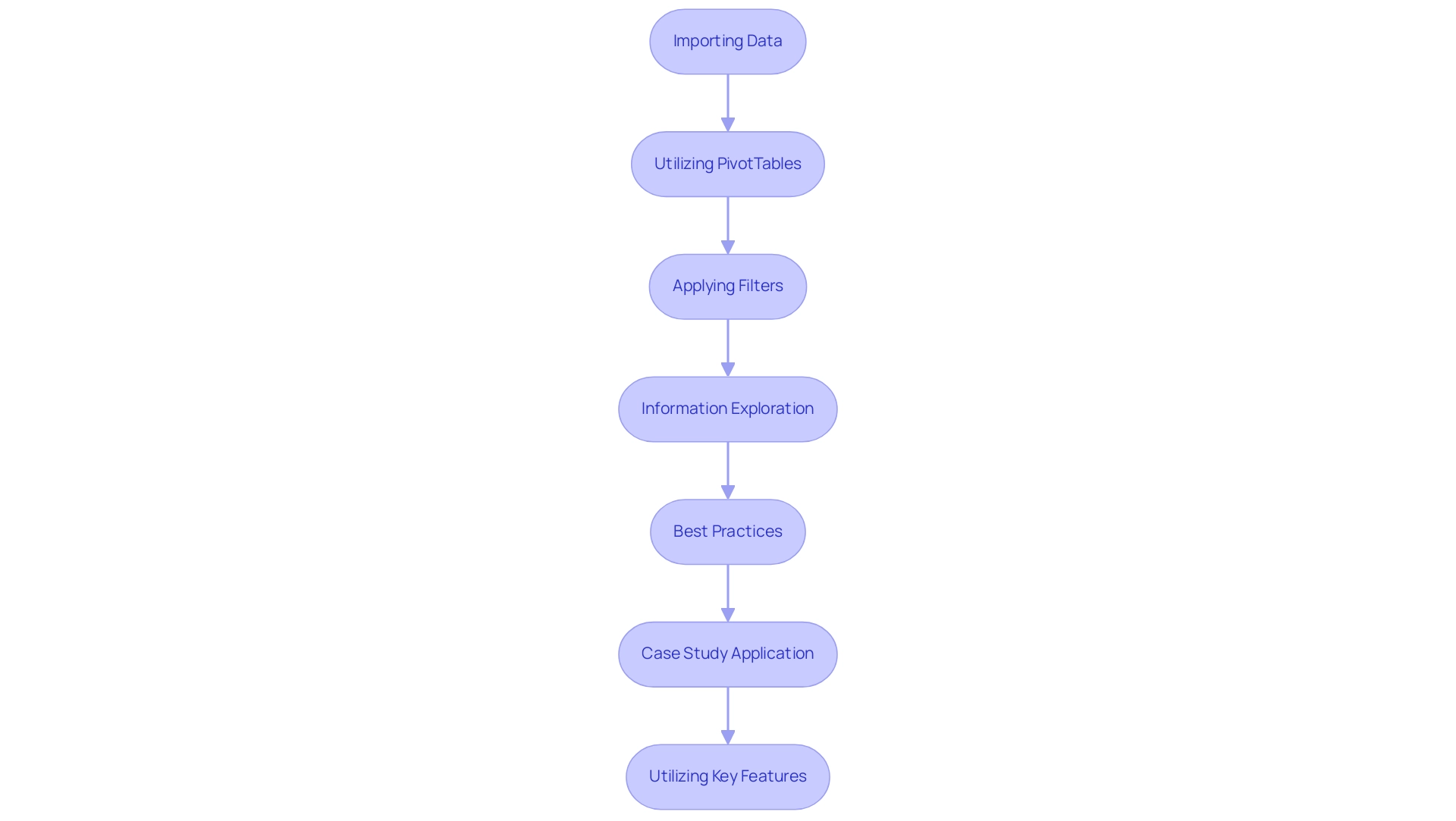
Creating Reports and Visualizations with Power BI Data in Excel
Generating meaningful reports and visual representations with BI information in a spreadsheet is a simple procedure that can greatly improve your information storytelling, ultimately fostering growth and operational effectiveness. Follow these essential steps:
- Select Your Data: Begin by importing the relevant dataset using the Excel Power BI add-in into a spreadsheet, ensuring you have access to the most current and comprehensive information.
This foundational step is crucial in addressing challenges related to information inconsistencies.
- Utilize Charting Tools: Leverage the advanced charting capabilities of this software, which have seen significant improvements recently. You can create dynamic visualizations such as bar charts, line graphs, and pie charts that effectively represent your data trends.
Notably, content related to spreadsheet charting tools has garnered significant interest, as evidenced by Natasha’s content receiving 100k views.
- Customize Your Visuals: Tailor your visuals for maximum impact. Adjust colors, labels, and titles to enhance clarity and engage your audience more effectively.
The customization options available in Excel, especially when using the Excel Power BI add-in, allow for a high degree of personalization, making your documents more relatable and actionable.
- Combine Multiple Visuals: To provide a comprehensive view of your information, consider assembling a dashboard by integrating multiple charts and tables onto a single worksheet. This approach enables thorough analysis at a glance, tackling the time-consuming nature of document creation.
For instance, the case study on ‘Customer Information Improvement Tracking’ illustrates how corrections in customer details for 10 customers were visually represented in a line chart, showing a trend of improvement over time.
- Add Interactivity: Elevate your reports by incorporating interactivity. Utilize slicers and timelines to enable users to filter and explore the information dynamically.
This feature empowers your audience to interact with the information on their terms, enhancing their understanding and retention of the content presented.
- Integrate RPA Solutions: To further enhance operational efficiency, consider utilizing RPA tools like EMMA RPA and Power Automate. These tools can automate repetitive tasks involved in information extraction and documentation generation, addressing staffing shortages and outdated systems.
By automating these processes, you can free up valuable time for your team to concentrate on strategic decision-making.
As Salvador, a Responsive Resident, noted, ‘Hi, I’ve just posted it http://community.powerbi.com/t5/Desktop/Storing-and-using-information-from-a-dynamic-data-source-usi…’—community engagement can provide additional insights into effective practices.
By following these steps, you will be equipped to produce professional, engaging documents and visualizations that clearly communicate the narrative behind your information with the Excel Power BI add-in. With the right tools and techniques, including the power of Business Intelligence and RPA, you can transform raw information into valuable insights, reinforcing the importance of insight-driven decision-making.

Maintaining and Sharing Your Power BI Reports in Excel
To efficiently manage and distribute your BI analysis in spreadsheet format, consider adopting the following recommended strategies, as emphasized in our 3-Day BI Sprint initiative:
-
Set Up Data Refresh: Enable automatic data refresh in the spreadsheet application to ensure your documents always reflect the most current data from Power BI. This practice enhances accuracy and builds trust in your reporting, allowing you to focus on leveraging insights for impactful decisions using the excel power bi add in.
-
Share Reports with Colleagues: Utilize the software’s robust sharing capabilities to foster collaboration among team members. Platforms like OneDrive or SharePoint enable seamless sharing of workbooks, ensuring everyone has access to the latest insights and can contribute to actionable outcomes.
-
Exporting Documents: For wider communication, consider exporting your documents to formats such as PDF or PowerPoint. This approach simplifies presenting insights to larger audiences, making your findings accessible to all stakeholders and driving informed decision-making.
-
Tracking Changes: Utilize Excel’s version control features to meticulously monitor alterations made to your documents. This is crucial for maintaining a clear record of modifications, ensuring all collaborators are aligned and informed, which is vital for operational efficiency.
-
Collect Feedback: Actively seek input from your team on the documents. Fostering positive feedback improves document quality and guarantees they stay pertinent and actionable, which is a key aspect of our Comprehensive BI Services.
-
Utilize Email Notifications: Consider the case of a user who sought a method to receive notifications for dataset refresh failures without having to log in to the service. By establishing a communal email account for notification forwarding, alerts regarding dataset problems can be efficiently handled, enhancing responsiveness.
By implementing these strategies, including timely information refreshes and efficient communication practices, you can ensure your BI outputs remain current and effectively conveyed among all stakeholders by utilizing the excel power bi add in, fostering a culture of transparency and collaboration that drives growth and innovation. Remember, with our 3-Day Business Intelligence Sprint, you can achieve a fully functional, professionally designed report on a topic of your choice in just three days, addressing common challenges like time-consuming report creation and data inconsistencies.
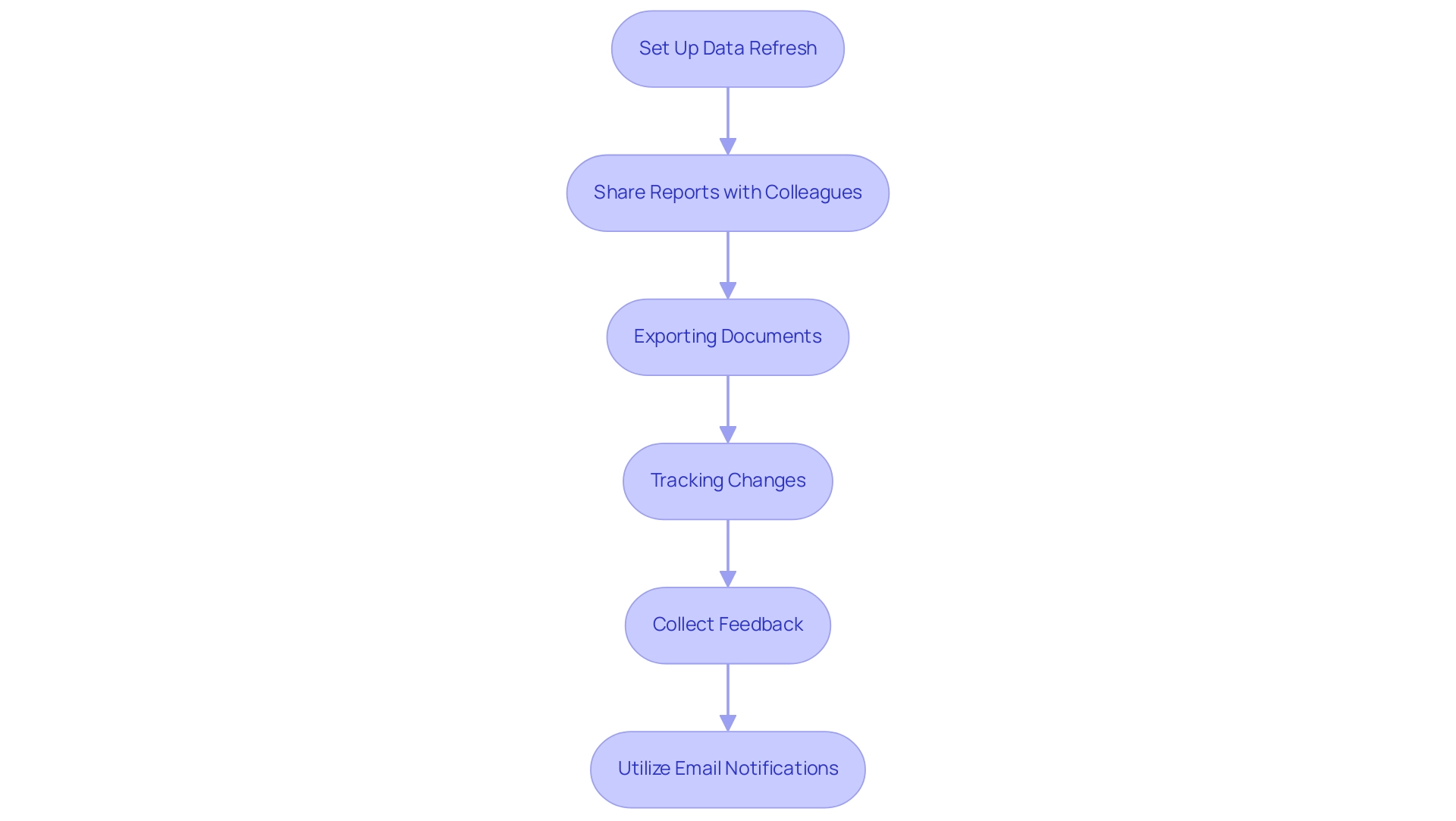
Troubleshooting Common Issues with the Excel Power BI Add-In
Utilizing the Excel Power BI add-in can present various challenges, but with effective troubleshooting strategies, you can significantly enhance your workflow. Here are common problems and solutions to help you overcome technology implementation challenges:
-
Connection Errors: If you experience connectivity issues with Power BI, first verify your internet connection and ensure you are logged into your Power BI account with the necessary permissions.
This foundational check often resolves issues quickly and efficiently, allowing you to focus on strategic tasks rather than getting bogged down by technical difficulties. -
Data Refresh Failures: Data refresh failures are a prevalent challenge, often stemming from permissions or dataset status. Confirm that you have the right access to the datasets and check that they haven’t been deleted or relocated.
Statistics related to Issue ID 447 underscore the importance of permissions management, emphasizing the need for tailored solutions in your information governance strategy. -
Performance Issues: If Excel is sluggish, consider reducing the amount of information you’re importing. Streamlining your use of PivotTables can significantly enhance performance, ensuring that you can leverage Business Intelligence insights effectively without delays.
Additionally, implementing Robotic Process Automation (RPA) can help automate repetitive tasks, further improving efficiency and allowing your team to focus on more strategic initiatives. -
Visualization Problems: If your visual representations fail to display correctly, ensure that your types align with the chart types you’ve selected. Compatibility issues often lead to frustrating visualization errors, making it crucial to pay attention to detail for clear and actionable reporting.
-
Error Messages: Error messages often provide critical insights into underlying issues. For additional context, the Microsoft support site offers explanations for specific errors, guiding you through troubleshooting effectively.
Recent discussions regarding the Data Factory issue highlight the importance of staying updated with changes that could impact your workflows and decision-making processes. By implementing these troubleshooting tips, you can resolve issues swiftly and maintain a seamless experience with the Excel Power BI add-in.
As one user, Mike Honey, noted, > Thanks Tom – that worked! < This reinforces the idea that with the right approach, common challenges can be efficiently addressed. Furthermore, recognizing the challenges of time-consuming report creation and data inconsistencies emphasizes the need for a robust governance strategy to ensure data reliability and actionable insights.
The case study related to temp tables in the Data Warehouse and SQL analytics endpoint serves as a reminder of the real-world implications of these issues, providing practical context for the solutions discussed.
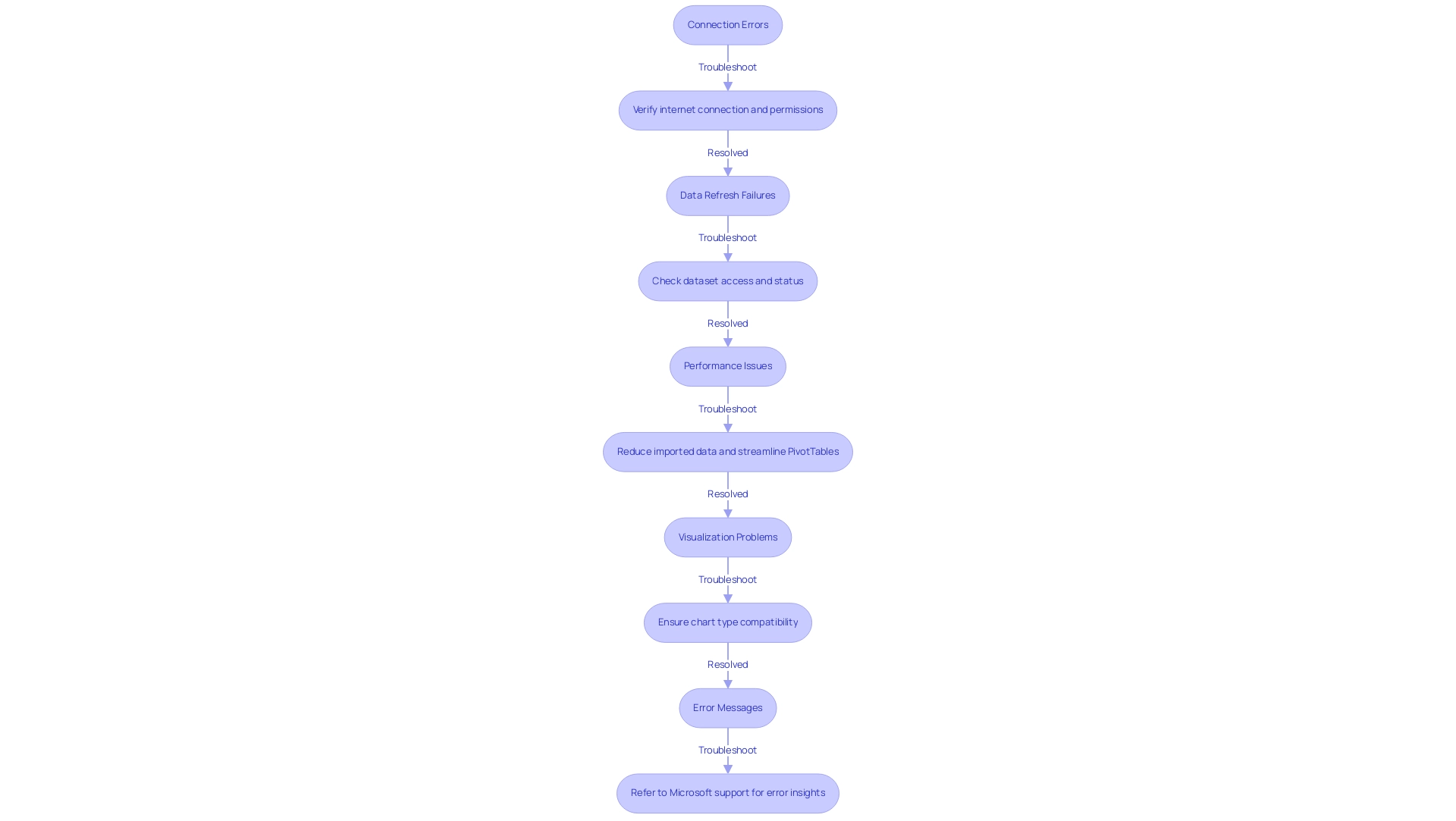
Conclusion
By effectively integrating the Excel Power BI add-in into data management workflows, organizations can overcome common challenges such as report creation delays and data inconsistencies. Establishing a solid foundation with updated software, proper permissions, and a valid Power BI account is crucial for maximizing the benefits of this powerful tool. Techniques for importing data, utilizing PivotTables, and applying filters enhance the analysis process, while best practices in data visualization ensure clear communication of insights.
Creating impactful reports and visualizations becomes a straightforward endeavor when leveraging Excel’s advanced capabilities. By selecting relevant datasets, customizing visuals, and incorporating interactivity, teams can craft engaging narratives that drive informed decision-making. Furthermore, maintaining and sharing these reports through effective collaboration and timely updates fosters a culture of transparency and innovation.
Troubleshooting common issues with the Excel Power BI add-in is essential for maintaining operational efficiency. By addressing connection errors, data refresh failures, and performance issues proactively, organizations can ensure a seamless experience that empowers teams to focus on strategic initiatives rather than technical difficulties.
Ultimately, the integration of Excel and Power BI not only streamlines data management but also unlocks the potential for data-driven decision-making. By following the outlined strategies, organizations can harness the full power of their data, leading to enhanced growth and operational success. Embracing these tools will transform challenges into opportunities, fostering a culture of informed insights that propel organizational effectiveness.
Introduction
In the realm of data analytics, mastering Data Analysis Expressions (DAX) is essential for anyone looking to unlock the full potential of tools like Power BI and Excel. As organizations increasingly rely on data-driven insights to enhance operational efficiency, understanding the fundamentals of DAX becomes a powerful asset.
This article serves as a comprehensive guide for beginners, delving into the core principles of DAX, essential functions, and practical strategies for overcoming common challenges. By equipping oneself with this knowledge, users can transform raw data into meaningful insights, streamline reporting processes, and drive significant improvements in decision-making and overall business performance.
Whether navigating the syntax, exploring key functions, or troubleshooting errors, this journey into DAX promises to empower users to elevate their data analysis capabilities and foster a culture of informed decision-making in their organizations.
Understanding DAX: The Basics Every Beginner Should Know
Data Analysis Expressions (DAX) is a robust formula language employed across Microsoft tools like BI and Excel to define custom calculations and queries that drive advanced analytics. To attain operational efficiency and unleash the full potential of your analytics capabilities, it is essential to learn DAX Power BI, especially in today’s swiftly changing AI environment. Notably, a statistic reveals that 54% of companies are considering using cloud and business intelligence (BI) in their analytics, underscoring the growing importance of DAX in the field.
Here are the essential concepts every beginner should grasp:
- What is DAX?
DAX is intended for creating calculated columns, measures, and tables within BI.
It empowers users to execute complex calculations on their models, enhancing the depth of analysis. For instance, to learn DAX Power BI, one can see how it converts unprocessed information into dynamic dashboards and reports, supporting evidence-based decision-making and contributing to overall operational efficiency.
Basic Syntax:
DAX formulas initiate with an equal sign =, followed by the function name and its respective arguments enclosed in parentheses.
For example, SUM(Sales[Amount]) computes the total sales amount, showcasing how straightforward yet powerful DAX can be.
-
Types:
A solid understanding of DAX types, including numbers, strings, and dates, is crucial as they significantly influence how calculations are processed. Valid dates in the Date type encompass all dates after March 1, 1900, emphasizing the importance of integrity in your analysis. -
Functions:
DAX provides a diverse range of operations, encompassing aggregation operations (e.g., SUM, AVERAGE), logical operations (e.g., IF), and date operations (e.g., YEAR, MONTH). Mastering these functions will greatly enhance your ability to manipulate and analyze information effectively, aligning with the operational goals facilitated by RPA technologies. -
Context:
Recognizing the differences between row context and filter context is vital in DAX.
These contexts dictate how calculations are assessed based on the particular information you are interacting with, forming the basis for creating effective DAX expressions.
In addition to these foundational principles, utilizing BI services can significantly improve your reporting capabilities. For instance, the 3-Day BI Sprint allows for the rapid creation of professionally designed reports, while the General Management App provides comprehensive management and smart reviews. By integrating these features, organizations can streamline their reporting processes and improve operational efficiency. By mastering these fundamental principles, you will be well-equipped to learn DAX Power BI, which will allow you to explore the more intricate aspects of DAX and ultimately lead to improved data-driven decision-making and operational efficiencies.
Moreover, Netflix’s use of analysis exemplifies how effective utilization through DAX can lead to significant cost savings and operational efficiency, highlighting the importance of learning DAX Power BI in modern analytics. As you contemplate incorporating RPA solutions such as EMMA, keep in mind that to learn DAX Power BI can revolutionize your reporting and improve your overall business functions, enabling the automation of manual workflows and fostering strategic insights.
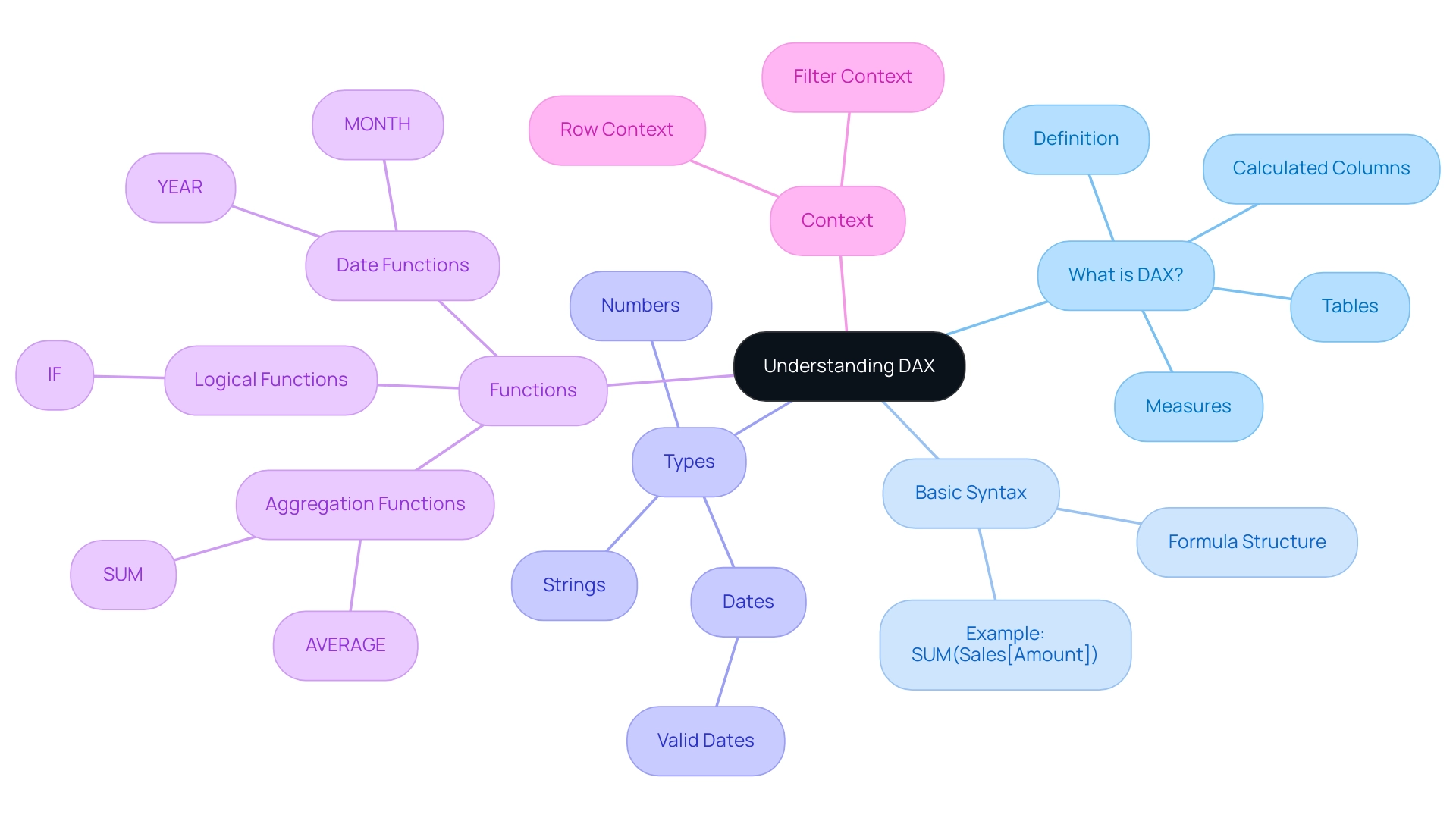
Step-by-Step Learning Path: Resources and Techniques for Mastering DAX
To master DAX effectively and overcome the common challenges in leveraging insights from BI dashboards, including time-consuming report creation and data inconsistencies often exacerbated by a lack of governance strategy, follow this structured learning path:
-
Begin with Online Courses: Explore platforms such as Coursera, Udemy, and LinkedIn Learning, which offer a variety of comprehensive courses on DAX and Business Intelligence. Opt for beginner-level courses that lay a strong foundation and progressively introduce advanced concepts, ensuring a seamless learning experience. With affordable monthly installment options starting at 566 USD for the first installment and 567 USD for the second and third installments, this is a manageable investment in your skill development.
-
Delve into Recommended Books: Enhance your understanding with insightful literature like ‘The Definitive Guide to DAX’ by Marco Russo and Alberto Ferrari. This book offers thorough explanations and practical examples, making complex DAX concepts accessible and applicable to real-world scenarios, helping to establish a clearer governance framework for your data.
-
Engage in Hands-On Practice: Practical application is essential. Utilize sample datasets available within BI or source datasets online to create your own reports and dashboards. Experiment with crafting DAX formulas to observe their impact on your analysis, thereby addressing the issues of time-consuming report creation and inconsistencies.
-
Connect with Online Communities: Join vibrant online forums and communities such as the BI Community and Stack Overflow. These platforms provide opportunities to ask questions, seek advice, and learn from the experiences of fellow learners and experts, fostering an environment of shared knowledge and support.
-
Utilize Microsoft Documentation: The official Microsoft documentation for DAX serves as an invaluable resource, offering detailed explanations of functions, syntax, and practical examples that will deepen your comprehension of DAX and enhance your ability to provide actionable insights, including guidance on establishing a governance strategy to ensure consistency.
-
Participate in Workshops and Webinars: Actively seek out webinars and workshops led by industry experts. Engaging with these sessions, as emphasized by Fabio, a tutor with experience as both an online learner and educator, delivers insights into best practices and real-world applications of DAX, enriching your learning experience and helping you guide your team effectively.
-
Explore Practical Learning Resources: Consider utilizing the ‘Best BI YouTube Tutorials’ by Chandoo. This collection encompasses a broad spectrum of subjects from fundamentals to advanced methods, offering practical abilities in loading information, modeling, DAX, and developing dashboards, featuring actionable strategies that can be applied in your reporting processes.
By adhering to this organized learning path, you will foster a strong foundation in DAX, enabling you to leverage its full capability in BI for effective analysis and reporting, thus overcoming the common challenges in your operations.
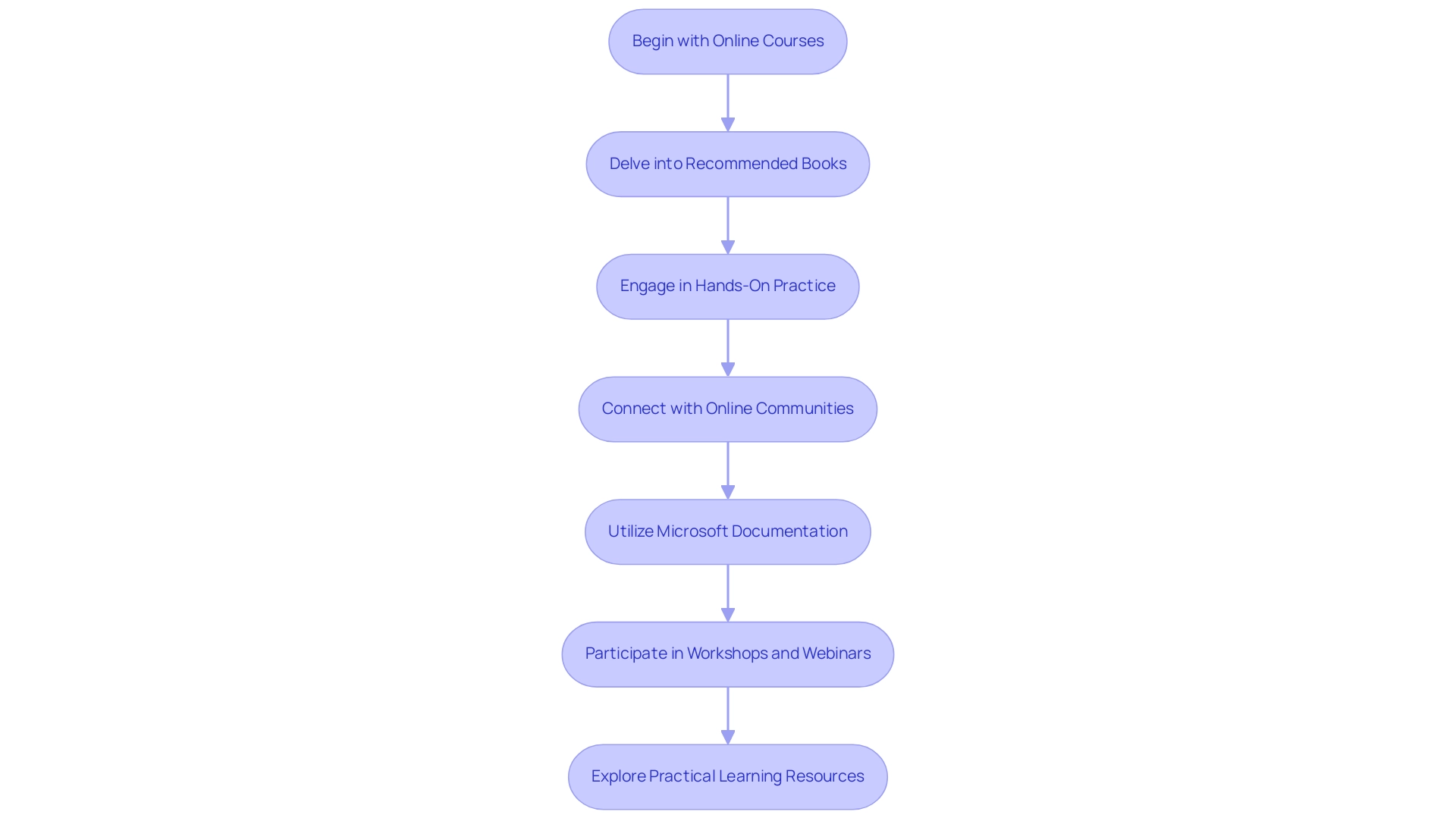
Common DAX Functions: A Beginner’s Guide
Mastering common DAX operations is crucial for enhancing your analytics capabilities within Business Intelligence, especially when you learn DAX Power BI, considering the significance of user accessibility and information quality. In today’s information-rich environment, leveraging Business Intelligence effectively can help overcome challenges such as time-consuming report creation and inconsistencies. Users can log in using Google or email and confirm their identity through OTP, guaranteeing secure access to robust analytical tools.
Furthermore, as Medunoye Kehinde highlights, profiling information is essential in Power BI for analyzing content for patterns and inconsistencies, which is important when employing DAX operations to learn DAX Power BI and ensure precise outcomes. Addressing poor master data quality is essential for maximizing the insights derived from your dashboards. Here are some key roles you should familiarize yourself with:
- SUM: This operation aggregates all the numbers in a specified column. For instance, using
SUM(Sales[Amount])will yield the total sales amount, providing a quick overview of sales performance. - AVERAGE: To calculate the average of a set of values, you can utilize the
AVERAGEformula. For example,AVERAGE(Sales[Amount])computes the average sale, helping in assessing overall sales trends. - COUNT: This method counts the number of rows in a column that contain numbers. Using
COUNT(Sales[Amount])will tell you the total number of sales transactions, giving insight into transaction volume. - CALCULATE: This powerful feature allows you to alter the context in which information is assessed. For example,
CALCULATE(SUM(Sales[Amount]), Sales[Region] = 'North')calculates total sales exclusively for the North region, enabling targeted analysis. - FILTER: This operation returns a table that is filtered based on specified conditions. For instance,
FILTER(Sales, Sales[Amount] > 100)retrieves all sales transactions where the amount exceeds 100, allowing for focused examination of higher-value transactions. - RELATED: This operation fetches associated values from a different table, which is especially beneficial when handling relationships in your information model. For example,
RELATED(Customers[CustomerName])retrieves the customer name associated with a sale, facilitating deeper insights into customer behavior.
Additionally, the DAX library includes features like Measures for dynamic calculations, Calculated Columns for storing computational results, and Row-level Security to maintain information integrity. These characteristics guarantee adaptability in information operations and secure access to tables, improving the overall capability of BI.
Getting acquainted with these capabilities will not only increase your confidence in composing DAX formulas but will also help you learn DAX Power BI and enhance your analysis skills in BI. As Yana Khare aptly notes, > Integration and Collaboration: Power BI works well with Microsoft Excel, Azure, and SharePoint tools <, which underscores the need to learn DAX Power BI capabilities in a collaborative environment. By harnessing the power of BI and RPA, such as EMMA RPA and Power Automate, you can transform raw data into actionable insights that drive growth and operational efficiency.
Significantly, not utilizing data-driven insights can put your business at a competitive disadvantage, emphasizing the importance of mastering these tools and capabilities.
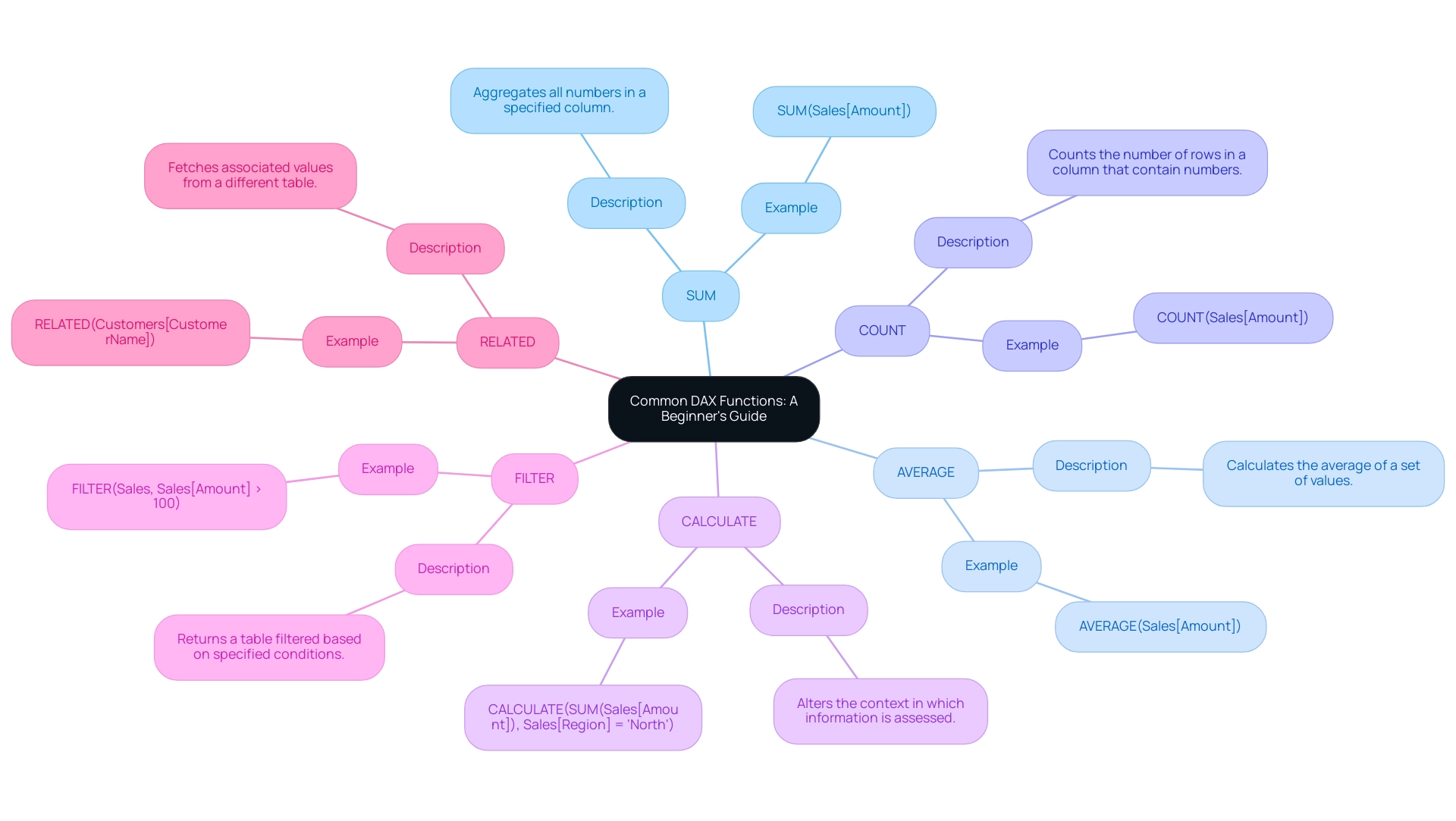
Troubleshooting Common DAX Errors
As you learn DAX Power BI, encountering errors is an inevitable part of the process. Understanding these common issues and how to troubleshoot them is essential for mastering DAX. Here are some prevalent errors you might face, along with effective solutions:
-
Syntax Errors:
These often arise from mistakes in the formula structure. Incorrect names of operations, missing parentheses, or misplaced commas can lead to confusion. Utilize the formula bar in Power BI to pinpoint and rectify these errors, ensuring your formulas are correctly structured. -
Data Type Mismatches:
DAX operations are stringent about types. For instance, attempting mathematical operations on text values will trigger an error. Always confirm that the formats in your columns match the specifications of the operations you use. -
Context Errors:
Receiving unexpected results may indicate a misunderstanding of row context versus filter context. It’s crucial to grasp how these contexts impact your calculations. Review and adjust your formulas based on this understanding to achieve desired results. -
Circular Dependency Errors:
This issue occurs when a formula inadvertently refers back to itself, creating a loop. To resolve this, inspect your calculated columns and measures for any circular references and redesign them to eliminate this complication. -
Missing Relationships:
If errors occur while using related tables, it’s essential to verify that the relationships within your information model are correctly established. Without proper relationships, operations like RELATED will not work as intended, leading to further complications. -
Division by Zero Errors:
This common issue occurs when a DAX formula attempts to divide a number by zero, which is undefined. Users should check the data for zero or missing values and adjust the DAX formula to handle these cases appropriately. For instance, using the IF formula to check for zero before performing division can prevent this error.
By familiarizing yourself with these common errors and their solutions, you can effectively learn DAX Power BI and navigate the challenges associated with it. Joleen Bothma emphasizes,
Learn DAX Power BI to discover the fundamental DAX syntax and functions you’ll need to take your BI skills to the next level.
Additionally, consider best practices for writing DAX formulas:
– Use descriptive names
– Comment your code
– Organize and format it well
– Avoid hard-coded values
– Prefer measures over calculated columns
Embracing this proactive approach will not only enhance your proficiency but also empower your continued growth in leveraging DAX.
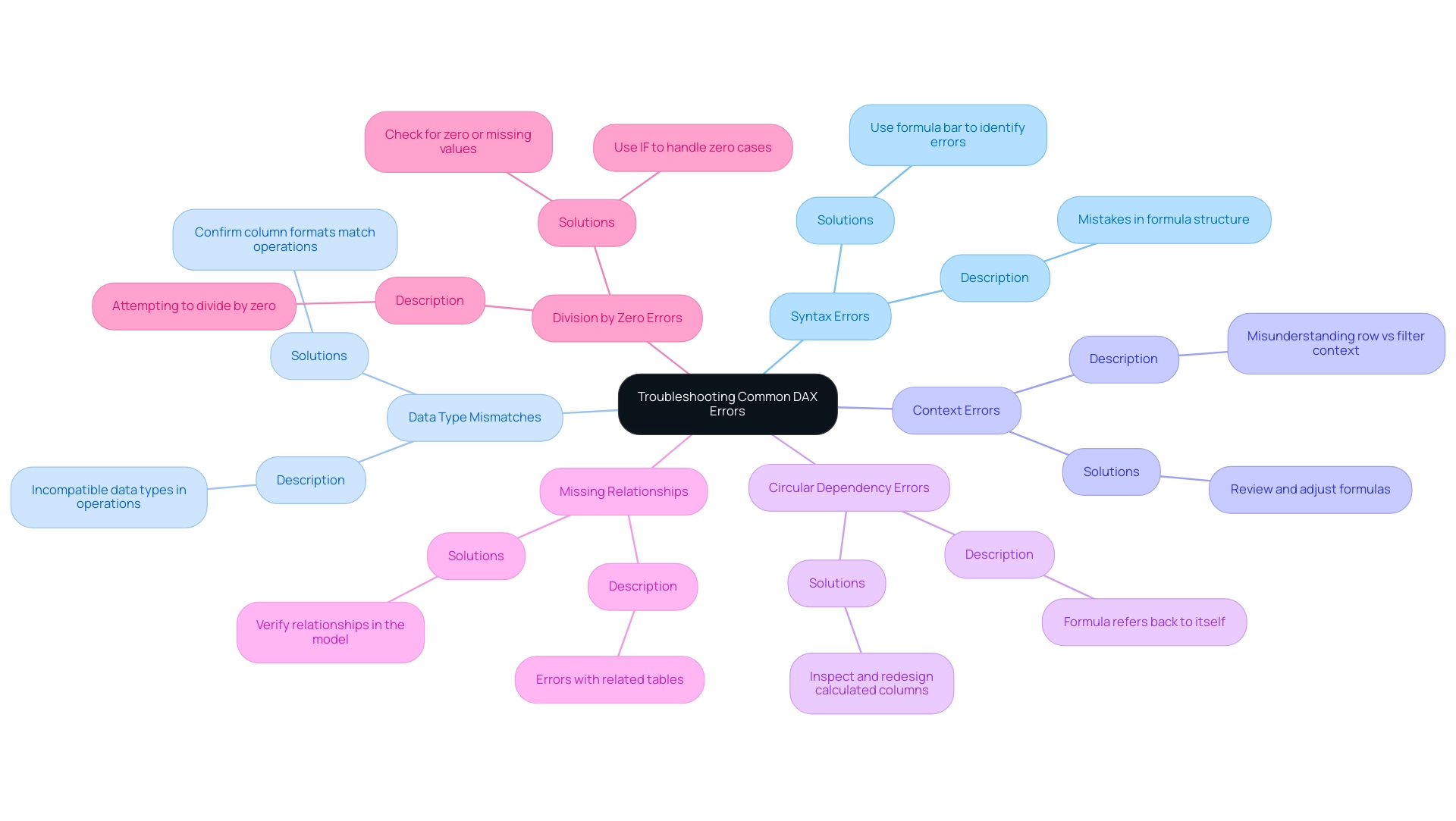
Building Your First DAX Measure
To learn DAX Power BI, creating your first DAX measure in Power BI is a straightforward process that can significantly enhance your analysis capabilities, particularly in overcoming the challenges of time-consuming report creation and inconsistencies. However, keep in mind that disabling usage metrics for your organization can impact access to existing reports and information, which are crucial for effective analysis. Furthermore, implementing a governance strategy is crucial to ensure consistency across reports, which can further enhance the reliability of your insights.
Follow these essential steps to ensure you harness the full potential of your data:
- Open Power BI Desktop: Begin by launching the application and loading your model to ensure you are working with the correct dataset.
- Navigate to the Data View: Select the ‘Data’ icon on the left sidebar to access your tables for a clear overview of your information.
- Create a New Measure: Within the ‘Modeling’ tab, click on ‘New Measure.’ This action will prompt a formula bar to appear at the top of your workspace, ready for your input.
- Write Your DAX Formula: To familiarize yourself with DAX functions, start by calculating total sales. Input the following formula:
Total Sales = SUM(Sales[Amount]). This formula effectively aggregates the values in the ‘Amount’ column of the ‘Sales’ table, providing a foundational understanding of DAX. Additionally, consider how you can learn DAX Power BI measures to utilize them for projecting active users, as seen in recent developments where calculations include total active users and average active users per day. RPA can enhance this process by automating repetitive tasks, allowing you to concentrate on analysis rather than information management. - Press Enter: After entering your formula, hit Enter. Your new measure will be visible in the Fields pane, ready for utilization.
- Use Your Measure in Visuals: To bring your measure to life, simply drag and drop it into a report visual. This allows you to create insightful charts or tables that leverage your measure for analyzing total sales.
As John Doe, a Data Analyst, observes, “By comparing projections with actual figures month after month, I can refine the model to make increasingly precise predictions, ensuring that decision-makers are equipped with trustworthy, information-driven insights as early as possible.” By following these steps, you will have confidently created your first DAX measure, which will help you learn DAX Power BI and establish a solid foundation for more advanced analysis. This accomplishment marks a vital milestone in your journey to mastering Power BI and improving your organization’s operational efficiency, transforming raw data into actionable insights.
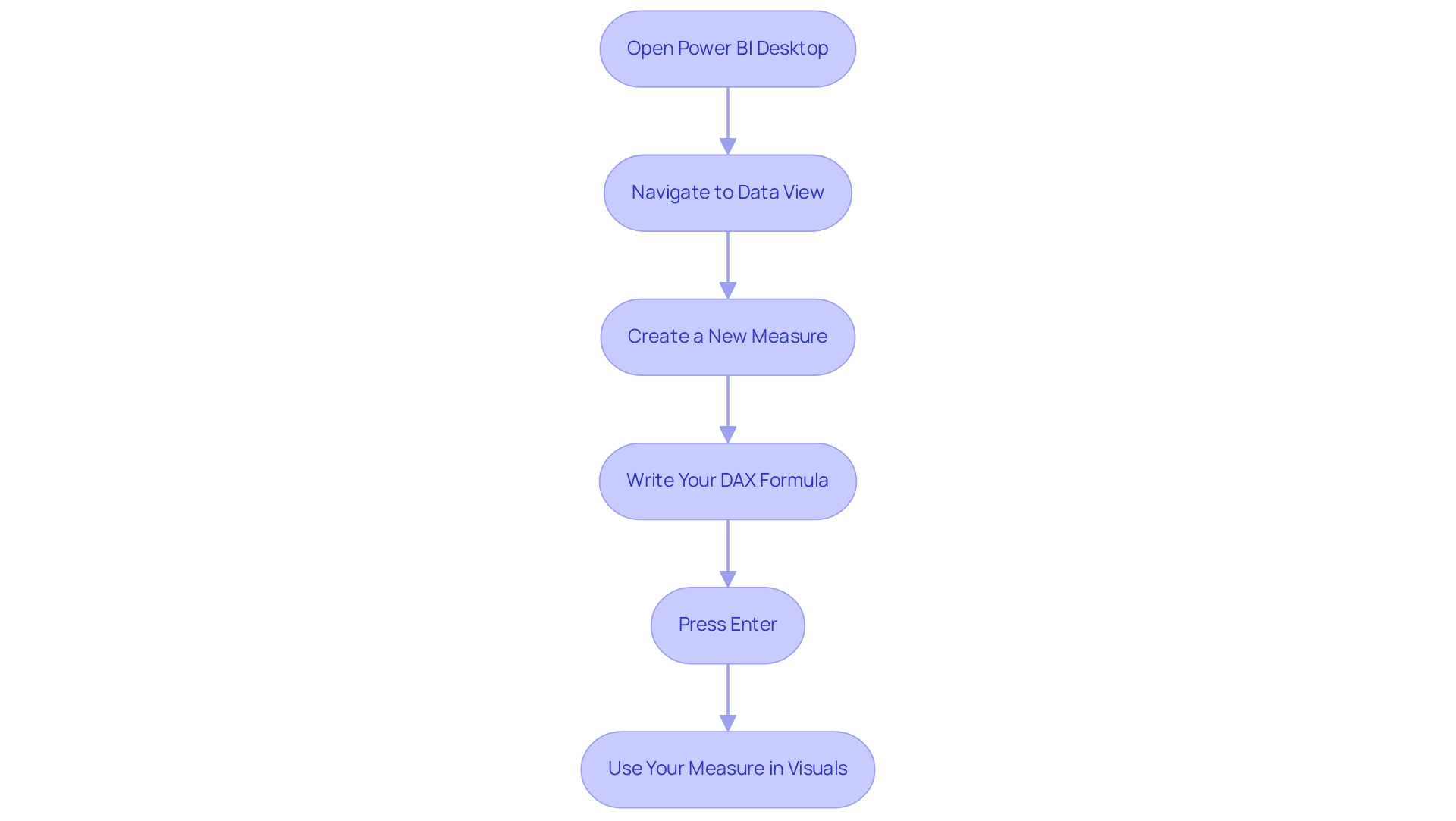
Conclusion
Mastering Data Analysis Expressions (DAX) is an essential skill for anyone looking to harness the full potential of data analytics tools like Power BI and Excel. This article has provided a comprehensive overview of the key concepts, from understanding the basics of DAX and its syntax to exploring common functions and troubleshooting errors. By familiarizing oneself with these elements, users can effectively transform raw data into actionable insights that drive decision-making and enhance operational efficiency.
The structured learning path outlined offers practical steps for mastering DAX, ensuring a solid foundation through online courses, recommended literature, and hands-on practice. Engaging with communities and leveraging Microsoft’s resources further enriches the learning experience, enabling users to overcome common challenges associated with data reporting and analysis.
Ultimately, embracing DAX equips individuals and organizations to navigate the complexities of data analytics confidently. By implementing the strategies discussed, users can not only streamline their reporting processes but also foster a culture of data-driven decision-making that propels business performance. The journey to mastering DAX is not just about learning a language; it’s about empowering oneself to unlock insights that can lead to significant operational improvements and strategic advantages in today’s data-centric landscape.
Introduction
In the rapidly evolving landscape of data management, organizations are increasingly turning to Power BI dataflows as a powerful solution to streamline their data integration and reporting processes. This innovative feature not only simplifies the connection and transformation of data from multiple sources but also enhances operational efficiency by minimizing redundancy and fostering collaboration among teams.
Through the strategic utilization of dataflows, businesses can overcome common challenges related to data handling, paving the way for insightful reporting and data-driven decision-making.
By exploring best practices, common pitfalls, and integration strategies, organizations can unlock the full potential of Power BI, ensuring they remain competitive in today’s data-driven environment.
Understanding Dataflows in Power BI
Dataflows in BI represent a revolutionary aspect that allows users to effortlessly link, modify, and load information from various origins into a cohesive repository, efficiently addressing obstacles in technology implementation. This capability not only improves information management but also establishes the foundation for insightful reporting and analysis. Using Query, workflows outline crucial transformation steps that can be reused across various BI presentations, ensuring consistency and efficiency in information handling.
Wisdom Wu, a Community Support expert, emphasizes, ‘Based on my learning, you can use a Power BI semantic model to build a dataflow monitoring report. First, create a new streaming dataset. Then, enter the following values.’
This practical insight emphasizes the necessity of mastering dataflows for effective data management. Additionally, a recent case study titled ‘Detecting Orphaned Information Streams’ highlights user challenges in developing processes to identify orphaned information streams, revealing the critical need for timely implementation to avoid setbacks. The Fabric community’s report of 2,392 users online reflects a growing interest in utilizing these tools effectively.
Furthermore, the experience of a user who was sidetracked for 1 year, 9 months, and 7 days before building their solution illustrates the hurdles organizations may encounter in adopting dataflows. By mastering these capabilities, organizations can optimize their information ingestion processes, minimize redundancy, and foster greater collaboration among teams. This strategic approach not only streamlines information preparation but also positions businesses to make informed decisions based on dependable information, enhancing operational efficiency and driving innovation.
To further improve information reporting and actionable insights, our BI services include:
- A 3-Day BI Sprint for rapid creation of documents
- A General Management Application for thorough oversight and intelligent evaluations
Additionally, leveraging RPA can automate repetitive tasks within this workflow, significantly improving efficiency and reducing errors, allowing teams to focus on strategic initiatives.
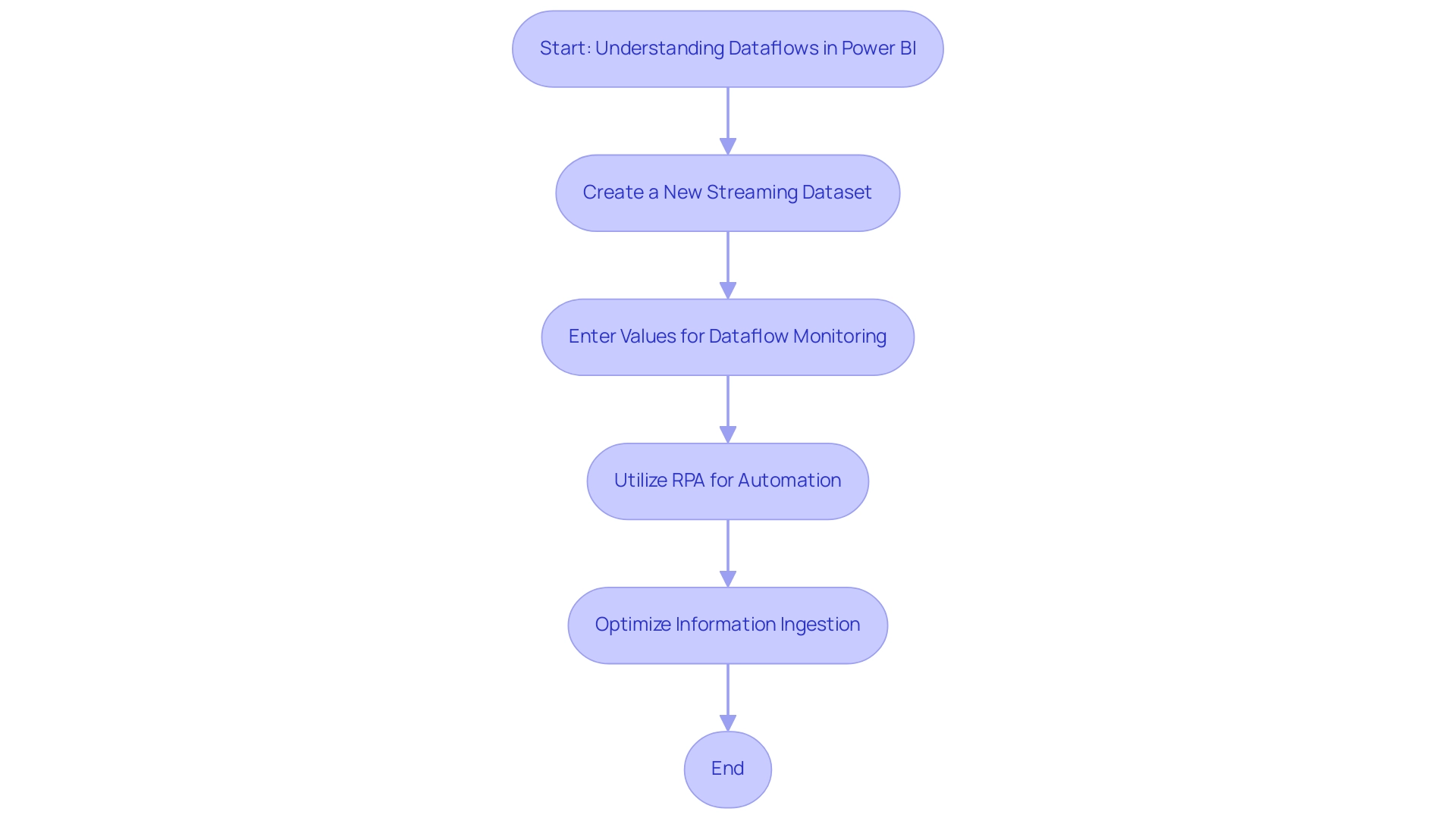
Step-by-Step Guide to Creating Dataflows
-
Access BI Service: Begin by logging into your BI account and navigating to the specific workspace where you wish to create your dataflow. Ensuring you have the right access is crucial, especially as certain features, such as computed tables, are only available to Premium subscribers.
-
To create a new dataflow, initiate the process by clicking on ‘Create’ and selecting ‘Dataflow’ from the dropdown menu. This simple step establishes the foundation for your information integration efforts, overcoming common challenges of time-consuming report creation.
-
Define Entities: In the Power Query editor, connect to your various information sources. You can enhance your connections by selecting ‘Add new entities,’ allowing you to incorporate multiple streams efficiently. Defining entities accurately is crucial to prevent inconsistencies and common user mistakes that can occur during the creation of dataflows.
-
Transform Information: Utilize Query to apply essential transformations to your information. This process might involve filtering out unnecessary information, merging datasets for comprehensive analysis, and organizing your information according to your reporting needs. Remember, the transformations you perform will execute on the information in Power BI dataflows storage, not on the external source itself, ensuring your insights are actionable.
-
Save and Refresh: Once your transformations are complete, save the dataflow. Establish a refresh schedule to ensure your information remains current and accurately reflects any changes in the underlying source. This is essential for preserving the accuracy of your documents and fostering ongoing enhancement in operational efficiency.
-
Employ Dataflows in Documentation: Once you have established your dataflows, they can be effortlessly incorporated as a source in your BI documentation. This integration ensures consistent information usage across various reports, enhancing the overall efficiency of your business intelligence efforts. Avishek Ghosh, an analytics expert, emphasizes that understanding these foundational aspects can greatly influence your analytical capabilities in BI. Furthermore, as emphasized in the case study on creating computed tables, once activated, any transformations on the computed table are performed on the information in BI dataflows storage, not on the external information source.
As Nikola perceptively pointed out, while it may appear intricate initially, each topic can be examined further in following articles, laying the groundwork for deeper comprehension and mastery of dataflows in BI. By following these steps, you will not only streamline your data integration processes but also position your organization to leverage real-time insights effectively, driving growth and innovation. Furthermore, integrating RPA solutions such as EMMA RPA and Automate can significantly enhance operational efficiency, allowing your team to focus on strategic initiatives rather than repetitive tasks.
Remember, failing to leverage Business Intelligence can leave your organization at a competitive disadvantage in today’s data-driven landscape.
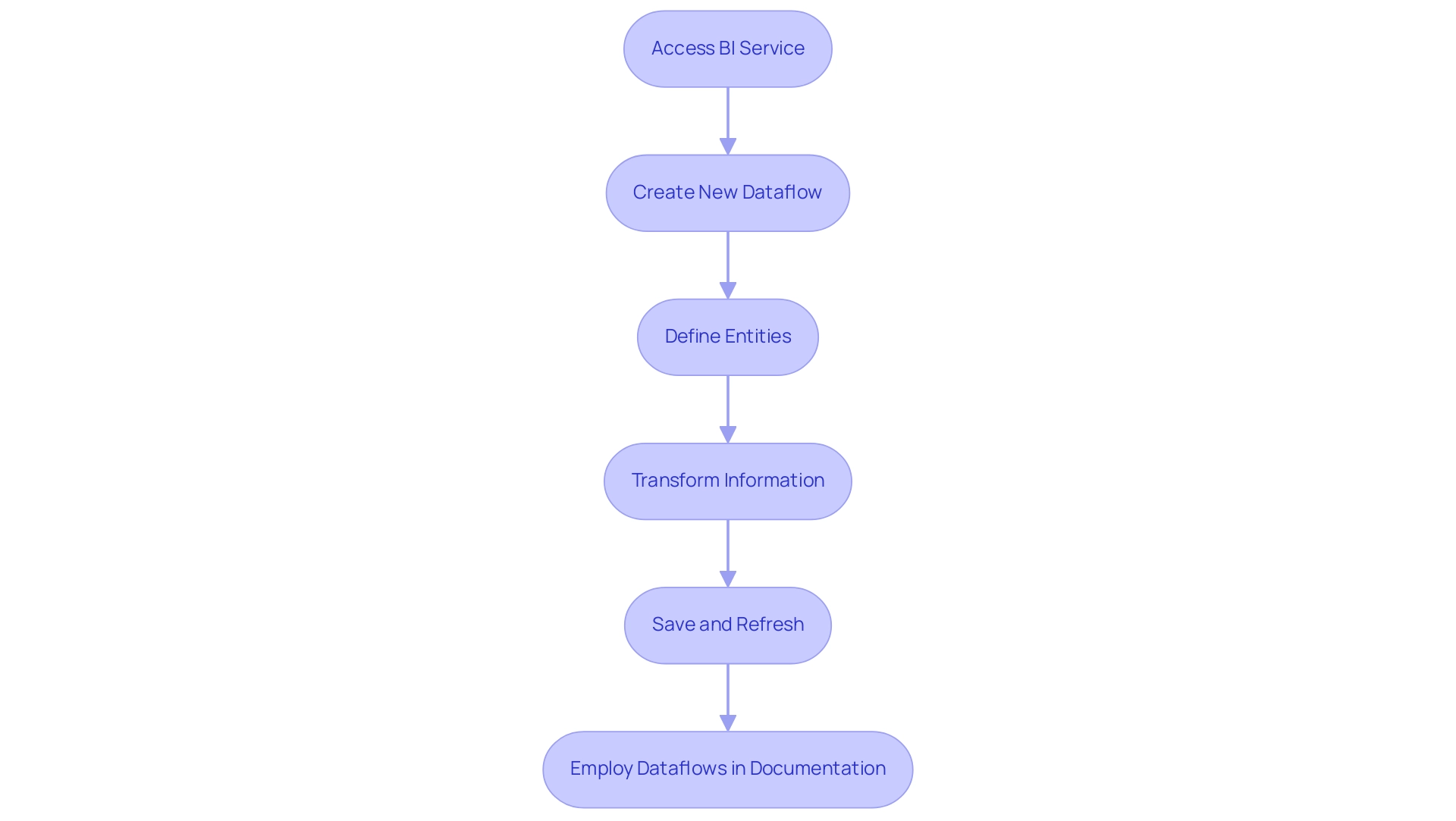
Best Practices for Optimizing Power BI Dataflows
-
Keep dataflows simple by streamlining your dataflows and avoiding overly complex transformations. Break down large processes into smaller, manageable components. This not only enhances performance but also simplifies troubleshooting and maintenance, ensuring a user-friendly approach akin to solutions like Power Automate and EMMA RPA, which are both AI-powered and designed for accessible automation.
-
Use Incremental Refresh: For organizations dealing with extensive datasets, implementing incremental refresh is crucial. This approach enables you to refresh only the new or modified information, minimizing load times significantly. According to a case study titled “Incremental Refresh,” this strategy optimizes data loading processes and reduces unnecessary data processing, ultimately enhancing operational efficiency and supporting risk-free ROI assessment.
-
Monitor Performance: Regularly evaluate the efficiency of your data streams. Tracking usage patterns and refresh times enables you to identify bottlenecks and optimize processes effectively. Ongoing performance monitoring guarantees that your information streams stay efficient and responsive to shifting demands, utilizing the power of automation for business intelligence.
-
Document Dataflows by maintaining comprehensive documentation of your dataflow processes. Clear documentation aids in troubleshooting and serves as a valuable resource for onboarding new team members, fostering a collaborative environment and enhancing productivity.
-
Leverage Parameters: Utilize parameters to create adaptable processes that can seamlessly transition between different environments or datasets. This flexibility reduces the need for extensive modifications, allowing for quicker adjustments to meet evolving business needs.
As m_alireza, a Solution Specialist, points out, the choice between a shared dataset and a data flow -> dataset model can impact efficiency. He notes, “Once you grow larger, our team personally found issues with the golden dataset approach as well. It soon became unmanageable as more tables were added.
Refresh times were becoming too slow.” This highlights the importance of considering the organization’s size and governance when designing effective dataflows. Additionally, the recommendations in this section are informed by the expertise of Aaron Stark, who holds 7 Microsoft Certifications, underscoring the credibility of these best practices and the significance of RPA and business intelligence in driving data-driven insights for operational growth.
For further insights and personalized guidance, we encourage you to Book a free consultation to explore how EMMA RPA and Power Automate can transform your business operations.
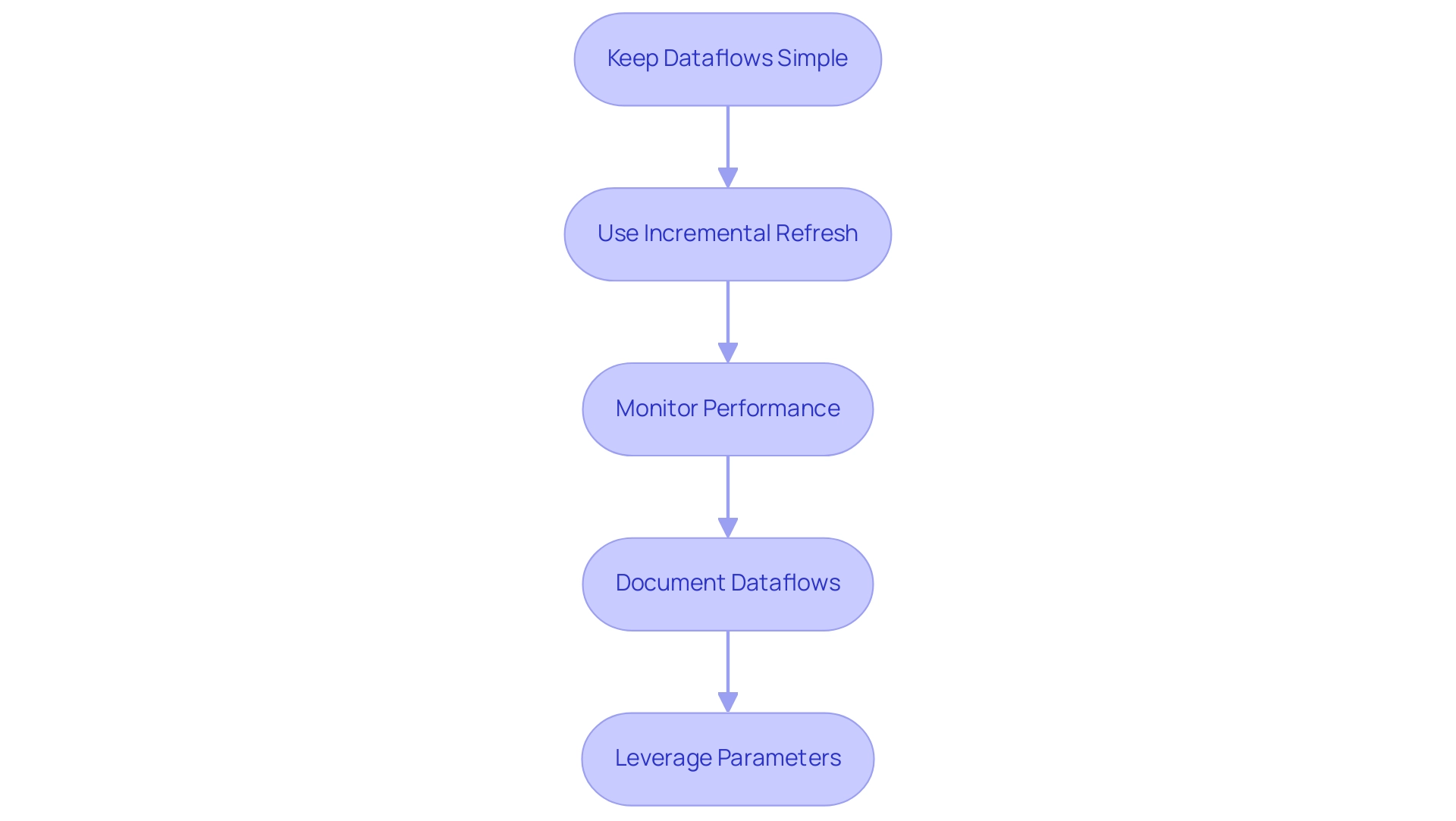
Common Challenges and Solutions in Dataflows
-
Information Refresh Failures: When facing dataflows refresh failures, it’s essential to first verify your source credentials. Ensure they are current and that the source information is both accessible and correctly formatted. Recent statistics indicate that many organizations struggle with refresh failures due to misconfigured dataflows, making this initial check crucial. Furthermore, using Usage Metrics can offer insights into how your dashboards and documents are being utilized across your organization. As a Microsoft employee notes, ‘If you have edit access to that dashboard or report, or have a Pro license, you can use Usage Metrics to discover how those dashboards and reports are being used, by whom, and for what purpose.’ Understanding this usage can help identify potential issues leading to refresh failures and enable your team to automate responses effectively.
-
Performance Issues: Slow dataflows can greatly impede operational efficiency. To tackle this, concentrate on optimizing transformations and minimizing the amount of information processed. Implementing query folding—where feasible—can greatly enhance performance. As Marcus Wegener, a Full Stack Power BI Engineer at BI or DIE, emphasizes, maximizing information utility often hinges on these performance optimizations. By integrating RPA into your workflow, you can automate routine performance checks and adjustments, streamlining operations further while reducing errors and allowing your team to concentrate on more strategic initiatives.
-
Information Quality Issues: Inconsistent information can lead to flawed reports and decision-making. To combat this, establish robust validation checks within your dataflows. These checks assist in identifying and correcting errors early in the processing pipeline, ensuring higher quality outputs. Leveraging RPA can automate these validation processes, improving data integrity and reliability.
-
Integration Challenges: Integrating various services with dataflows can present compatibility issues. To prevent disruptions, confirm that all configurations are correct and compatible with the services you’re integrating. Utilize Bi’s extensive documentation and community forums for tailored guidance and solutions. Additionally, adopting a customized AI solution can help navigate these integration challenges, aligning technologies with your specific business goals and challenges in the rapidly evolving AI landscape.
Furthermore, the Automatic Refresh Attempts Tracking feature in Business Intelligence provides valuable insights into refresh history, allowing users to visualize all refresh attempts and understand the reasons behind delays or failures. This functionality is crucial for improving the management of dataset refreshes and addressing common challenges effectively, ultimately enhancing your operational efficiency and enabling informed decision-making through actionable insights.
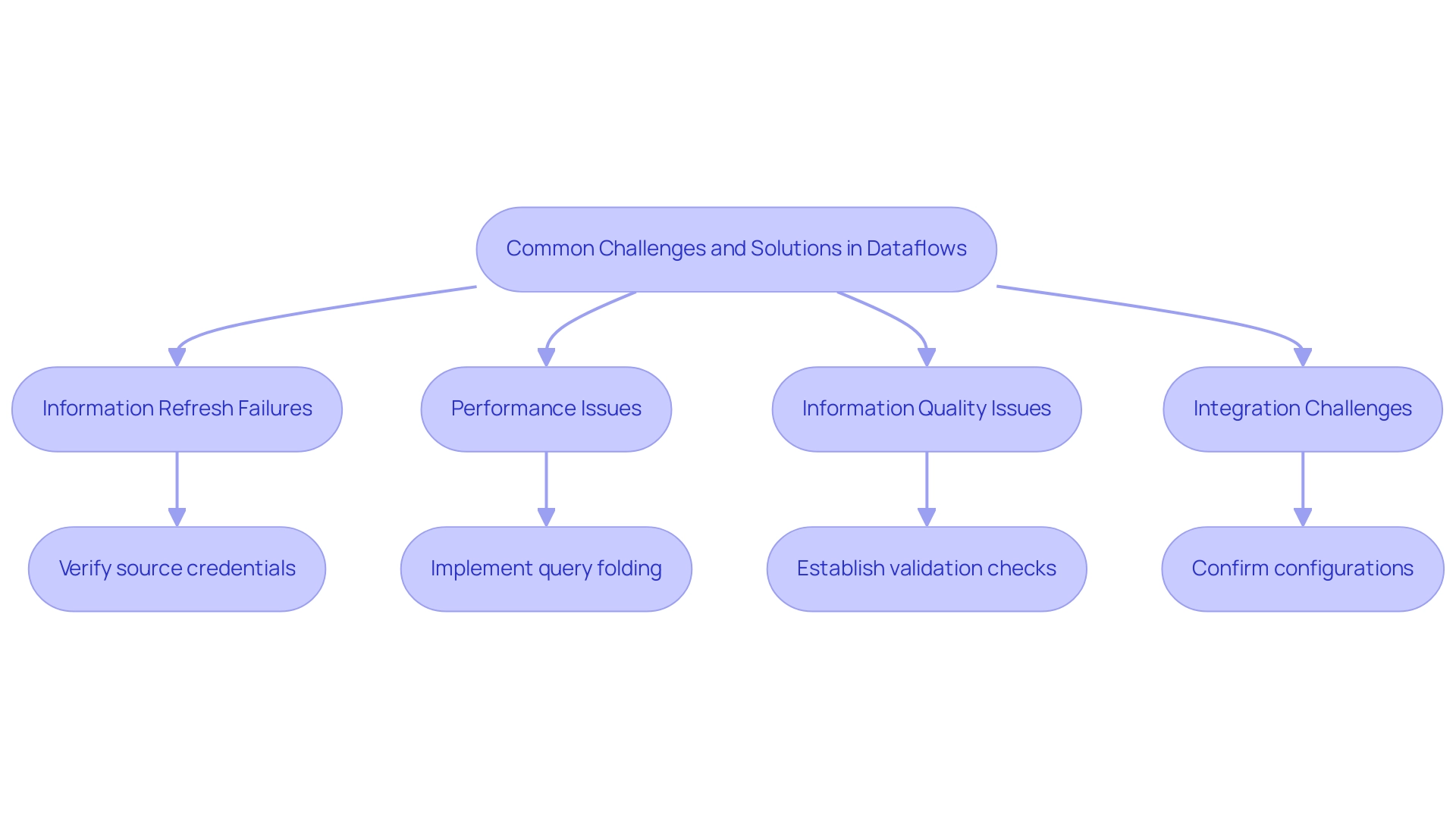
Integrating Dataflows with Other Tools and Services
Integrating various tools and services with dataflows is essential for maximizing your BI experience and driving data-driven decisions, especially during our 3-Day BI Sprint. Here are key integrations to consider:
- Azure Data Services: Utilize Azure Data Factory (ADF) to orchestrate information movement and transformations before loading into Power BI.
This cloud-based service streamlines the extraction, transformation, and loading (ETL) processes, accommodating complex information integration scenarios. By utilizing ADF, you acquire a scalable solution that facilitates seamless cloud migrations and improves your overall information architecture. Harness the automation tool to streamline workflows involving flows, such as triggering refreshes or sending notifications when updates occur.
As noted by Ben Sack, a Program Manager,
These new features free valuable time and resources previously spent extracting and unifying information from different sources, enabling your team to focus on turning information into actionable insights.
This automation enhances efficiency and enables your team to obtain valuable insights from the information, especially during the intensive 3-Day BI Sprint.
-
Common Data Service: Integrating with the Common Data Service enhances information management across multiple applications, ensuring a cohesive approach to handling your assets.
-
Third-party Connectors: Utilize the diverse range of connectors available in BI to import information from external sources, creating a comprehensive ecosystem that enhances your analytics capabilities.
-
Creatum’s Comprehensive Solutions: Keep in mind that Creatum provides customized frameworks and extensive solutions tailored to fulfill your distinct business needs for analytics-driven success, especially through our 3-Day BI Sprint.
As we approach 2024, while you strive to combine BI processes with Azure services, it’s essential to acknowledge that a minimum of 100 rows of historical information is necessary for effective regression model analysis, guaranteeing your predictive insights are strong and trustworthy. Additionally, the support for incremental refresh in Power BI datasets and dataflows further optimizes your data handling capabilities, which necessitates Power BI Premium and a datetime field in the result set.
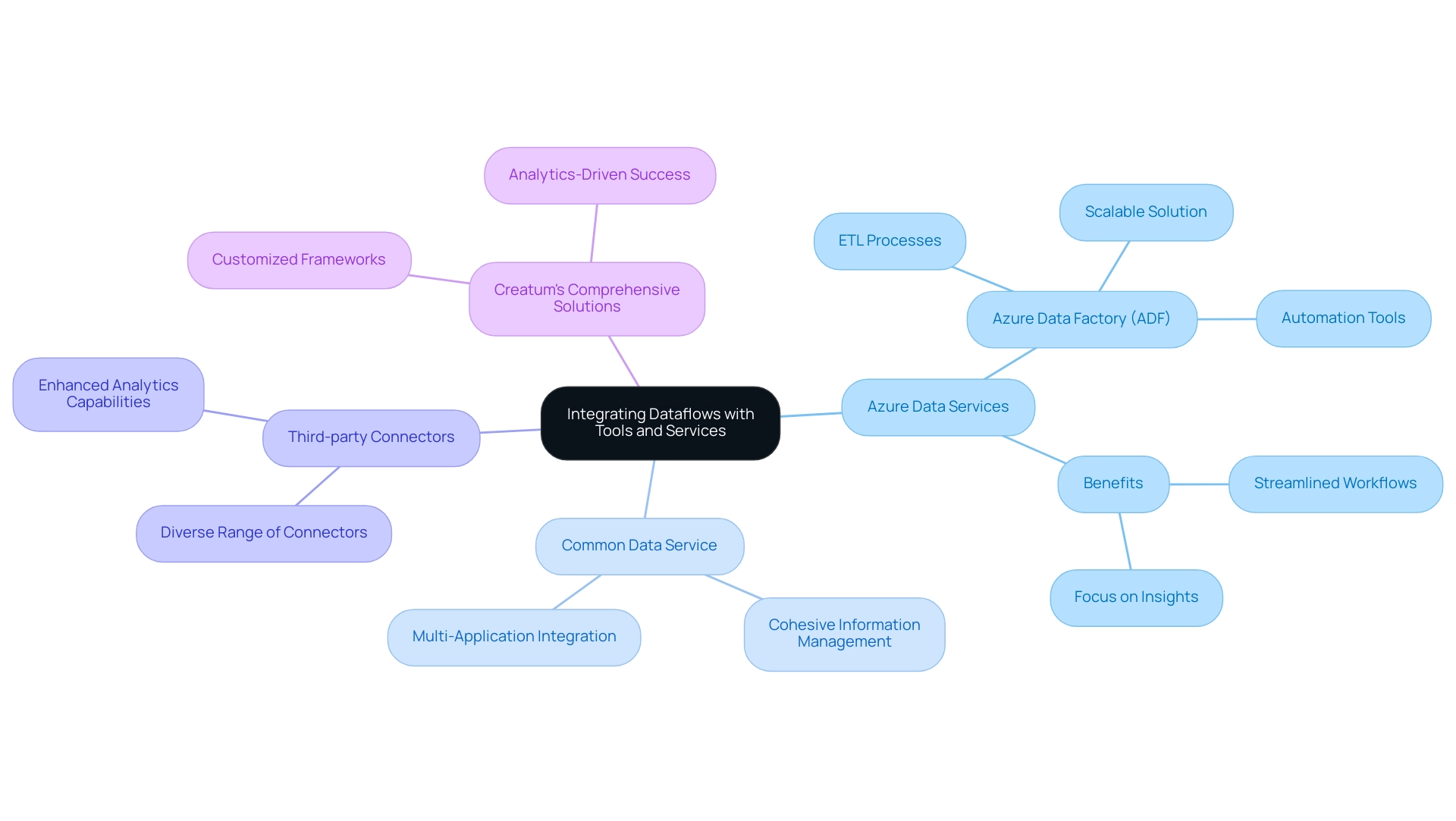
Conclusion
Harnessing the full potential of Power BI dataflows can significantly transform an organization’s data management and reporting processes. By understanding and implementing the foundational aspects of dataflows, businesses can streamline their data integration efforts, reduce redundancy, and foster collaboration among teams. The step-by-step guide provided illustrates how to create effective dataflows, ensuring that users can navigate the complexities of data integration with confidence.
Moreover, adopting best practices such as:
- Keeping dataflows simple
- Utilizing incremental refresh
- Maintaining thorough documentation
can optimize performance and enhance operational efficiency. Addressing common challenges, including data refresh failures and quality issues, with proactive solutions ensures that organizations can maintain reliable data for informed decision-making.
Integrating dataflows with other tools and services, such as Azure Data Services and Power Automate, further amplifies the capabilities of Power BI, enabling teams to automate workflows and focus on deriving actionable insights. As organizations continue to embrace data-driven strategies, mastering Power BI dataflows will be a key differentiator in enhancing competitiveness and driving growth in a rapidly evolving landscape.
